France
Paris
Welcome to
Luxury brands face several design challenges that require them to balance their commitment to craftsmanship, aesthetics, and innovation with changing consumer preferences and market trends. One of the most significant challenges is maintaining exclusivity and uniqueness while also reaching broader audiences. To address this obstacle, luxury brands must find ways to create products that are exclusive and accessible, such as developing limited edition products or offering personalized customization options.
Another challenge is staying at the forefront of design and innovation while maintaining the brand heritage. Luxury brands must be mindful of the fact that their products often carry a rich history and cultural significance, which must be reflected in the design process. At the same time, they must also embrace emerging technologies and design practices to stay relevant and competitive.
Luxury brands face several design challenges that require them to balance their commitment to craftsmanship, aesthetics, and innovation with changing consumer preferences and market trends. One of the most significant challenges is maintaining exclusivity and uniqueness while also reaching broader audiences. To address this obstacle, luxury brands must find ways to create products that are both exclusive and accessible, such as developing limited edition products or offering personalized customization options.
Another challenge is staying at the forefront of design and innovation while maintaining the brand heritage. Luxury brands must be mindful of the fact that their products often carry a rich history and cultural significance, which must be reflected in the design process. At the same time, they must also embrace emerging technologies and design practices to stay relevant and competitive.
In a long-term partnership with the luxury group LVMH and video game/software developer Epic Games, Fendi, part of the LVMH group, is creates a unique customer experience by introducing 3D technology into its boutiques for bespoke creations. Leveraging Epic Games‘ Unreal Engine 5 3D design solution, select boutiques will offer their clientele hyper-realistic previews of customized products on screens. This new service aims at ultra-personalization, optimizing consumer engagement and satisfaction by involving them directly in the creation process. This experience not only enhances customer relationships but also provides a privileged and memorable experience.
Credits: Fendi
In a long-term partnership with the luxury group LVMH and video game/software developer Epic Games, Fendi, part of the LVMH group, creates a unique customer experience by introducing 3D technology into its boutiques for bespoke creations. Leveraging Epic Games‘ Unreal Engine 5 3D design solution, select boutiques will offer their clientele hyper-realistic previews of customized products on screens. This new service aims at ultra-personalization, optimizing consumer engagement and satisfaction by involving them directly in the creation process. This experience not only enhances customer relationships but also provides a privileged and memorable experience.
Credits: Fendi
Credits: Fendi
In a long-term partnership with the luxury group LVMH and video game/software developer Epic Games, Fendi, part of the LVMH group, is creating a unique customer experience by introducing 3D technology into its boutiques for bespoke creations. Leveraging Epic Games‘ Unreal Engine 5 3D design solution, select boutiques will offer their clientele hyper-realistic previews of customized products on screens. This new service aims at ultra-personalization, optimizing consumer engagement and satisfaction by involving them directly in the creation process. This experience not only enhances customer relationships but also provides a privileged and memorable experience.
Credits: Fendi
Augmented Reality (AR), with a market value expected to reach $88.4 billion by 2026, is a technology that allows designers to innovate by creating 3D models. This technology has the potential to revolutionize the shopping experience by offering personalized and engaging interactions, such as virtual product try-ons before making a purchase.
When fully utilized, retailers can harness AR to achieve business objectives. According to a Deloitte report, 71% of shoppers would likely shop more frequently when using AR-powered apps. Moreover, 40% of consumers are willing to pay more if they’re able to test a product in AR.
Augmented Reality (AR), with a market value expected to reach $88.4 billion by 2026, is a technology that allows designers to innovate by creating 3D models. This technology has the potential to revolutionize the shopping experience by offering personalized and engaging interactions, such as virtual product try-ons before making a purchase.
When fully utilized, retailers can harness AR to achieve business objectives. According to a Deloitte report, 71% of shoppers would likely shop more frequently when using AR-powered apps. Moreover, 40% of consumers are willing to pay more if they’re able to test a product in AR.
Credits: SnapInc
Cartier‘s collaboration with Snapchat exemplifies how a luxury brand can benefit from augmented reality technology to elevate customer engagement. Through this partnership, Cartier enabled the public to virtually try on their Trinity rings. The lens uses machine learning to accurately predict the 3D shape of each user’s hand, ensuring a personalized experience. Previously, the French luxury house had collaborated with Snapchat to create a similar experience around the Tank Française watch. These initiatives not only enhance the customer experience but also reinforce Cartier’s brand identity as a pioneer in luxury and innovation.
Credits: SnapInc
Cartier‘s collaboration with Snapchat exemplifies how a luxury brand can benefit from augmented reality technology to elevate customer engagement. Through this partnership, Cartier enabled the public to virtually try on their Trinity rings. The lens uses machine learning to accurately predict the 3D shape of each user’s hand, ensuring a personalized experience. Previously, the French luxury house had collaborated with Snapchat to create a similar experience around the Tank Française watch.
These initiatives not only enhance the customer experience but also reinforce Cartier’s brand identity as a pioneer in luxury and innovation.
Cartier’s collaboration with Snapchat exemplifies how a luxury brand can benefit from augmented reality technology to elevate customer engagement. Through this partnership, Cartier enabled the public to virtually try on their Trinity rings. The lens uses machine learning to accurately predict the 3D shape of each user’s hand, ensuring a personalized experience. Previously, the French luxury house had collaborated with Snapchat to create a similar experience around the Tank Française watch. These initiatives not only enhance the customer experience but also reinforce Cartier’s brand identity as a pioneer in luxury and innovation.
Credits: SnapInc
The metaverse, a rapidly growing virtual world, offers an immersive experience where individuals interact with people, products, and places through avatars. This digital realm includes virtual marketplaces where users can buy and sell goods, services, and experiences, providing brands with a unique platform to express their identities and craft differentiated experiences. Analysts project that the market for virtual luxury goods could soar to USD 50 billion by 2030, highlighting the vast potential of this virtual world.
For brands, the metaverse represents a new frontier to cultivate long-term customer relationships rather than focusing on short-term gains. Luxury brands can leverage this virtual world to offer experiences that transcend physical limitations, enhancing consumer loyalty and driving new revenue streams.
The metaverse, a rapidly growing virtual world, offers an immersive experience where individuals interact with people, products, and places through avatars. This digital realm includes virtual marketplaces where users can buy and sell goods, services, and experiences, providing brands with a unique platform to express their identities and craft differentiated experiences. Analysts project that the market for virtual luxury goods could soar to USD 50 billion by 2030, highlighting the vast potential of this virtual world.
For brands, the metaverse represents a new frontier to cultivate long-term customer relationships rather than focusing on short-term gains. Luxury brands can leverage this virtual world to offer experiences that transcend physical limitations, enhancing consumer loyalty and driving new revenue streams.
The use of this tool by prestigious shopping centers like Printemps and iconic luxury brands such as Tiffany & Co., Gucci and Givenchy, illustrates its potential. For instance, Givenchy has embraced the metaverse by partnering with Roblox to create an interactive virtual world. This space features a dance floor, ice rink, and virtual makeup area where visitors can engage in challenges and win branded products. These brands utilize the metaverse to enhance customer experiences and engage their audiences in innovative ways, adapting to new buying patterns and showcasing the vast opportunities for growth and connection in this dynamic digital landscape.
Credits: Givenchy Beauty IG Account
The use of this tool by prestigious shopping centers like Printemps and iconic luxury brands such as Tiffany & Co., Gucci and Givenchy, illustrates its potential. For instance, Givenchy has embraced the metaverse by partnering with Roblox to create an interactive virtual world. This space features a dance floor, ice rink, and virtual makeup area where visitors can engage in challenges and win branded products.
These brands utilize the metaverse to enhance customer experiences and engage their audiences in innovative ways, adapting to new buying patterns and showcasing the vast opportunities for growth and connection in this dynamic digital landscape.
Credits: Givenchy Beauty IG Account
The use of this tool by prestigious shopping centers like Printemps and iconic luxury brands such as Tiffany & Co., Gucci and Givenchy, illustrates its potential. For instance, Givenchy has embraced the metaverse by partnering with Roblox to create an interactive virtual world. This space features a dance floor, ice rink, and virtual makeup area where visitors can engage in challenges and win branded products.
Credits: Givenchy Beauty IG Account
These brands utilize the metaverse to enhance customer experiences and engage their audiences in innovative ways, adapting to new buying patterns and showcasing the vast opportunities for growth and connection in this dynamic digital landscape.
The metaverse is neither the only nor the most popular tool for adopting the codes of the digital landscape. Gaming has become more than just a trend; it is now an integral part of consumer habits.
Today, gaming is the leading cultural industry. It is as much a part of our cultural references and heritage as music, comics, cinema, and so on.
– Marie Bories, Director of Research and Marketing, Webedia Group
The central place of gaming in daily life makes it essential for luxury brands to quickly integrate their codes to reach a young audience, which is expected to make 25 to 30% of luxury purchases by 2030.
A study conducted by Dynata for Webedia among a sample of 1,005 respondents aged 18 and over found that 66% of 18-34 year olds believe that integrating the gaming universe is a good idea for brands outside this universe. They see it as beneficial for making a product known (40%), recruiting new clients and/or rejuvenating a consumer base (35%), increasing sales (28%), and enhancing a product’s attractiveness (24%).
The expanding role of the gaming universe as a powerful medium is exemplified by the initiatives of numerous luxury brands such as Cartier, Burberry, Louis Vuitton, Hermès, Gucci, Dolce & Gabbana, and many more. For instance, Cartier introduced “The Fabulous Cartier Journey,” an interactive video game as part of its “The Fabulous Cartier House” end-of-year campaign, aimed at enhancing storytelling and engagement with its audience. On the other hand, Dolce & Gabbana collaborated with video game specialist Razer to create a collection of clothing and equipment dedicated to gaming, while Tiffany partnered with Pokémon to launch an exclusive collection of necklaces. These examples showcase the various ways in which luxury brands are tapping into the gaming universe to connect with younger audiences and adapt to current consumer habits.
The metaverse is neither the only nor the most popular tool for adopting the codes of the digital landscape. Gaming has become more than just a trend; it is now an integral part of consumer habits.
Today, gaming is the leading cultural industry. It is as much a part of our cultural references and heritage as music, comics, cinema, and so on.
– Marie Bories, Director of Research and Marketing, Webedia Group
The central place of gaming in daily life makes it essential for luxury brands to quickly integrate their codes to reach a young audience, which is expected to make 25 to 30% of luxury purchases by 2030.
A study conducted by Dynata for Webedia among a sample of 1,005 respondents aged 18 and over found that 66% of 18-34 year olds believe that integrating the gaming universe is a good idea for brands outside this universe. They see it as beneficial for making a product known (40%), recruiting new clients and/or rejuvenating a consumer base (35%), increasing sales (28%), and enhancing a product’s attractiveness (24%).
The expanding role of the gaming universe as a powerful medium is exemplified by the initiatives of numerous luxury brands such as Cartier, Burberry, Louis Vuitton, Hermès, Gucci, Dolce & Gabbana, and many more. For instance, Cartier introduced “The Fabulous Cartier Journey“, an interactive video game as part of its “The Fabulous Cartier House” end-of-year campaign, aimed at enhancing storytelling and engagement with its audience. On the other hand, Dolce & Gabbana collaborated with video game specialist Razer to create a collection of clothing and equipment dedicated to gaming, while Tiffany partnered with Pokémon to launch an exclusive collection of necklaces. These examples showcase the various ways in which luxury brands are tapping into the gaming universe to connect with younger audiences and adapt to current consumer habits.
Credits: Razer
Credits: The Fabulous Cartier Journey
Credits: Razer and The Fabulous Cartier Journey
The new opportunities of design present new avenues for luxury brands to innovate and differentiate themselves in the market while maintaining their commitment to exclusivity, craftsmanship, and tradition. By leveraging these new technologies and practices, luxury brands can create personalized and immersive experiences that resonate with consumers and establish strong brand identities that stand the test of time.
The new opportunities of design present new avenues for luxury brands to innovate and differentiate themselves in the market while maintaining their commitment to exclusivity, craftsmanship, and tradition. By leveraging these new technologies and practices, luxury brands can create personalized and immersive experiences that resonate with consumers and establish strong brand identities that stand the test of time.
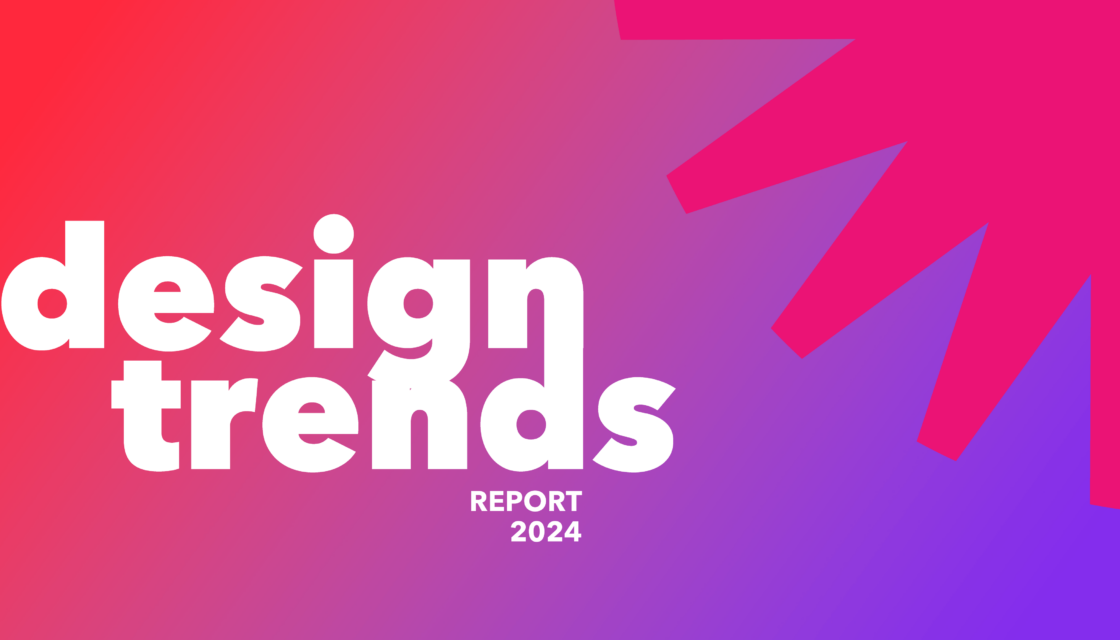
To discover more trends, download right now our 2024 Useful Design Trends report.

To discover more trends, download right now our 2024 Useful Design Trends report.
Did you know that on average, a household throws away 25 single-use plastic bottles of hand soap a year, most of which are not recycled?
The beauty and cosmetics industry has been in the spotlight for the past decade; sustainability criteria and new generations of consumers demand a radical change in packaging policies. What if our favorite products disappeared after use… along with their packaging?
Water-soluble packaging, edible packaging… they all have the same purpose (and fate): enemies of single-use packaging, they’re meant to disappear! This innovative initiative, led by committed startups, offers an ecological solution to reduce plastic waste across all sectors. Designed to completely dissolve in water, soluble packaging eliminates the need to dispose of non-biodegradable materials, thus reducing the environmental footprint.
Soluble packaging is already a reality. According to Insight Ace Analytic, the global soluble packaging market was estimated at $3.39 billion in 2023 and is expected to reach $6.06 billion by 2031. This technology has already found its place in the food sector. How can we package water without leaving an impact on the planet?
NotPla, the startup behind algae and plant-based packaging, believes it has found a solution with its Ohoo range: water in the form of an edible blob. You basically eat your drink.
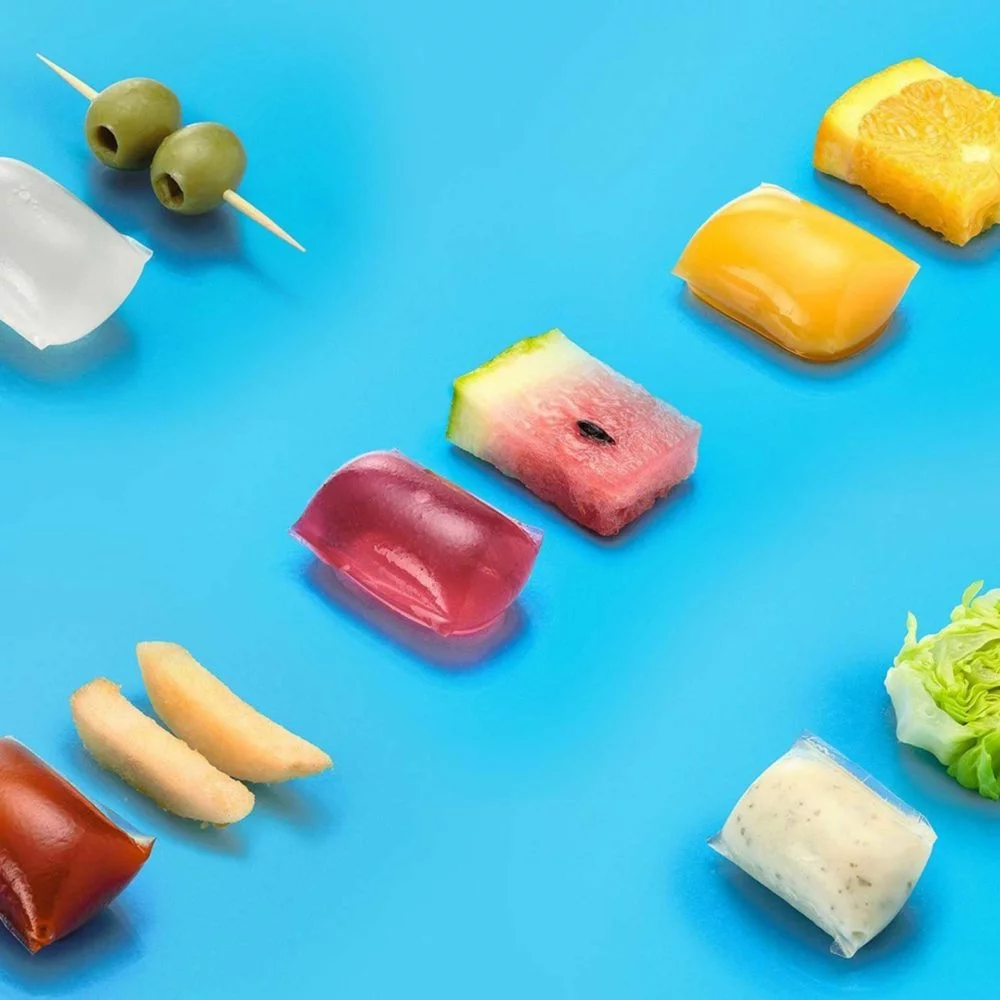
Credit : NotPla
And… what about beauty and cosmetics? Soluble packaging is gradually being integrated into all categories. From shower gels to hair care, makeup, body and hand soaps, cleansers, masks, creams… by expanding into consumer goods, all categories are affected. Several successful startups have already adopted soluble packaging as a competitive advantage. Let’s discover this trend together.
How to reconcile the desire to consume with the need for sustainability? Soluble packaging is an ideal solution for Generation Z. By offering products in single doses in packaging that dissolves in water, this innovation helps reduce waste. Gen Z, conscious consumer-actors, thus favor more sustainable options while maintaining their comfort, a smart compromise between consuming and preserving the environment.
INVISIBLEBAG, a soluble packaging provider, enables manufacturers and brands to replace conventional plastic packaging with compostable, biodegradable packaging without harmful residue on land.
How to reconcile the desire to consume with the need for sustainability? Soluble packaging is an ideal solution for Generation Z. By offering products in single doses in packaging that dissolves in water, this innovation helps reduce waste. Gen Z, conscious consumer-actors, thus favor more sustainable options while maintaining their comfort, a smart compromise between consuming and preserving the environment.
INVISIBLEBAG, a soluble packaging provider, enables manufacturers and brands to replace conventional plastic packaging with compostable, biodegradable packaging without harmful residue on land.
Reducing plastic waste is an unavoidable challenge for the beauty and cosmetics industry. From conception to disappearance, soluble packaging reduces the carbon footprint of our products, thus demonstrating our commitment to sustainability. We can FINALLY enjoy our well-being routine without feeling guilty.
Clean Circle, an engaged cosmetics brand, has created water-soluble eye patches after use. Deardot, on the other hand, has developed solid sheets that transform into cleansers after being moistened, all in a soluble bag that dissolves in the sink in… 5 seconds!
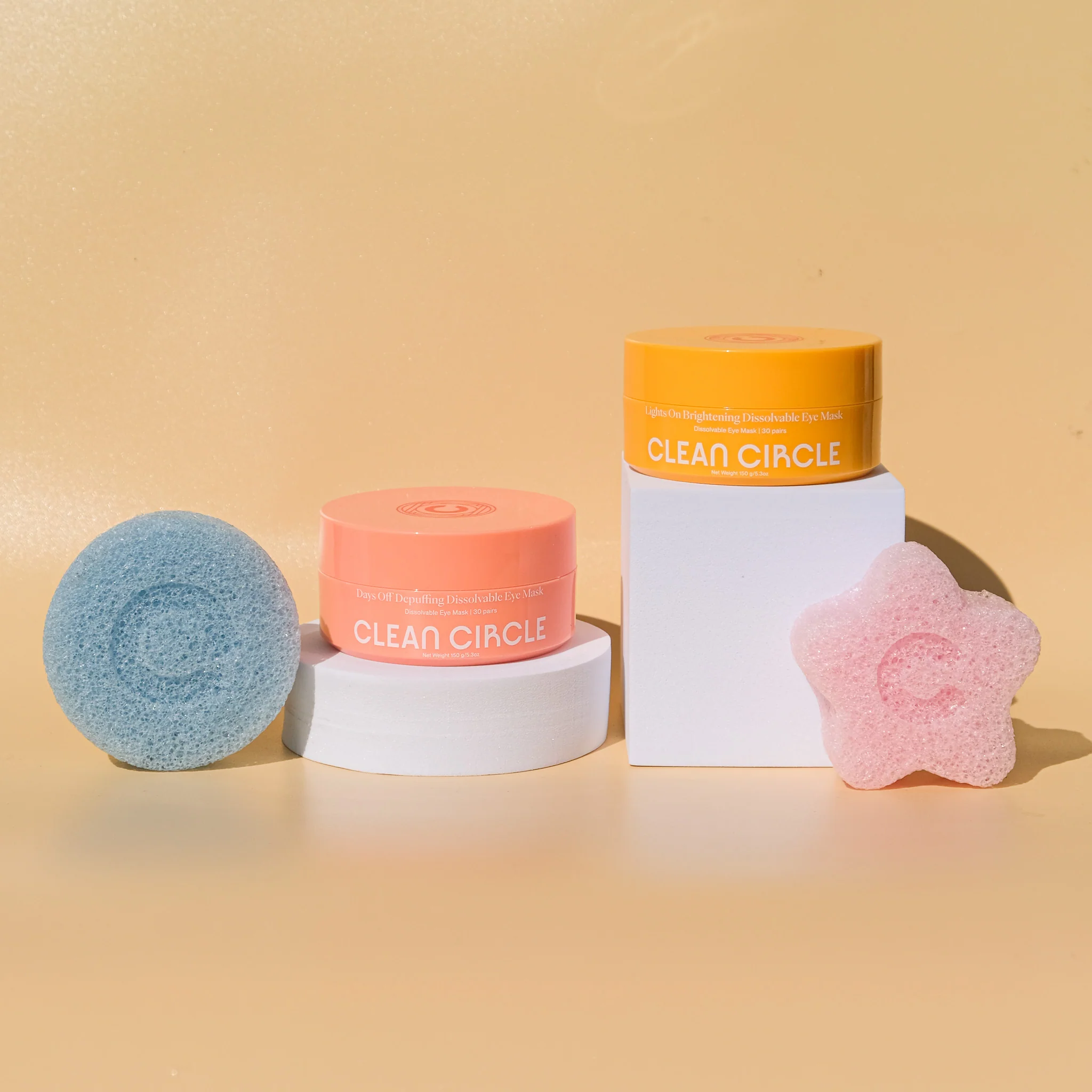
Credit : Clean Circle
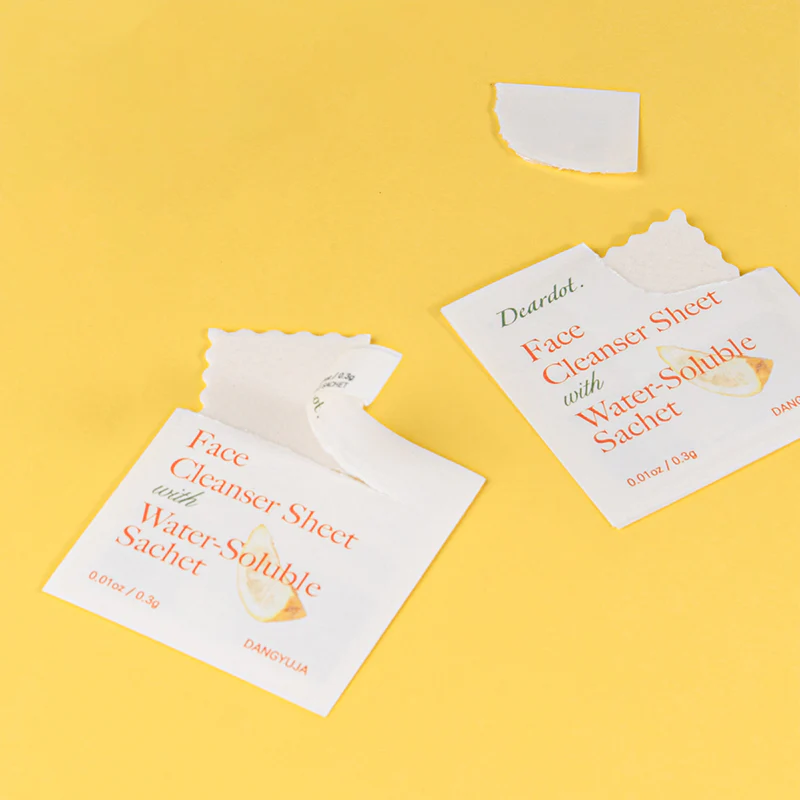
Credit : Deardot
One of the soluble packaging’s best friends is the soluble ingredient (bestie check!) The latter refers to solid formulations that, once moistened, take their final usable form. Solid formulations offer appreciable benefits in terms of stability, allowing high concentrations of active ingredients, resulting in a better user experience for customers.
Let’s focus on shower gels. The principle is both simple and ingenious: instead of regularly buying traditional bottles, which contain a large amount of water and are packaged in disposable plastic packaging, consumers can now opt for a format of shower gel in solid active ingredient. The latter comes in the form of bars that can be dissolved in water at home to reform the liquid shower gel. Refill, moisten and shake it off! It’s also a moment of entertainment and learning for children, Do It Yourself-wise. Your kids (and the planet) will thank you later.
Forgo, a Swedish cosmetics brand, has developed an effective solution to eliminate plastic: a refillable glass bottle and plastic-free paper refills to make hand soap. Just pour the refill powder into the bottle, add water, and shake (a Mojito, please)! Each refill means no plastic bottle and up to 85% fewer greenhouse gas emission.
From self-care to household products, 900.care has already conquered the French market for refillable products. Having raised 21 million euros in April 2024, the startup continues its revolution within households.
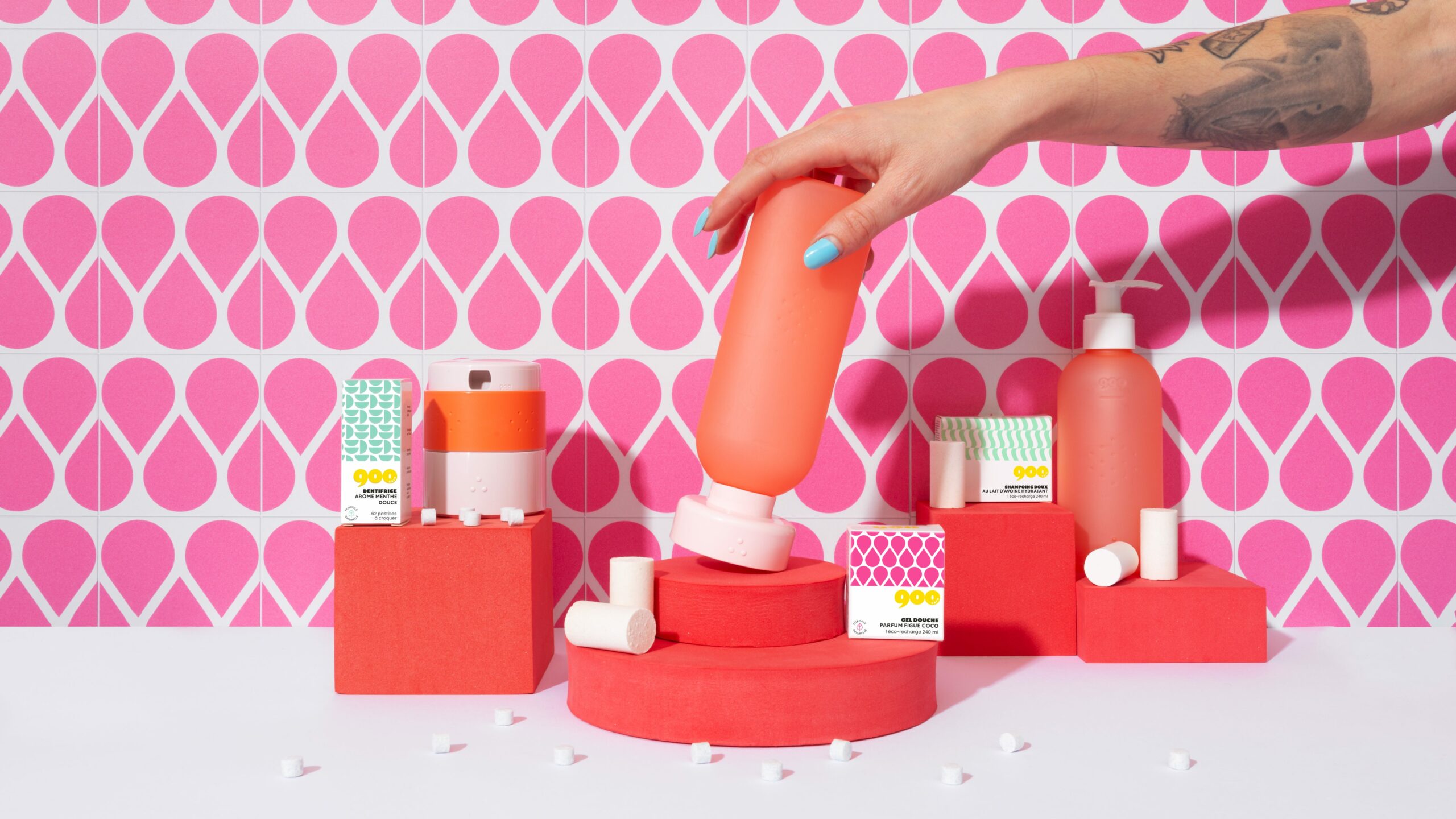
Credit : 900.care
In 2024, soluble packaging is no longer a miracle solution; it is now a reality that addresses many sustainability challenges in the industry. Between consumption needs and global concerns, it fully meets the expectations of a new generation of consumers. Perhaps it is the lever you need for your next launch? You too, take the step towards change.
To discover more trends, download right now our 2024 Useful Design Trends report.
In today’s world, social connection is more important than ever, especially post-pandemic. Citizens, specifically Generation Z, are increasingly craving real-life social interactions and experiences. This shift in consumer behavior has had a profound impact on the retail landscape.
As physical retail gains momentum once again, brands are reevaluating the undeniable importance of brick-and-mortar stores. They are actively seeking ways to elevate brand experiences and create meaningful connections with their customers. This underscores the critical need to stay abreast of current retail design trends and consumer preferences.
Despite having less purchasing power compared to older generations, Gen Z comprises a significant portion of the global population and represents the future consumer base. Their proficiency with the internet and social media not only influences market trends and brand decisions but also plays a pivotal role in shaping the retail landscape.
Gen Z, being digital natives, shows nearly equal engagement with brands in physical stores and online platforms, as evidenced by survey published by ICSC in 2023. Consequently, brands must ensure a seamless path-to-purchase experience in-store that mirrors the online experience while offering tangible benefits to customers visiting physical stores.
In 2023, H&M introduced its first Beauty stores with a design concept inspired by cocktail bars, promising a social scene.
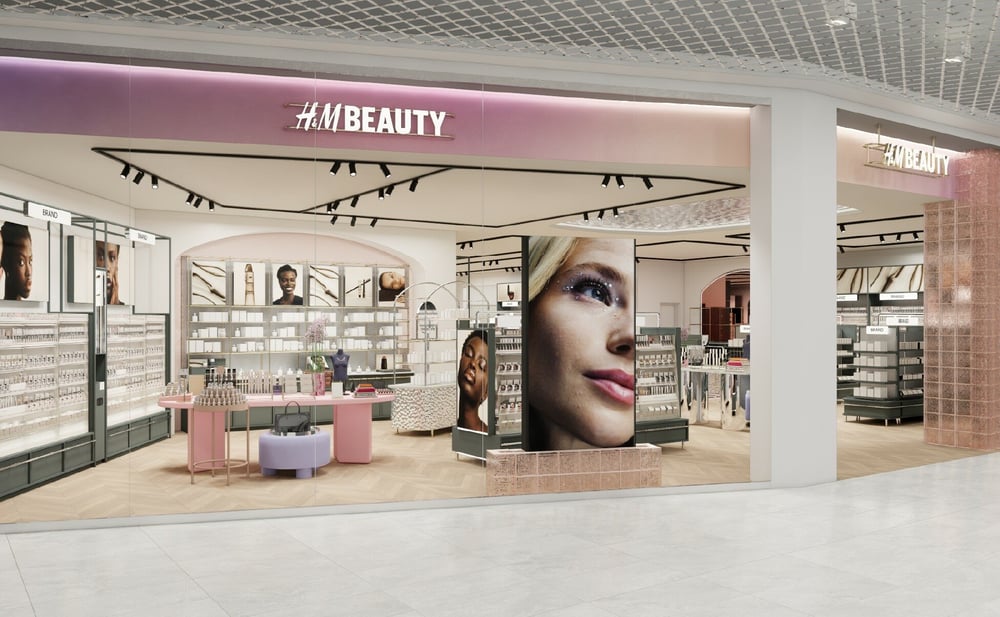
Crédit : Fashion Network et BeautyEQ
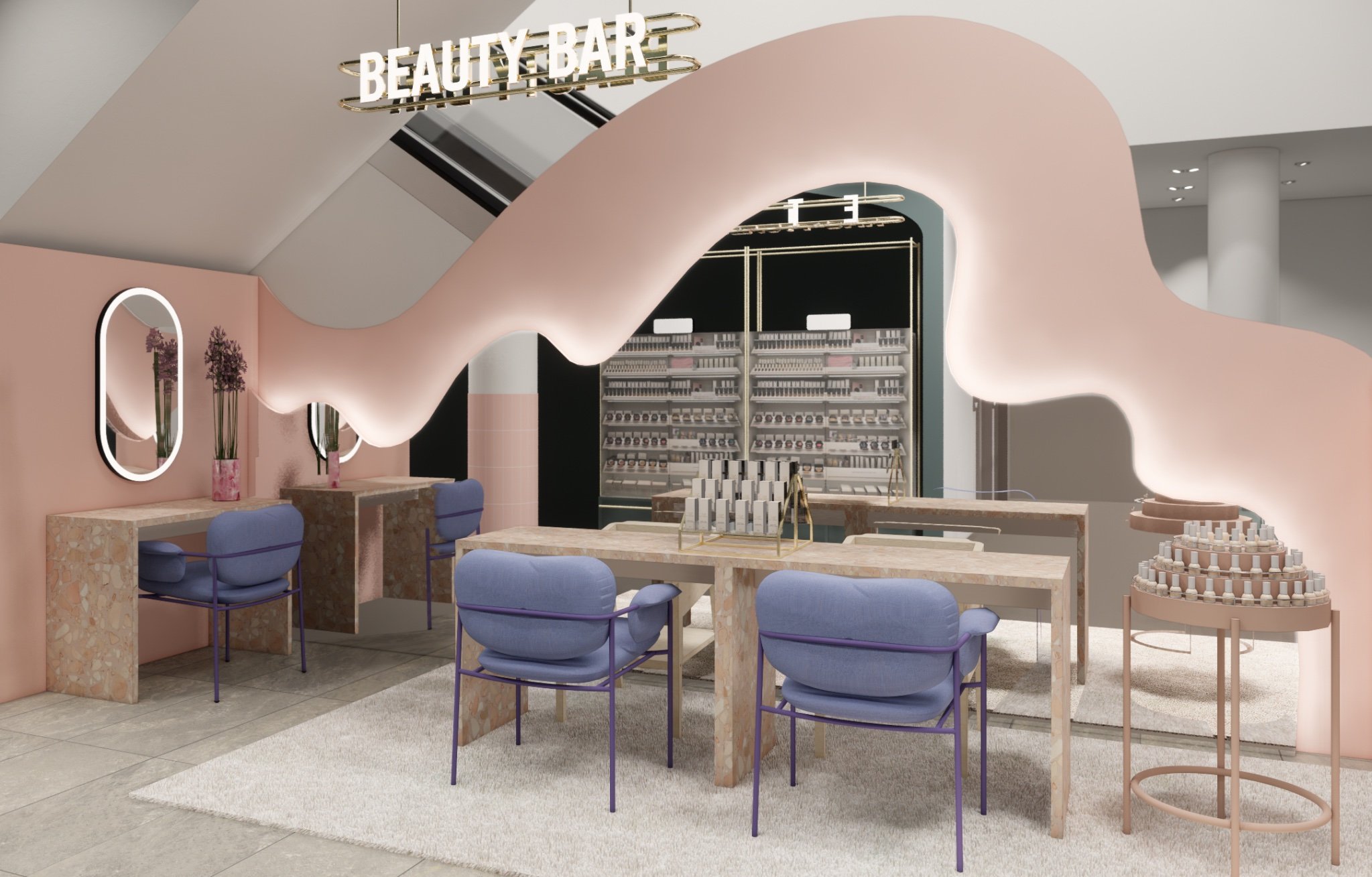
Crédit : Fashion Network et BeautyEQ
Similarly, VALRHONA, exemplifies how brands can leverage retail design to create unique brand experiences for visitors. While the stores feature dedicated sections for their products, the brand also developed a tasting table designed to immerse shoppers in a tasting experience, accompanied by a Valrhona expert.
This approach not only showcases products but also fosters a deeper connection between the brand and its customers, enhancing the overall retail experience.
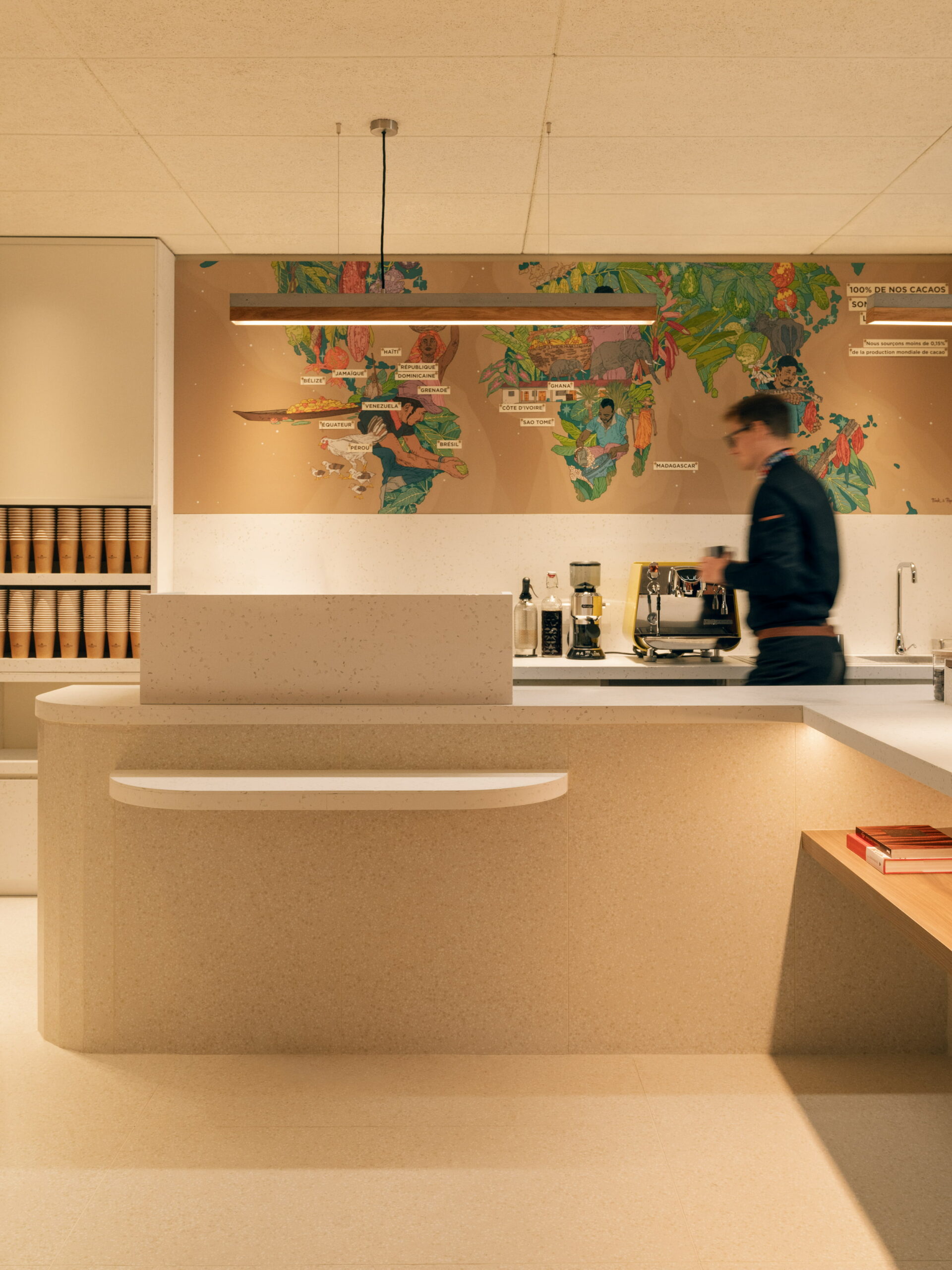
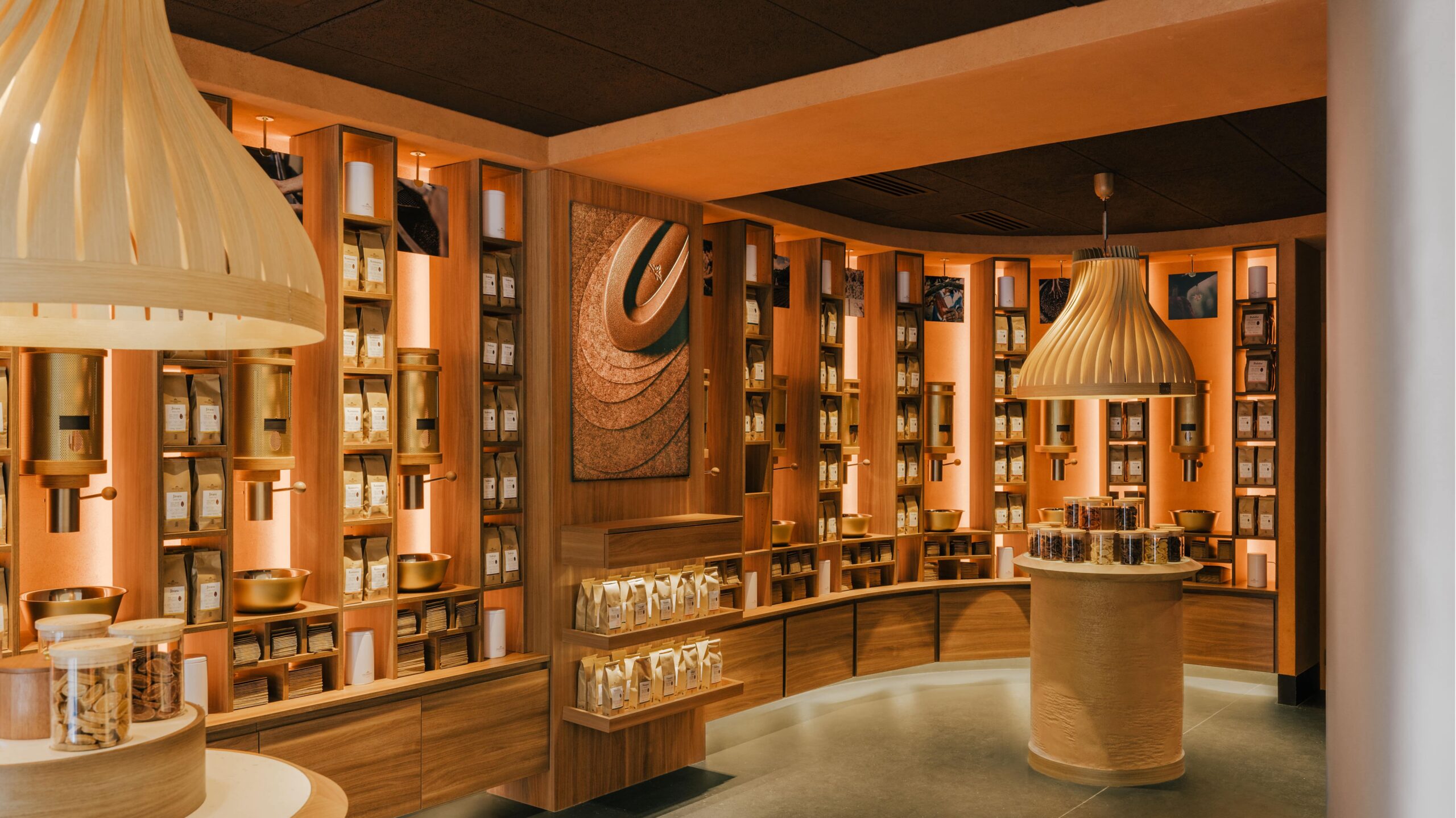
Technology continues to play an increasingly significant role in all aspects of our lives, including retail design. Over the past five years, retailers have embraced technology to elevate customer experiences. According to Stylus’s NFR, Retail’s Big Show 2024 report businesses implementing AI and machine learning have experienced substantial growth in sales (2.3 times) and profits (2.5 times) compared to competitors in 2023.
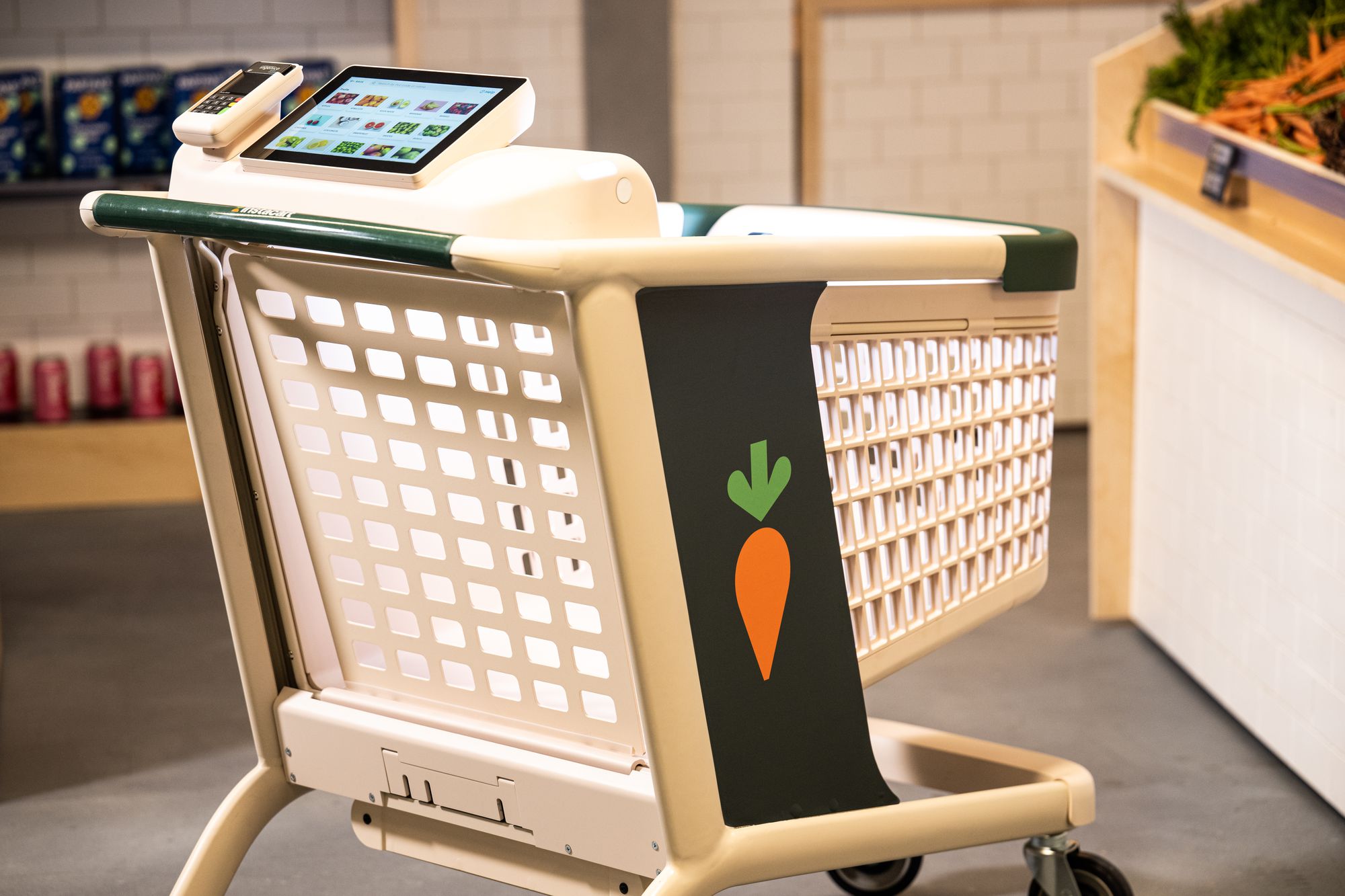
Crédit : The Verge

Crédit : The Verge
In addition to AI, virtual spaces hold significant importance in the retail sector, as exemplified by brands like Adidas. Adidas has tapped into the metaverse trend by launching pop-up shops on Roblox (metaverse gaming environment with pop-up stores), offering digital wearables and accessories tailored for the platform.
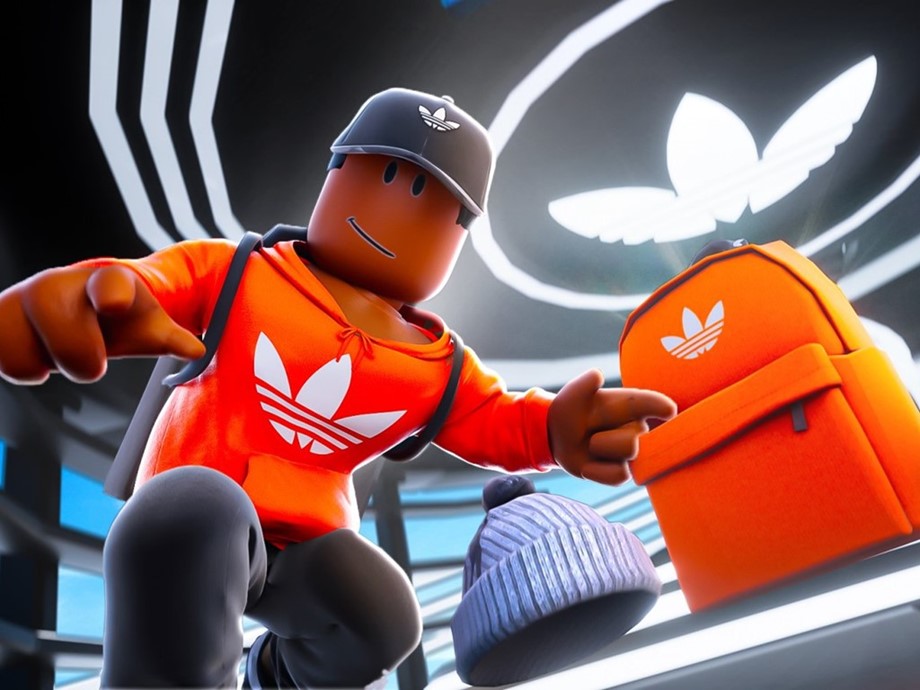
Crédit : Adidas
In addition to AI, virtual spaces hold significant importance in the retail sector, as exemplified by brands like Adidas. Adidas has tapped into the metaverse trend by launching pop-up shops on Roblox (metaverse gaming environment with pop-up stores), offering digital wearables and accessories tailored for the platform.
Moreover, retail design innovations like Colmar‘s new flagship store in Milan showcase how technology can create immersive experiences for customers. The store features multiple LED screens throughout, with a horizontal LED screen spanning the entire shop facade providing real-time forecasts and air quality data. Additionally, an interactive LED floor recreates the visual and acoustic sensations of walking on snow, evoking brands natural habitat.
These technological advancements empower brands to construct a universe where their vision seamlessly intertwines with customer preferences, offering a compelling investment opportunity.
Pop-up shops have become a captivating strategy for brands to attract young consumers. Inspired by the allure of “drop culture,” where limited-release merchandise generates hype and anticipation, brands are increasingly embracing pop-up stores to tap into this phenomenon.
In a market driven by a desire for novelty and sensory experiences, pop-ups can yield significant revenue boosts, often ranging from 20% to 30% more than traditional stores. Recent surveys highlight the success of brands experimenting with pop-ups, showing a 46% increase in sales, a 51% rise in market visibility, and a remarkable 66% boost in brand awareness.
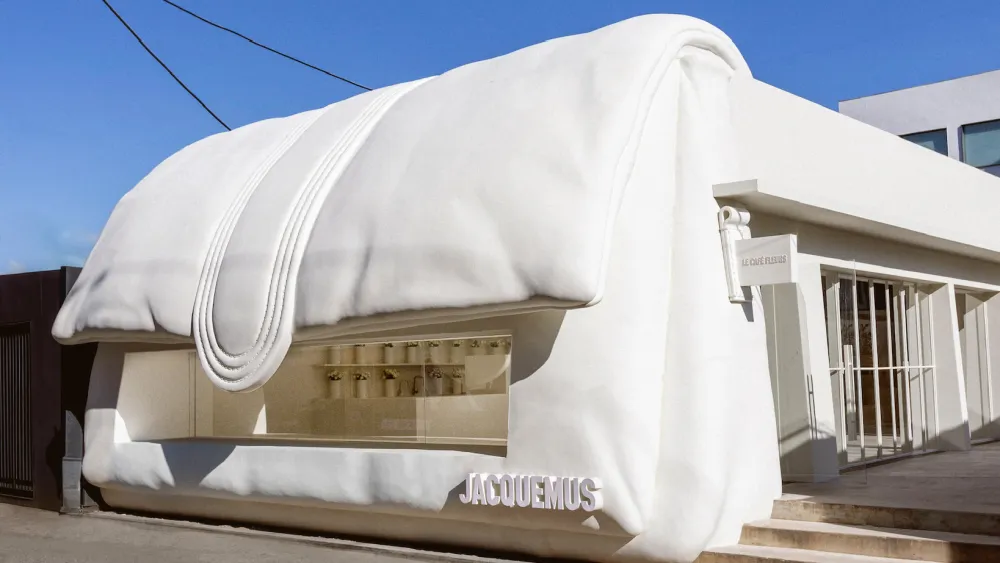
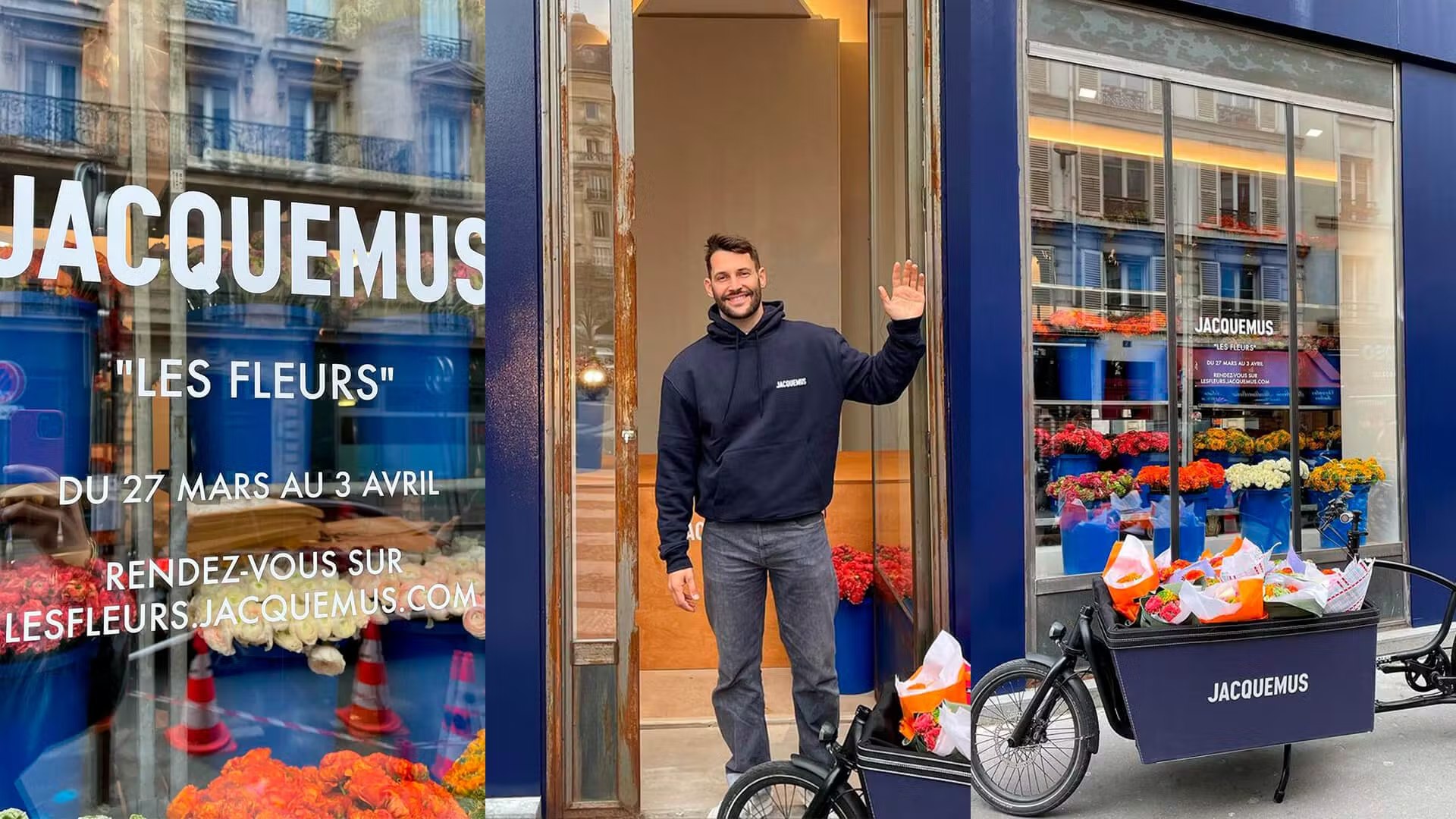
Retail design trends for 2024 highlight the importance of creatively blending experiential and transactional retail elements to foster engaging store visits and establish an authentic connection with consumers. As retailers embrace these trends, from AI integration to pop-up stores, the key to thriving in an ever-changing market lies in maintaining innovation and prioritizing customer-centric approaches.
To discover more trends, download right now our 2024 Useful Design Trends report.
To discover more trends, download right now our 2024 Useful Design Trends report.
To discover more trends, download right now our 2024 Useful Design Trends report.
The latest report published by Stylus highlights the exponential growth of the beauty market, reaching $85 billion by 2024, with make-up leading the way (33% of total sales).
The cosmetics market is constantly evolving, with the emergence of distinct trends: the use of make-up as a means of countering so-called conventional and traditional beauty, and the rise of inclusive and accessible cosmetics, for all.
The arrival of new players is prompting established brands to reinvent themselves and rethink their strategy to stand out. But how? That’s what we’re going to discover!
Consumers are looking for simpler ingredients, but also want to have fun and use cosmetics as a form of self expression.
In the 2024 edition of our Design Trends, we highlighted the « Out of the Box » trend. The new generation is rejecting the dictates of traditional beauty and aspires to greater transparency. They use makeup as a means of expressing their personality and embracing imperfections, without concern for societal judgment.
The idea of « perfection » is challenged, and « imperfection » or what could be perceived as original is brought to the fore.
For now on, authenticity is elevated to the status of perfection.
Brands now offer products that let you play with textures and colors.
Between Laka (Korea) which offers chromatic products that reflect light or Milk Makeup (US) with its Jelly Blush, gelled blushes, brands are encouraging us to use makeup in a playful way and to express our personality!
Credit: Laka and Milk Makeup
Crédit : Fenty Beauty
Talking about originality, let’s take Fenty Beauty as an example.
The brand has launched a palette of 6 highly original red and pink lip glosses, presented in the form of little restaurant sauce sachets, among which is hidden… ketchup. You can either discover the real gloss or come across real ketchup. A brilliant marketing move that has once again showcased the brand’s uniqueness and innovation in the face of its many competitors.
Embrace the strange, experiment, and encourage your target audiences to play with the products to step out of their comfort zone.
The market for men’s beauty products continues to grow, and according to Statista, it is set to reach 105 billion euros by 2028. There are many factors contributing to this surge in the men’s cosmetics.
Social media plays a significant role in the surge of cosmetics dedicated to men. Men now showcase their beauty routines on social media, accumulating billions of views. Men’s cosmetics are brought into the spotlight, allowing these gentlemen to realize both the aesthetic and dermatological benefits.
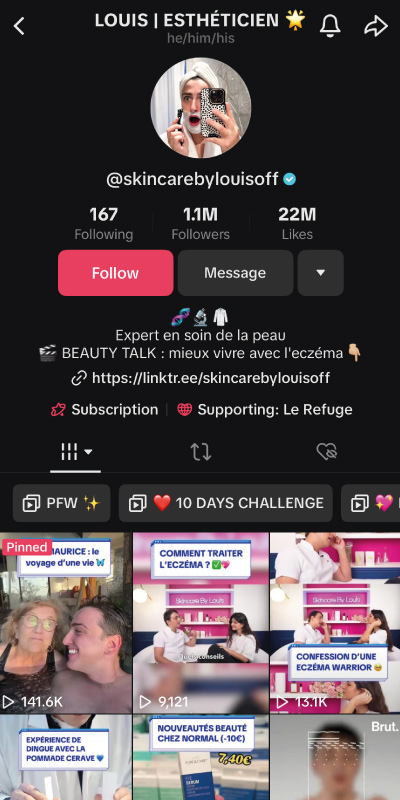
The number of male influencers in this market has been steadily growing since the global pandemic. In the US, Robert Welsh, an American YouTuber with over 1 million subscriber, posts videos featuring make-up tutorials, advice, and brand reviews. In France, Skincarebylouisoff, an influencer mainly active on TikTok with over 1.1 million subscribers, focuses his content on skincare and skin issues.
We’re witnessing an increasing number of men embracing cosmetics, which helps normalize their usage among males.
Famous figures such as Harry Styles and Jared Leto, who don’t hesitate to wear make-up and nail varnish, or Sam Smith, who shows off his beauty routine on Vogue’s Youtube channel, play a crucial role in breaking down these gender stereotypes.
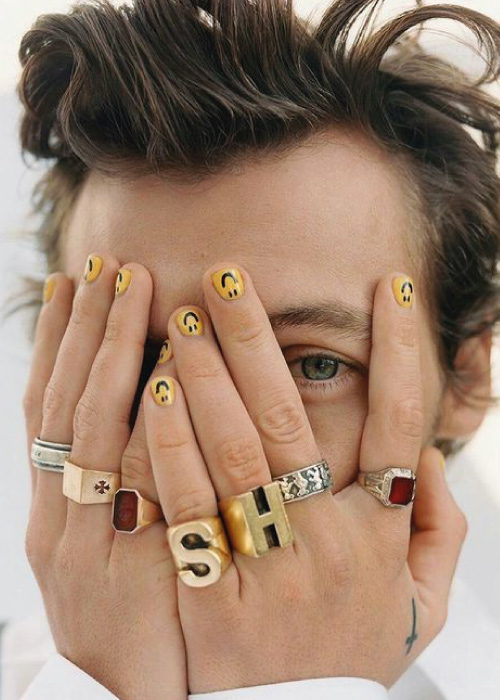
Credit: Jenny Longworth
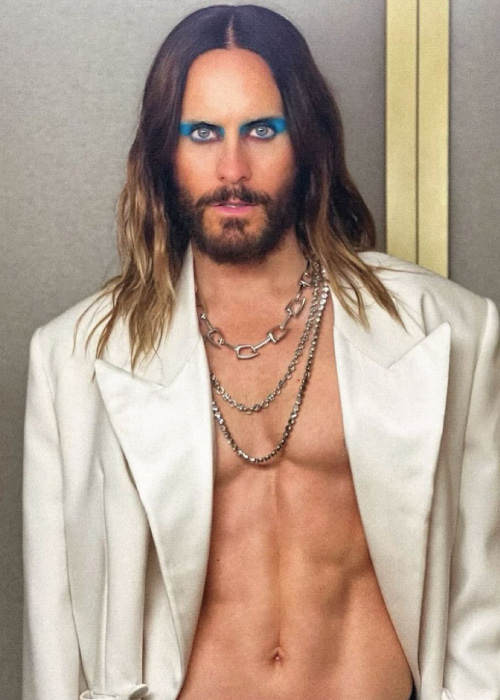
@jaredleto instagram account
@vogue YouTube account
The market is constantly evolving, and more and more men are becoming aware of their skin’s needs and the aesthetics benefits that make-up can provide. Consumers’ habits are changing and evolving!
To all brands, become active participants in this change! It is time for you to respond to this growing demand, while promoting inclusivity in this still highly standardized beauty industry.
One motto? Inclusion.
According to the World Bank, one billion people – 15% of the global population – have a disability. The inclusion of people with disabilities continues to gain ground. They are increasingly being highlighted and “considered” by brands.
We mentioned it in our article on Diversity and Design: many brands denounce the lack of representation in this market
Gucci had chosen to name Ellie Goldstein, who has Down syndrome, as its brand ambassador. Although this choice has helped advance the cause, ‘media’ representation alone is no longer sufficient. Inclusivity must now be embedded in product design.
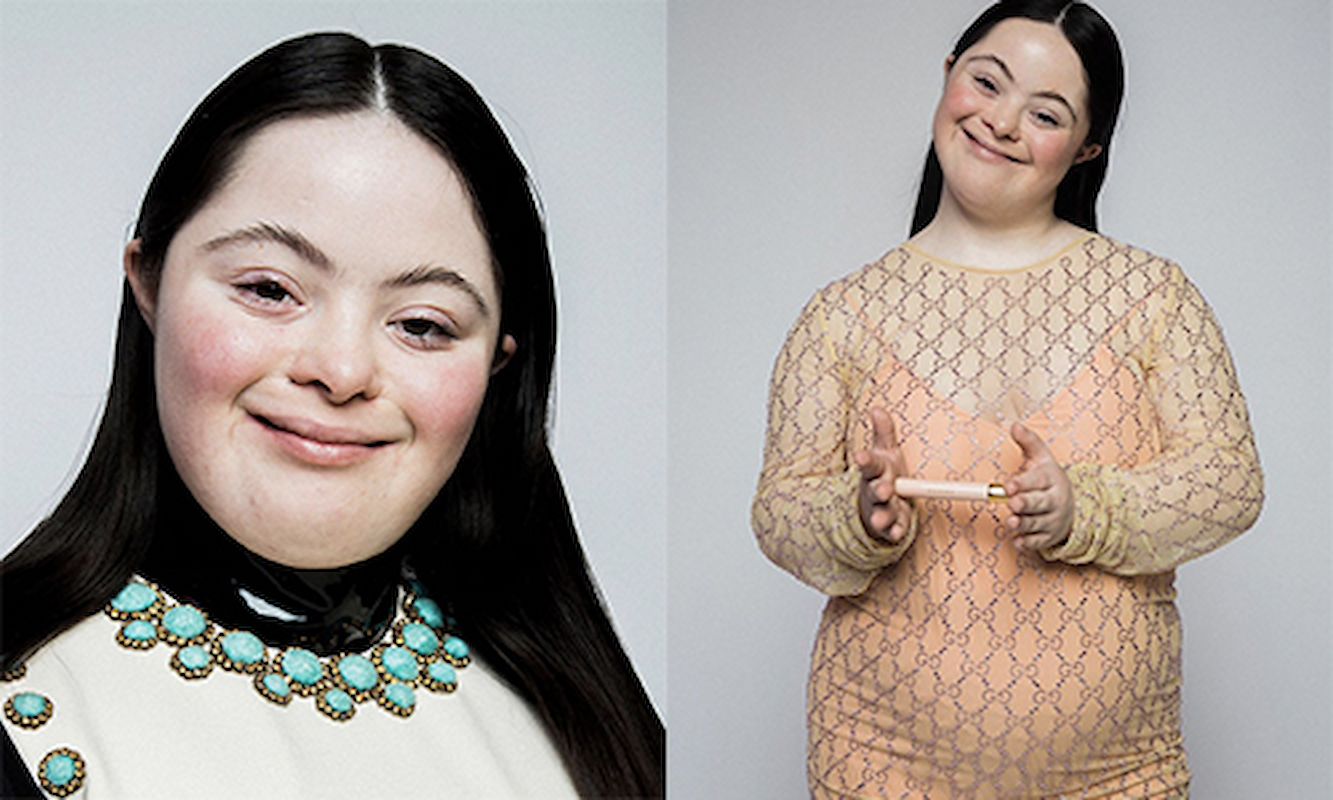
Credits: informations.handicap.fr
The focus is on universal design: creating for everyone, regardless of their unique challenges, be it mobility issues, visual impairments, autism, or tremors associated with Parkinson’s disease.
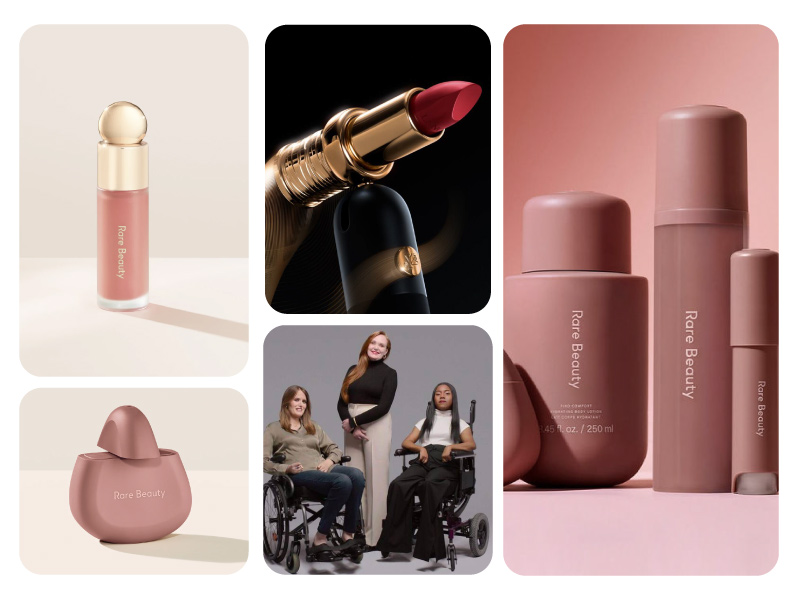
Credits: Rarebeauty.com et Lancôme.fr
Rare Beauty, a makeup brand founded by Selena Gomez who suffers from Lyme disease, was designed for people with physical disabilities. The packaging is ergonomic, with each featuring a ball for easier product opening.
Lancôme, part of L’Oréal Group, presented its Hapta technology at the CES Show in Las Vegas in early 2023: a computerized, portable make-up applicator. This revolutionary device, based on AI, will help people with limited dexterity to apply lipstick or mascara. Through this technology, Lancôme is committed to making beauty inclusive and accessible to all.
Following the life cycle analysis of a product, where the product is carefully thought out and designed to be more sustainable, it must now also be designed to be accessible and inclusive.
To discover more trends, download right now our 2024 Useful Design Trends report.
The latest report published by Stylus highlights the exponential growth of the beauty market, reaching $85 billion by 2024, with make-up leading the way (33% of total sales).
The cosmetics market is constantly evolving, with the emergence of distinct trends: the use of make-up as a means of countering so-called conventional and traditional beauty, and the rise of inclusive and accessible cosmetics, for all.
The arrival of new players is prompting established brands to reinvent themselves and rethink their strategy to stand out. But how? That’s what we’re going to discover!
Consumers are looking for simpler ingredients, but also want to have fun and use cosmetics as a form of self expression.
In the 2024 edition of our Design Trends, we highlighted the « Out of the Box » trend. The new generation is rejecting the dictates of traditional beauty and aspires to greater transparency. They use makeup as a means of expressing their personality and embracing imperfections, without concern for societal judgment.
The idea of « perfection » is challenged, and « imperfection » or what could be perceived as original is brought to the fore.
For now on, authenticity is elevated to the status of perfection.
Brands now offer products that let you play with textures and colors.
Between Laka (Korea) which offers chromatic products that reflect light or Milk Makeup (US) with its Jelly Blush, gelled blushes, brands are encouraging us to use makeup in a playful way and to express our personality!
Credit: Laka and Milk Makeup
Talking about originality, let’s take Fenty Beauty as an example.
The brand has launched a palette of 6 highly original red and pink lip glosses, presented in the form of little restaurant sauce sachets, among which is hidden… ketchup. You can either discover the real gloss or come across real ketchup. A brilliant marketing move that has once again showcased the brand’s uniqueness and innovation in the face of its many competitors.
Embrace the strange, experiment, and encourage your target audiences to play with the products to step out of their comfort zone.
The market for men’s beauty products continues to grow, and according to Statista, it is set to reach 105 billion euros by 2028. There are many factors contributing to this surge in the men’s cosmetics.
Social media plays a significant role in the surge of cosmetics dedicated to men. Men now showcase their beauty routines on social media, accumulating billions of views. Men’s cosmetics are brought into the spotlight, allowing these gentlemen to realize both the aesthetic and dermatological benefits.

The number of male influencers in this market has been steadily growing since the global pandemic. In the US, Robert Welsh, an American YouTuber with over 1 million subscriber, posts videos featuring make-up tutorials, advice, and brand reviews. In France, Skincarebylouisoff, an influencer mainly active on TikTok with over 1.1 million subscribers, focuses his content on skincare and skin issues.
We’re witnessing an increasing number of men embracing cosmetics, which helps normalize their usage among males.
Famous figures such as Harry Styles and Jared Leto, who don’t hesitate to wear make-up and nail varnish, or Sam Smith, who shows off his beauty routine on Vogue’s Youtube channel, play a crucial role in breaking down these gender stereotypes.

Credit: Jenny Longworth

@jaredleto instagram account
@vogue YouTube account
The market is constantly evolving, and more and more men are becoming aware of their skin’s needs and the aesthetics benefits that make-up can provide. Consumers’ habits are changing and evolving!
To all brands, become active participants in this change! It is time for you to respond to this growing demand, while promoting inclusivity in this still highly standardized beauty industry.
One motto? Inclusion.
According to the World Bank, one billion people – 15% of the global population – have a disability. The inclusion of people with disabilities continues to gain ground. They are increasingly being highlighted and “considered” by brands.
We mentioned it in our article on Diversity and Design: many brands denounce the lack of representation in this market

Credits: informations.handicap.fr
Gucci had chosen to name Ellie Goldstein, who has Down syndrome, as its brand ambassador. Although this choice has helped advance the cause, ‘media’ representation alone is no longer sufficient. Inclusivity must now be embedded in product design.
The focus is on universal design: creating for everyone, regardless of their unique challenges, be it mobility issues, visual impairments, autism, or tremors associated with Parkinson’s disease.

Credits: Rarebeauty.com et Lancôme.fr
Rare Beauty, a makeup brand founded by Selena Gomez who suffers from Lyme disease, was designed for people with physical disabilities. The packaging is ergonomic, with each featuring a ball for easier product opening.
Lancôme, part of L’Oréal Group, presented its Hapta technology at the CES Show in Las Vegas in early 2023: a computerized, portable make-up applicator. This revolutionary device, based on AI, will help people with limited dexterity to apply lipstick or mascara. Through this technology, Lancôme is committed to making beauty inclusive and accessible to all.
Following the life cycle analysis of a product, where the product is carefully thought out and designed to be more sustainable, it must now also be designed to be accessible and inclusive.
To discover more trends, download right now our 2024 Useful Design Trends report.
The latest report published by Stylus highlights the exponential growth of the beauty market, reaching $85 billion by 2024, with make-up leading the way (33% of total sales).
The cosmetics market is constantly evolving, with the emergence of distinct trends: the use of make-up as a means of countering so-called conventional and traditional beauty, and the rise of inclusive and accessible cosmetics, for all.
The arrival of new players is prompting established brands to reinvent themselves and rethink their strategy to stand out. But how? That’s what we’re going to discover!
Consumers are looking for simpler ingredients, but also want to have fun and use cosmetics as a form of self expression.
In the 2024 edition of our Design Trends, we highlighted the « Out of the Box » trend. The new generation is rejecting the dictates of traditional beauty and aspires to greater transparency. They use makeup as a means of expressing their personality and embracing imperfections, without concern for societal judgment.
The idea of « perfection » is challenged, and « imperfection » or what could be perceived as original is brought to the fore.
For now on, authenticity is elevated to the status of perfection.
Brands now offer products that let you play with textures and colors.
Between Laka (Korea) which offers chromatic products that reflect light or Milk Makeup (US) with its Jelly Blush, gelled blushes, brands are encouraging us to use makeup in a playful way and to express our personality!
Credit: Laka and Milk Makeup
Talking about originality, let’s take Fenty Beauty as an example.
The brand has launched a palette of 6 highly original red and pink lip glosses, presented in the form of little restaurant sauce sachets, among which is hidden… ketchup. You can either discover the real gloss or come across real ketchup. A brilliant marketing move that has once again showcased the brand’s uniqueness and innovation in the face of its many competitors.
Crédit : Fenty Beauty
Embrace the strange, experiment, and encourage your target audiences to play with the products to step out of their comfort zone.
The market for men’s beauty products continues to grow, and according to Statista, it is set to reach 105 billion euros by 2028. There are many factors contributing to this surge in the men’s cosmetics.
Social media plays a significant role in the surge of cosmetics dedicated to men. Men now showcase their beauty routines on social media, accumulating billions of views. Men’s cosmetics are brought into the spotlight, allowing these gentlemen to realize both the aesthetic and dermatological benefits.
The number of male influencers in this market has been steadily growing since the global pandemic. In the US, Robert Welsh, an American YouTuber with over 1 million subscriber, posts videos featuring make-up tutorials, advice, and brand reviews. In France, Skincarebylouisoff, an influencer mainly active on TikTok with over 1.1 million subscribers, focuses his content on skincare and skin issues.

Credit: Jenny Longworth
We’re witnessing an increasing number of men embracing cosmetics, which helps normalize their usage among males.
Famous figures such as Harry Styles and Jared Leto, who don’t hesitate to wear make-up and nail varnish, or Sam Smith, who shows off his beauty routine on Vogue’s Youtube channel, play a crucial role in breaking down these gender stereotypes.
@vogue YouTube account
The market is constantly evolving, and more and more men are becoming aware of their skin’s needs and the aesthetics benefits that make-up can provide. Consumers’ habits are changing and evolving!
To all brands, become active participants in this change! It is time for you to respond to this growing demand, while promoting inclusivity in this still highly standardized beauty industry.
One motto? Inclusion.
According to the World Bank, one billion people – 15% of the global population – have a disability. The inclusion of people with disabilities continues to gain ground. They are increasingly being highlighted and “considered” by brands.
We mentioned it in our article on Diversity and Design: many brands denounce the lack of representation in this market.
Gucci had chosen to name Ellie Goldstein, who has Down syndrome, as its brand ambassador. Although this choice has helped advance the cause, ‘media’ representation alone is no longer sufficient. Inclusivity must now be embedded in product design.

Credits: informations.handicap.fr
The focus is on universal design: creating for everyone, regardless of their unique challenges, be it mobility issues, visual impairments, autism, or tremors associated with Parkinson’s disease.

Credits: Rarebeauty.com et Lancôme.fr
Rare Beauty, a makeup brand founded by Selena Gomez who suffers from Lyme disease, was designed for people with physical disabilities. The packaging is ergonomic, with each featuring a ball for easier product opening.
Lancôme, part of L’Oréal Group, presented its Hapta technology at the CES Show in Las Vegas in early 2023: a computerized, portable make-up applicator. This revolutionary device, based on AI, will help people with limited dexterity to apply lipstick or mascara. Through this technology, Lancôme is committed to making beauty inclusive and accessible to all.
Following the life cycle analysis of a product, where the product is carefully thought out and designed to be more sustainable, it must now also be designed to be accessible and inclusive.
To discover more trends, download right now our 2024 Useful Design Trends report.
Foodtech has revolutionized the culinary industry, transforming not only our eating, cooking habits but also our mindset. The constantly evolving sector offers numerous opportunities for brands looking to stand out in the market. According to Emergen Research, it is estimated that the global Foodtech market could climb up to $342 billion by 2027. However, it’s important to understand that Foodtech is not just about food, but also about the overall consumer experience. And this is where design comes into play.
Foodtech has come a long way since its inception. From simple innovations like canned goods and refrigeration to more complex ones like molecular gastronomy and plant-based meat substitutes. Food technology has continually pushed the boundaries of what’s possible in the culinary world. Today, it involves creating sustainable, healthy, and convenient food options that cater to the needs of modern consumers.

Credit : Rebellyous Foods
This topic is gaining importance, now touching a wide range of players including schools, thanks to the expansion of foodtech. Rebellyous Foods, a company specializing in plant-based nuggets, is expanding its influence, with more and more educational establishments opting for its products. According to this Seattle-based company, this trend reflects a growing movement within US schools, aiming to offer a greater variety of plant-based options.
Design plays a crucial role in this evolution. By integrating a design approach into the development of new food products and services, Foodtech companies can create solutions that are not only functional but also aesthetically pleasing. For instance, the packaging design can make or break a product’s success in the market. By using environmentally friendly materials and attractive designs, brands can attract environmentally conscious consumers while standing out on the shelves.
Take the example of La Vie, which aims to change mindsets about plant-based meat. To do this, the brand chose colorful, positive, and accessible packaging; a true celebration of life, as no animal was slaughtered to make this meal! Illustrated by artist Egle Zvirblyte, these packages appeal to both vegans and meat lovers alike!
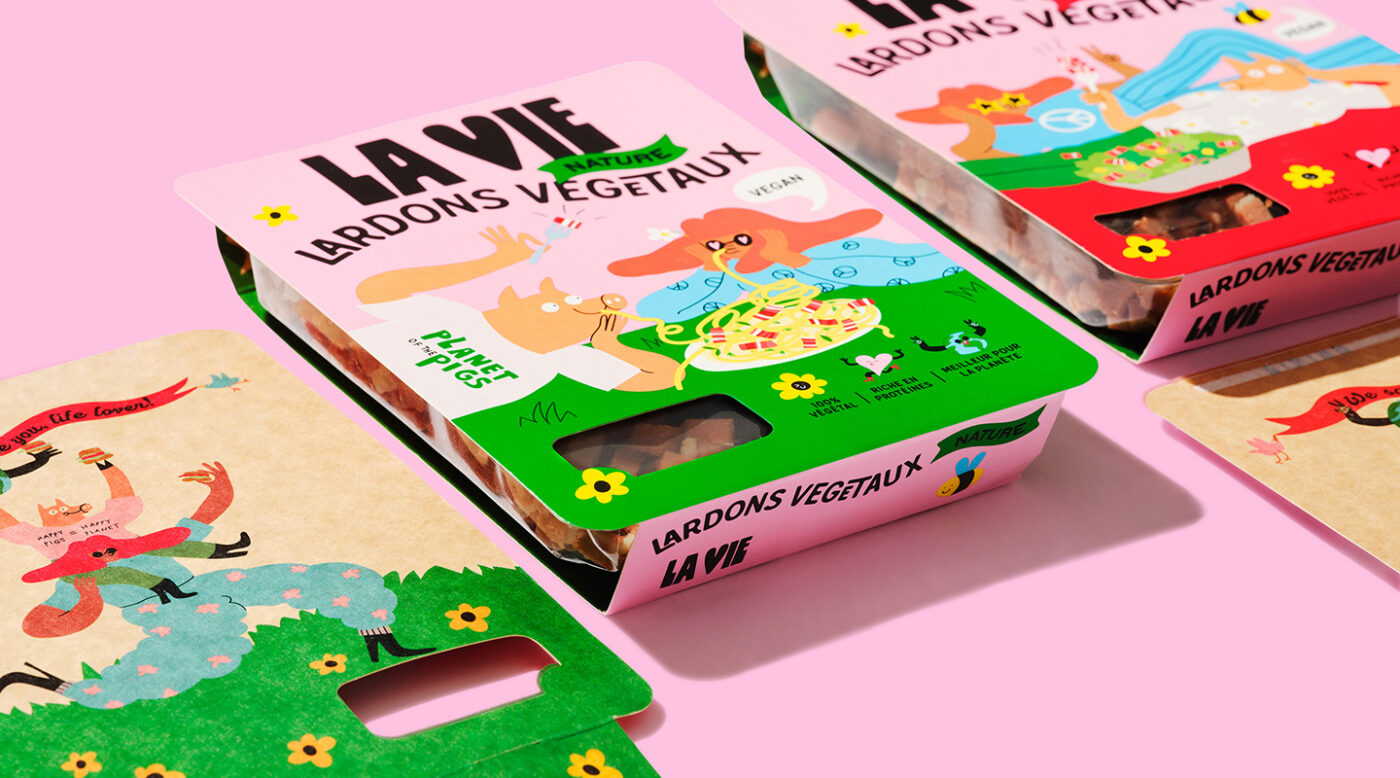
Credit : Packaging of the world

Credit : Rebellyous Foods
This topic is gaining importance, now touching a wide range of players including schools, thanks to the expansion of foodtech. Rebellyous Foods, a company specializing in plant-based nuggets, is expanding its influence, with more and more educational establishments opting for its products. According to this Seattle-based company, this trend reflects a growing movement within US schools, aiming to offer a greater variety of plant-based options.
Design plays a crucial role in this evolution. By integrating a design approach into the development of new food products and services, Foodtech companies can create solutions that are not only functional but also aesthetically pleasing. For instance, the packaging design can make or break a product’s success in the market. By using environmentally friendly materials and attractive designs, brands can attract environmentally conscious consumers while standing out on the shelves.
Take the example of La Vie, which aims to change mindsets about plant-based meat. To do this, the brand chose colorful, positive, and accessible packaging; a true celebration of life, as no animal was slaughtered to make this meal! Illustrated by artist Egle Zvirblyte, these packages appeal to both vegans and meat lovers alike!

Credit : Packaging of the world
By placing consumer needs and preferences at the forefront of product development, Foodtech companies can create solutions that truly resonate with their target audience. This approach involves conducting in-depth research and gathering consumer testimonials until the final product genuinely meets customer needs.
Meal kit delivery services are an excellent example of consumer-centered design. These services eliminate the daily hassles of meal planning and grocery shopping by delivering proportioned ingredients and recipes right to our doorstep. Catering to busy professionals and families who want to eat healthy meals at home without spending hours in the kitchen, meal kit delivery services have become a popular choice for many consumers.
Moreover, Foodtech doesn’t just meet our food needs; it also tackles broader issues like food waste. This is the idea behind the Too Good To Go app. Its intuitive, user-centered design facilitates connections between businesses with unsold goods and consumers eager to contribute to reducing waste. Thus, Too Good To Go perfectly illustrates how design can serve an ecological cause while meeting user expectations.

Credit : Too Good To Go
Moreover, Foodtech doesn’t just meet our food needs; it also tackles broader issues like food waste. This is the idea behind the Too Good To Go app. Its intuitive, user-centered design facilitates connections between businesses with unsold goods and consumers eager to contribute to reducing waste. Thus, Too Good To Go perfectly illustrates how design can serve an ecological cause while meeting user expectations.

Credit : Too Good To Go
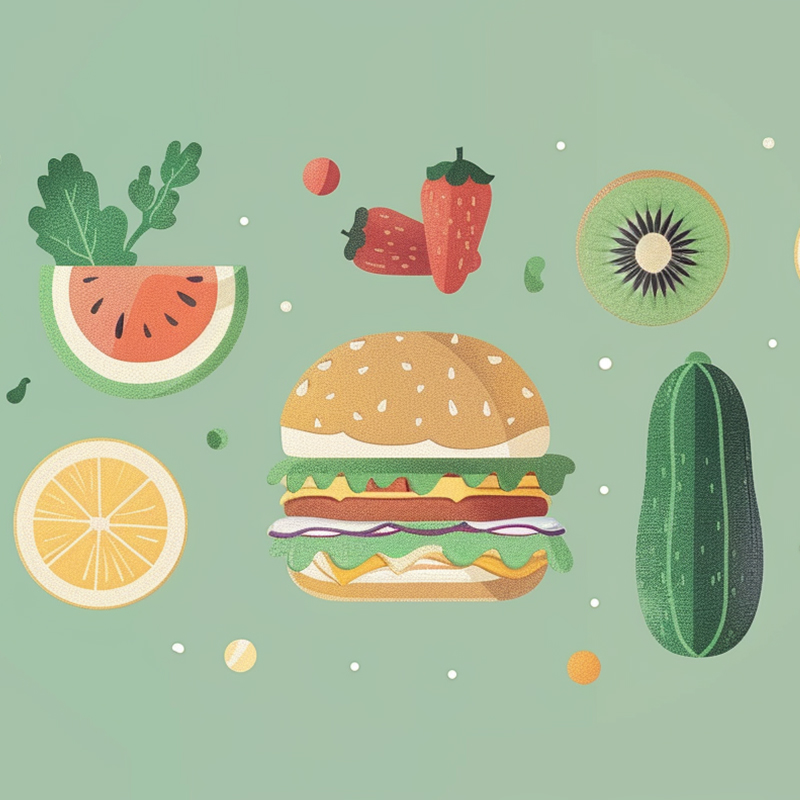
Credit : Midjourney
The future of Foodtech is promising, with endless possibilities for innovation and growth. One particularly interesting area is the use of technology to enhance the culinary experience. From augmented reality menus to smart kitchen appliances, technology is changing the way we interact with food. Moreover, as consumers become increasingly aware of the environmental impact of their diet, food technology companies are exploring new ways to reduce waste and promote sustainable practices. This ranges from using biodegradable packaging to developing plant-based alternatives to traditional meat products.

Credit : Midjourney
The future of Foodtech is promising, with endless possibilities for innovation and growth. One particularly interesting area is the use of technology to enhance the culinary experience. From augmented reality menus to smart kitchen appliances, technology is changing the way we interact with food. Moreover, as consumers become increasingly aware of the environmental impact of their diet, food technology companies are exploring new ways to reduce waste and promote sustainable practices. This ranges from using biodegradable packaging to developing plant-based alternatives to traditional meat products.
The horizon for Foodtech seems bright. This growth would primarily be driven by a steadily increasing demand for healthier, more sustainable, and convenient food products. However, Foodtech still has several hurdles to overcome, particularly regarding regulations and financing. It’s also crucial to ensure that these technological innovations do not create new disparities, such as favoring a wealthier clientele.
Foodtech has revolutionized the culinary industry, transforming not only our eating, cooking habits but also our mindset. The constantly evolving sector offers numerous opportunities for brands looking to stand out in the market. According to Emergen Research, it is estimated that the global Foodtech market could climb up to $342 billion by 2027. However, it’s important to understand that Foodtech is not just about food, but also about the overall consumer experience. And this is where design comes into play.
Foodtech has come a long way since its inception. From simple innovations like canned goods and refrigeration to more complex ones like molecular gastronomy and plant-based meat substitutes. Food technology has continually pushed the boundaries of what’s possible in the culinary world. Today, it involves creating sustainable, healthy, and convenient food options that cater to the needs of modern consumers.

Credit : Rebellyous Foods
This topic is gaining importance, now touching a wide range of players including schools, thanks to the expansion of foodtech. Rebellyous Foods, a company specializing in plant-based nuggets, is expanding its influence, with more and more educational establishments opting for its products. According to this Seattle-based company, this trend reflects a growing movement within US schools, aiming to offer a greater variety of plant-based options.
Design plays a crucial role in this evolution. By integrating a design approach into the development of new food products and services, Foodtech companies can create solutions that are not only functional but also aesthetically pleasing. For instance, the packaging design can make or break a product’s success in the market. By using environmentally friendly materials and attractive designs, brands can attract environmentally conscious consumers while standing out on the shelves.
Take the example of La Vie, which aims to change mindsets about plant-based meat. To do this, the brand chose colorful, positive, and accessible packaging; a true celebration of life, as no animal was slaughtered to make this meal! Illustrated by artist Egle Zvirblyte, these packages appeal to both vegans and meat lovers alike!

Credit : Packaging of the world
By placing consumer needs and preferences at the forefront of product development, Foodtech companies can create solutions that truly resonate with their target audience. This approach involves conducting in-depth research and gathering consumer testimonials until the final product genuinely meets customer needs.
Meal kit delivery services are an excellent example of consumer-centered design. These services eliminate the daily hassles of meal planning and grocery shopping by delivering proportioned ingredients and recipes right to our doorstep. Catering to busy professionals and families who want to eat healthy meals at home without spending hours in the kitchen, meal kit delivery services have become a popular choice for many consumers.
Moreover, Foodtech doesn’t just meet our food needs; it also tackles broader issues like food waste. This is the idea behind the Too Good To Go app. Its intuitive, user-centered design facilitates connections between businesses with unsold goods and consumers eager to contribute to reducing waste. Thus, Too Good To Go perfectly illustrates how design can serve an ecological cause while meeting user expectations.

Credit : Too Good To Go

Credit : Midjourney
The future of Foodtech is promising, with endless possibilities for innovation and growth. One particularly interesting area is the use of technology to enhance the culinary experience. From augmented reality menus to smart kitchen appliances, technology is changing the way we interact with food. Moreover, as consumers become increasingly aware of the environmental impact of their diet, food technology companies are exploring new ways to reduce waste and promote sustainable practices. This ranges from using biodegradable packaging to developing plant-based alternatives to traditional meat products.
The horizon for Foodtech seems bright. This growth would primarily be driven by a steadily increasing demand for healthier, more sustainable, and convenient food products. However, Foodtech still has several hurdles to overcome, particularly regarding regulations and financing. It’s also crucial to ensure that these technological innovations do not create new disparities, such as favoring a wealthier clientele.
In a world characterised by a frenetic pace, where changes are continuous and technological innovations are increasingly surprising, organisations face enormous challenges. The emergence of new generations of consumers, with different needs and behaviours, confronts companies with unprecedented scenarios, generating stress and the need for constant adaptation.
Faced with these challenges, organisations question themselves deeply about their future. There is a growing need to imagine a sustainable and profitable development that can guide companies through the uncertainties of an ever-changing market. Indeed, as the range of products and services expands, the more complex and complicated the brand becomes to manage.
In this context, a technical and strategic discipline such as Brand Architecture assumes a key role. The definition or evolution of a brand architecture is not only a marketing issue, but becomes a key element for the long-term corporate strategy. In our role as branding experts, we work daily with both emerging startups and large holding companies. Our goal is to build a clear and visionary future together, one that can interpret and anticipate market trends.
Before telling you about some of our case studies, it is useful to outline the main Brand Architecture models, in a quick but thorough way.
In the ‘Branded House’ model, the organisation uses a single brand, which is branched with different descriptors to identify all its products or services. This approach offers consistency and ease of brand management, reinforces core brand recognition and allows economies of scale in terms of marketing and communication.
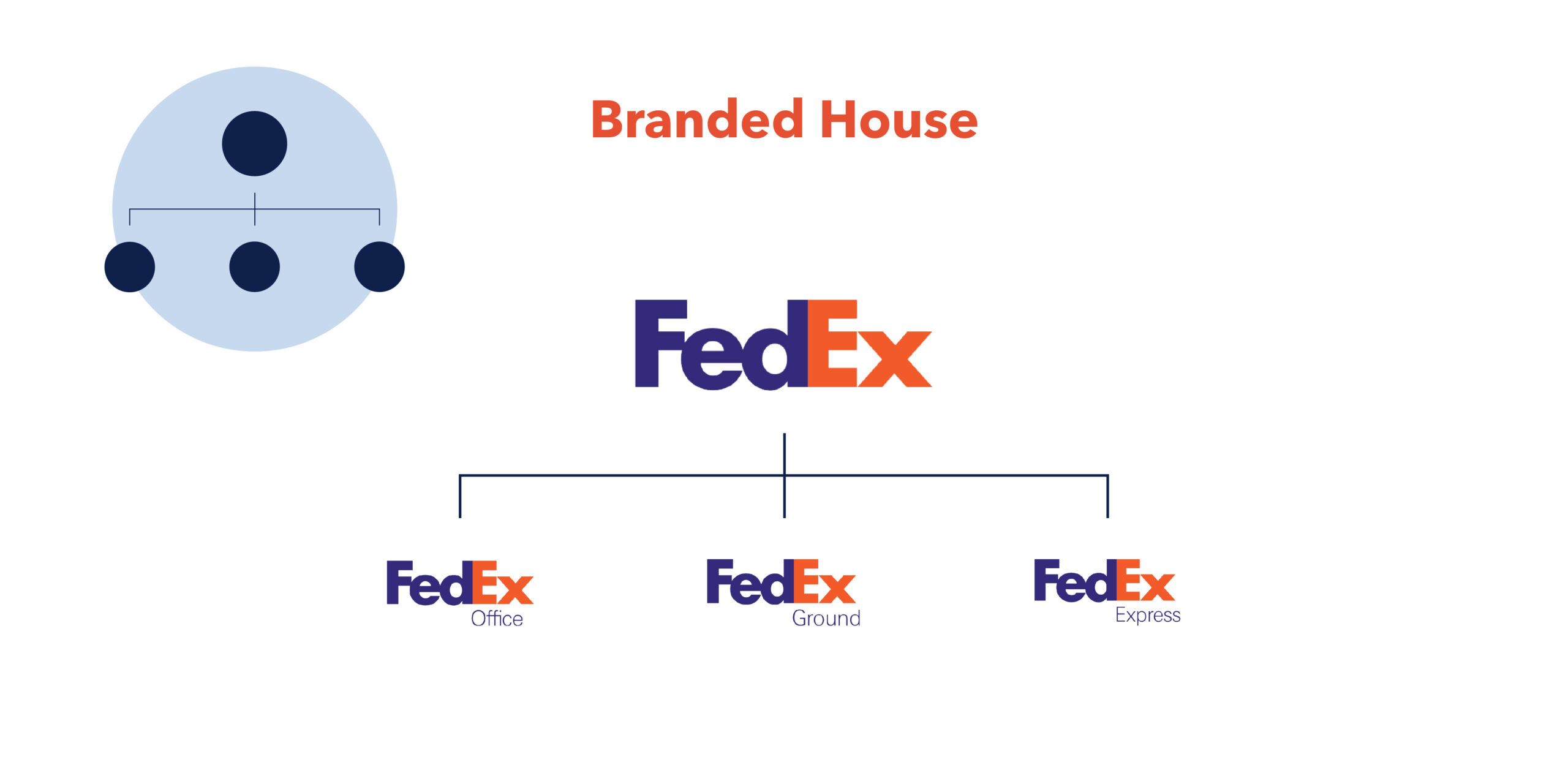
Communication
PRO: the possibility to exploit the image and notoriety of the main brand; lower communication costs because they are shared
CON: the risk of reputational damage to a sub-brand could extend to the main brand
Commercial
PRO: it forms economies of scale, thanks to the economic efforts focused on a single brand
CON: acquisition of new brands forces rebranding and the loss of equity
Internal Culture
PRO: a strong sense of brand-belonging by employees; the existence of a strong brand facilitates talent attraction
In contrast, in the ‘House of Brands’ model, the organisation operates a range of completely independent brands. This allows greater flexibility in the positioning of each individual brand, better market segmentation and the possibility to address different audiences without blurring the identity of each brand.
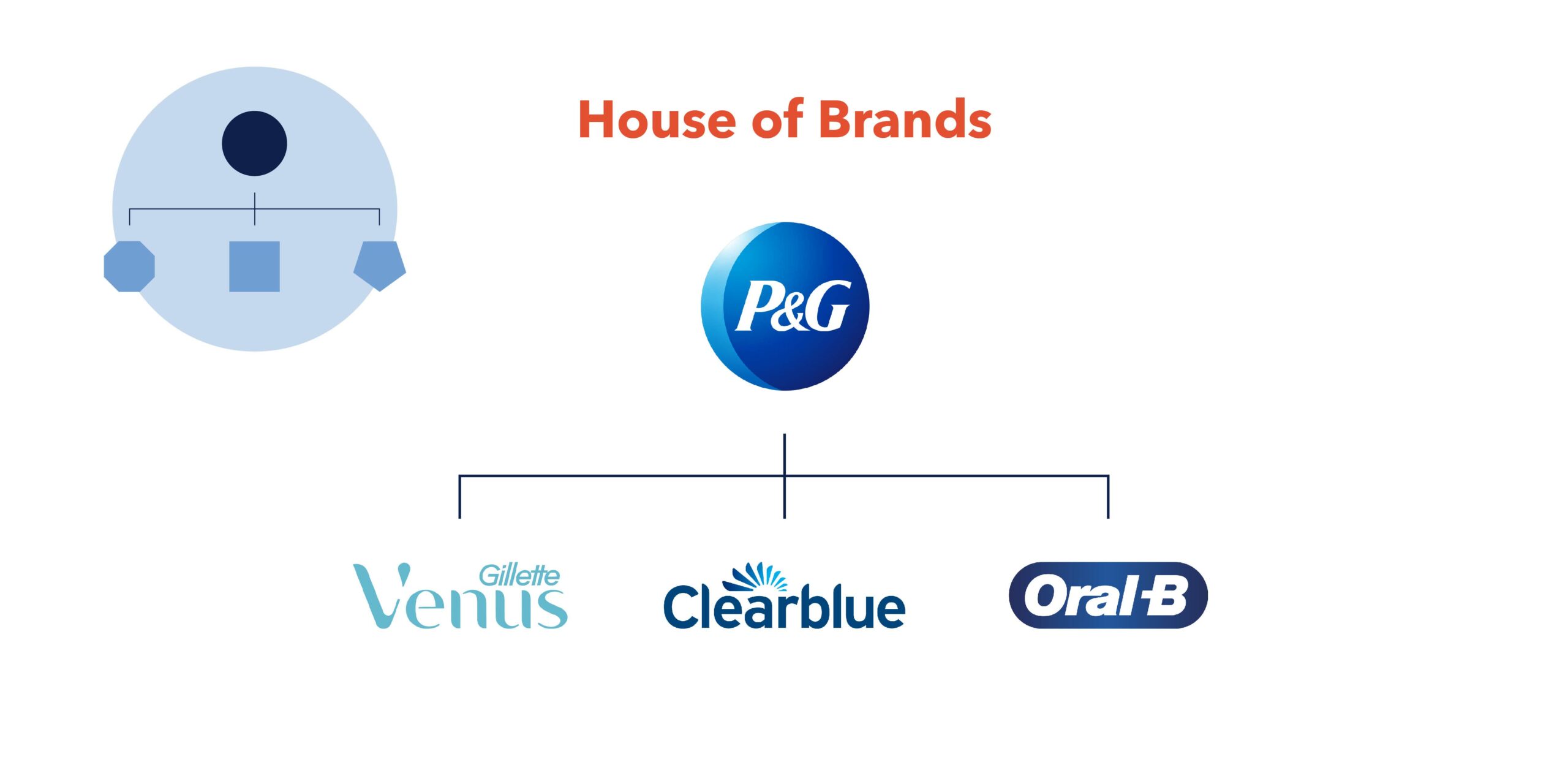
Communication
PRO: freedom and autonomy in adopting customised communication strategies
CON: risk of losing coherence in the group’s narrative, whose messages vary for each sub-brand
Commercial
PRO: greater diversification of business and investment opportunities
CON: lack of recognition of the main group/ brand; greater organisational and economic efforts
Internal Culture
PRO: each sub-brand can develop a distinctive internal culture
CON: the sense of belonging to the group requires more effort; the sharing of values and best practices must find a lowest common denominator

Since each brand is characterised by unique structures and thus distinct reactions to change, the two models listed above do not always provide adequate solutions. There is therefore an area where brand architecture offers different models, such as the ‘Hybrid‘ model or the ‘Endorsed‘ model.
And this is where, in our experience, most of the doubts and reflections are concentrated.
Following the acquisition of Altido, ChezNestor and Open, DoveVivo decided to unify the different operators under the same brand: Joivy. This union, guided by our strategic consultancy, required a gradual transition: a first step saw the retention of the acquired brands through the juxtaposition of an endorsement “by Joivy” (‘Endorsed Brands‘), to then arrive at the complete fusion and the definitive abandonment of the previous realities, in favour of a single international brand of living solutions.
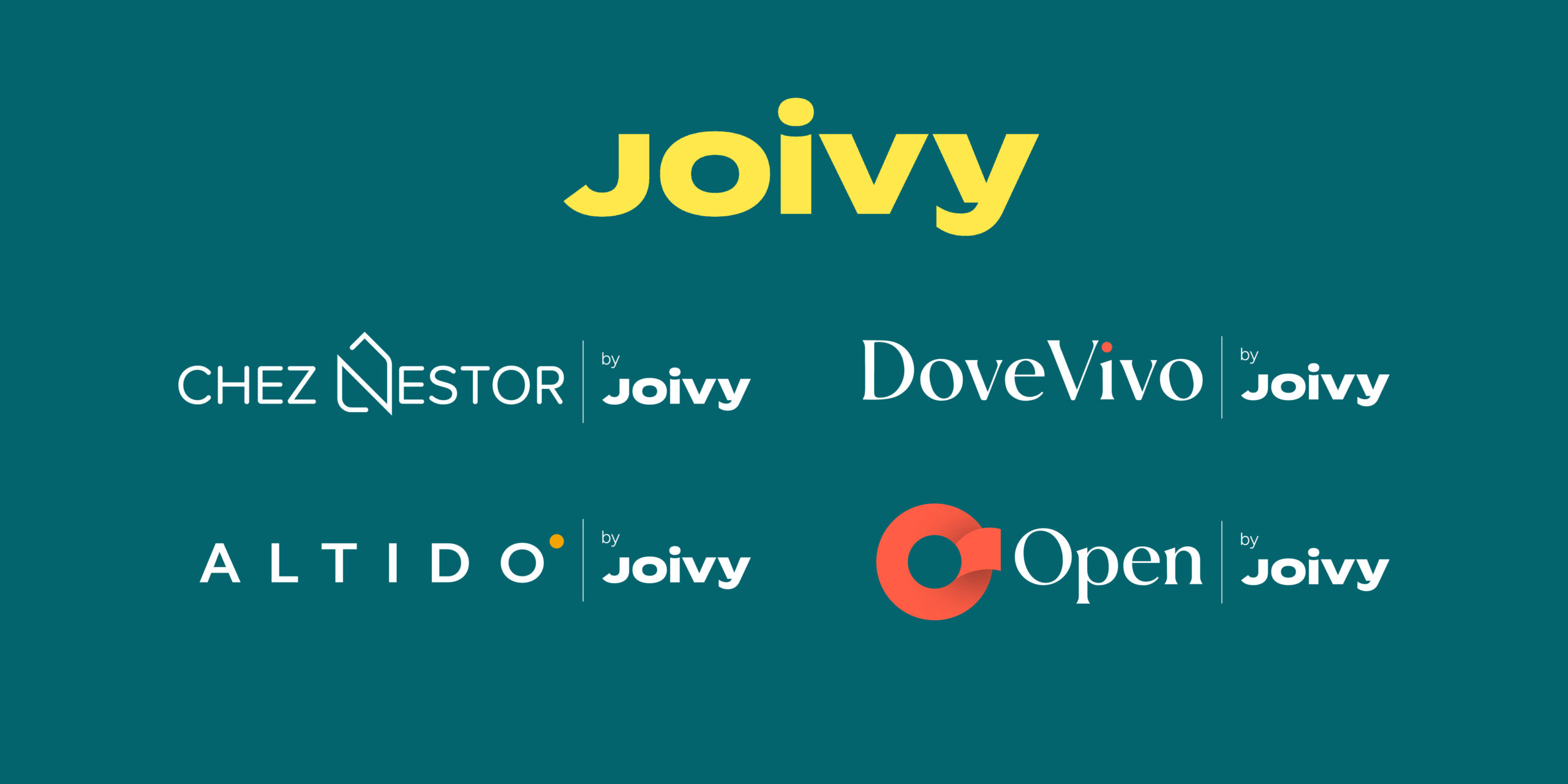
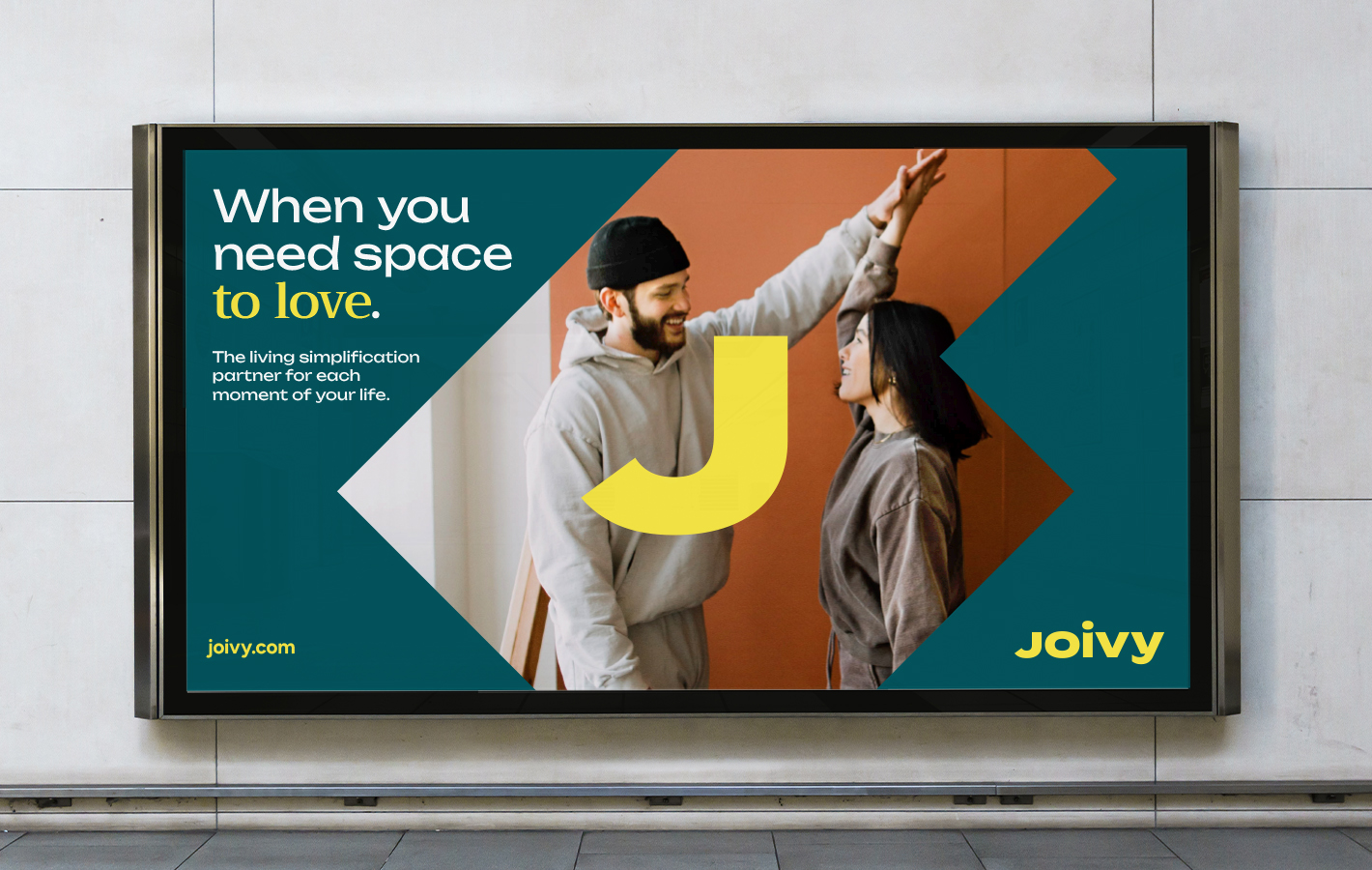
We subsequently had to undertake a second deep dive with the client, to create the in-house real estate brokerage division of Joivy.
The launch of the new brand and its Investments division were planned at the same time, so it was essential to maintain a strong visual link between the two realities. This led us to apply a ‘Branded House‘ model for Joivy, maintaining a strong visual consistency, to allow the corporate to create awareness effectively and solidify its equity.
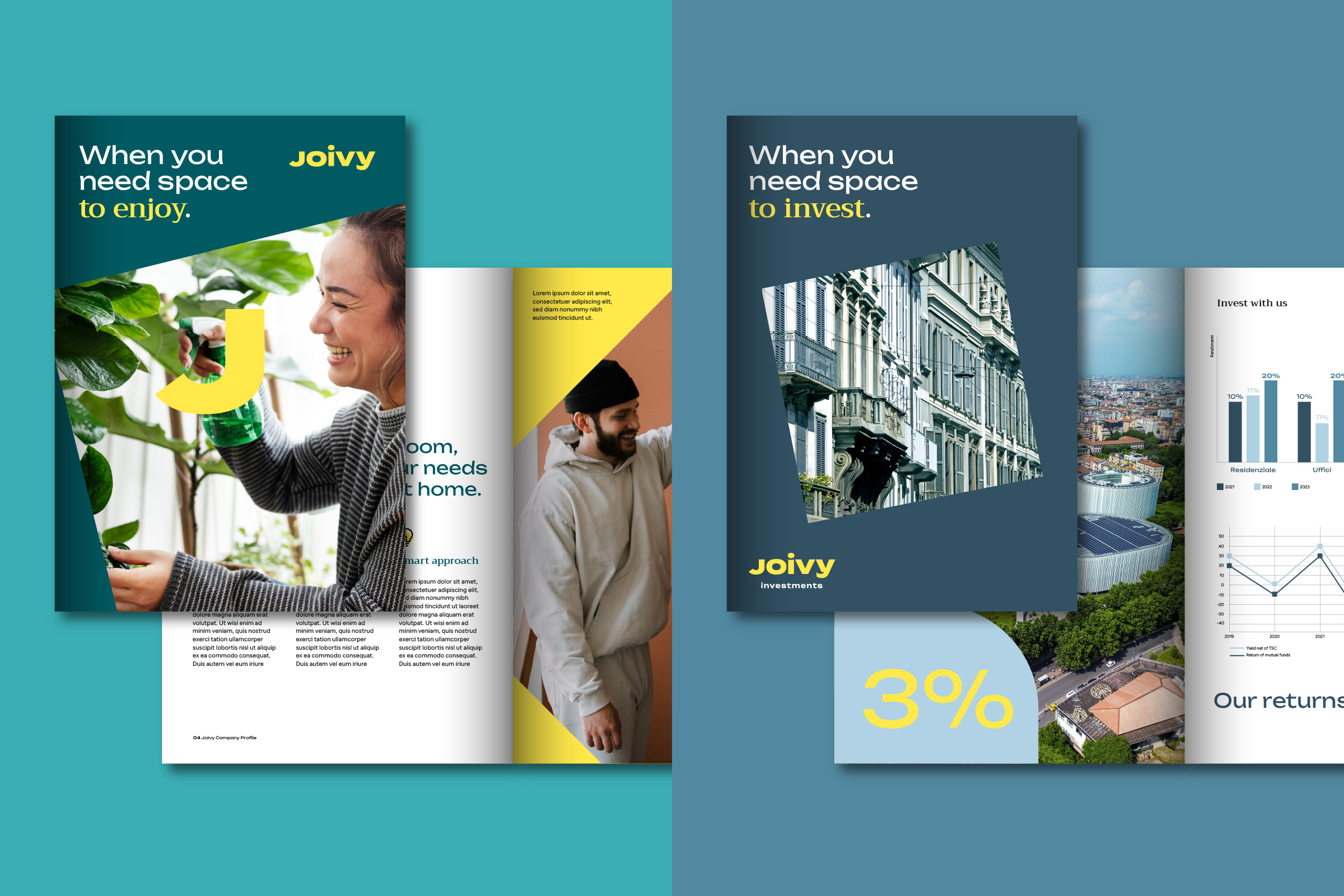
Openness, innovation, enterprise, growth: these are the value roots of the Sella Group, which have been translated and renewed in recent years through the birth of two new businesses: Lynfa, the Corporate Academy and Fabrick, the open banking platform.
We asked ourselves together with them which would be the right guidelines to direct the path of creation of these two new brands: to tend towards a ‘Branded House‘, thus maintaining the visual and verbal assets of the Group, or to break away towards a ‘House of Brands‘ model in order to enhance their DNA of values and their innovative “rupture” component?
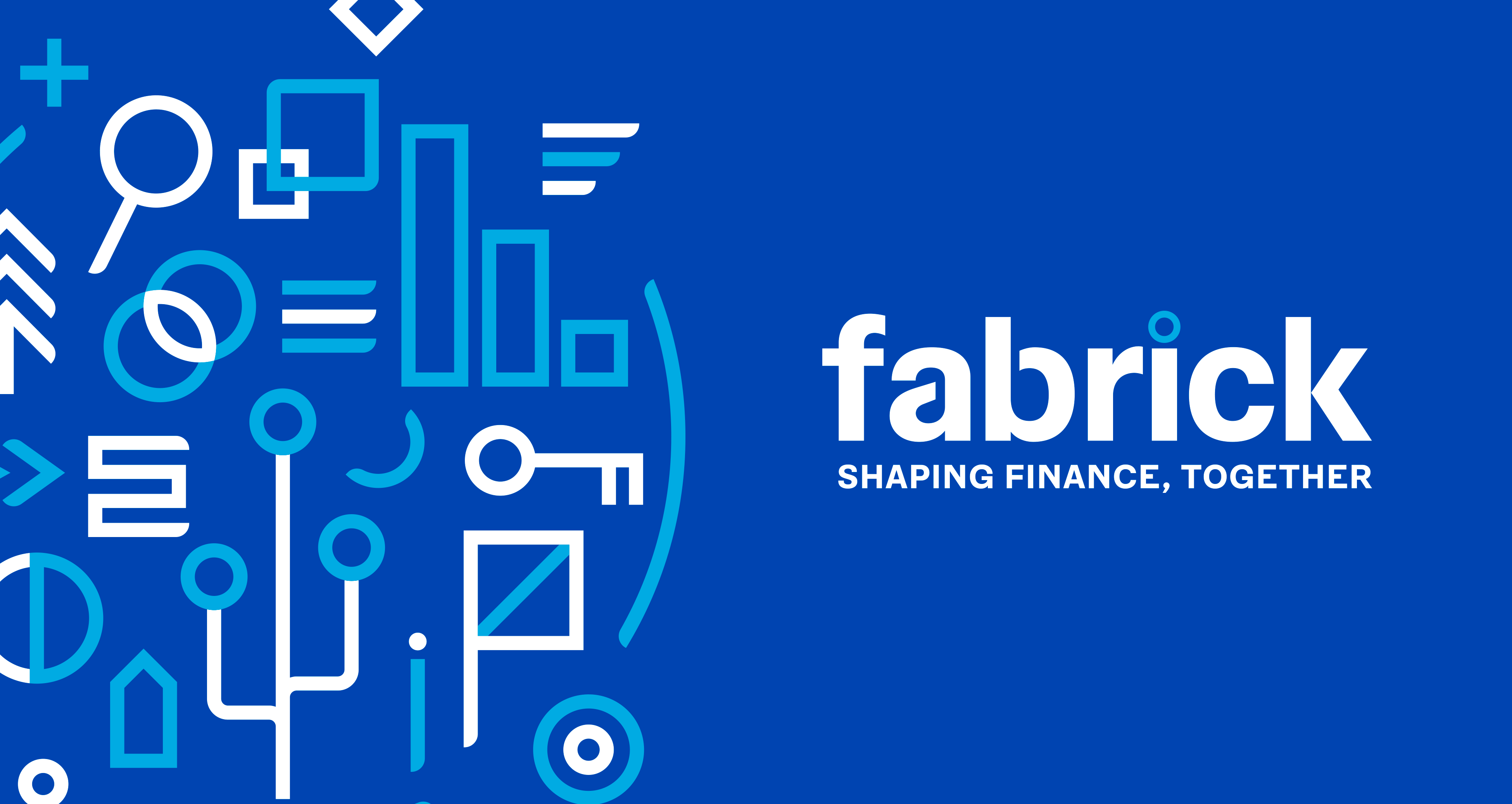
In both cases, the most courageous choice, that of moving away from the mother brand, was also the most strategic, because it is the one that allowed the two brands to be attractive and open to new talent (Lynfa) and collaborations between different financial players (Fabrick).
For many years we have been partners with Gi Group, an Italian multinational operating in the labour market sector. We have seen this reality grow and expand, opening up to new markets, acquiring new players and incubating new realities. With this evolution, the Gi Group consumer brand was no longer able to hold all these players together.
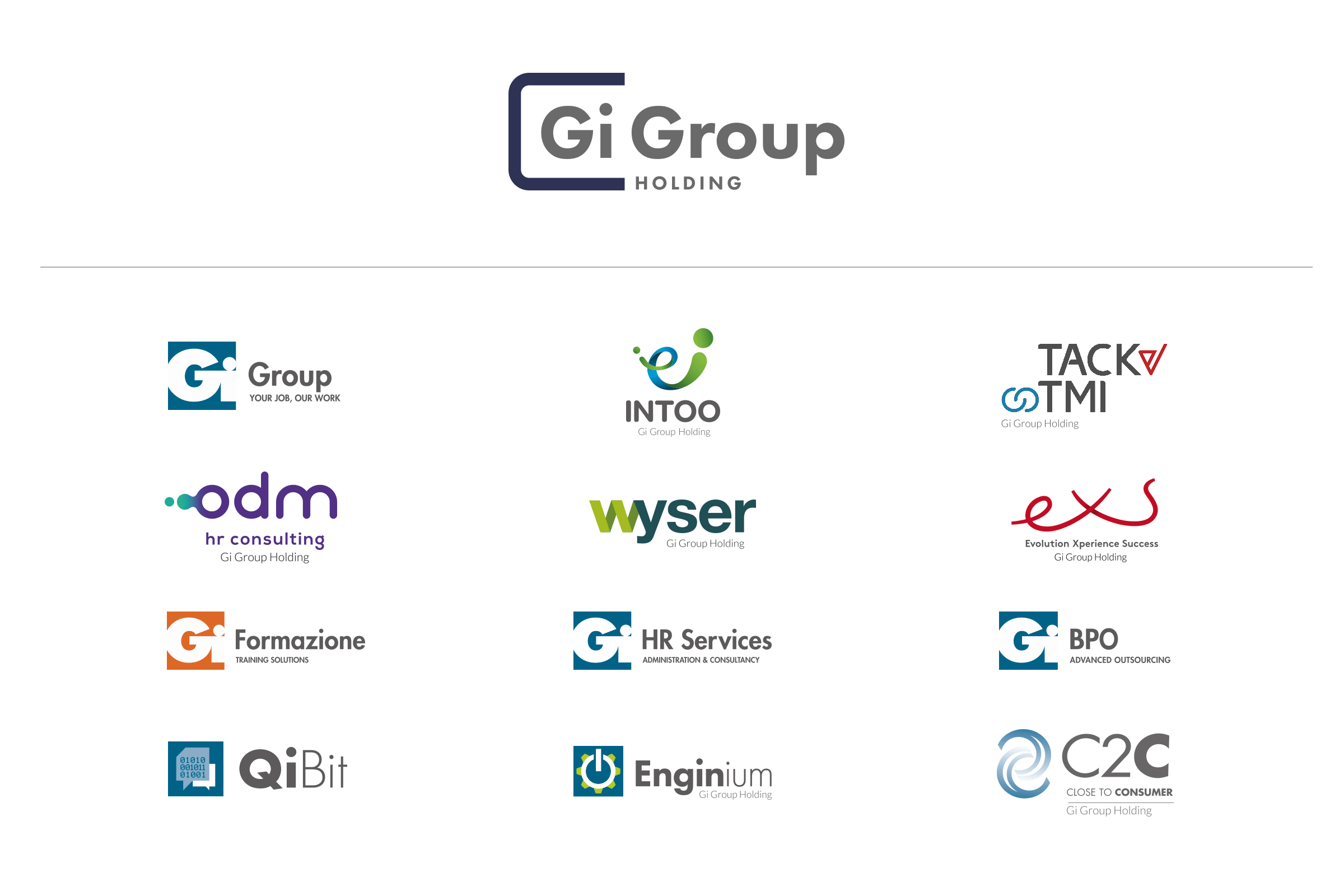
It was necessary to think of a brand architecture with a higher level, capable of acting as guarantor of all the players, creating order and eliminating this overlap in the common imagination between consumer brand and parent company. We thus accompanied the client in defining the positioning and strategic platform of Gi Group Holding.
This is how the endorsement “Gi Group Holding” is realised within the different company’s logos.

In conclusion, it is crucial to emphasise the importance of a Brand Architecture that is in perfect harmony with the company’s evolution and ambitions.
This strategic decision, crucial for success, is based on careful listening and a deep understanding of the user’s needs, key elements in our work as a branding agency. A well-designed Brand Architecture not only defines external identity, but it is also an internal tool for alignment and cohesion.
This approach aligns internal forces towards a common goal and clarifies the company’s vision to all stakeholders, laying the foundation for sustainable growth and the success of each product or service. In a constantly changing world, a solid and market-conscious Brand Architecture is a beacon that guides companies towards a prosperous future.
Holiday seasons like Valentine’s Day stand as pivotal moments for brands to cultivate consumer engagement and drive sales, leveraging the emotional resonance inherent on such occasions. Once a simple celebration of affection, February 14th has evolved into a grand marketing spectacle, wielding immense economic influence across diverse industries.
In fact, in 2024, Valentine’s Day expenditures in the United States are projected to soar to a staggering $26 billion (Statista, 2024). These figures underscore the burgeoning opportunity that this day represents for brands.
Therefore, it is legitimate to ask, how brands can leverage design strategies to maximize consumer engagement and drive sales during Valentine’s Day, as an opportunity to forge deeper connection with their audience.
In today’s dynamic landscape of relationships, the concept of “situationships” has emerged as a prominent phenomenon, especially among younger generations. According to a 2022 survey conducted by YPulse, 20% of Gen Z and 16% of Millennials report they have been in a situationship. And 35% of Gen z say they prefer to have an undefined relationship rather than one with a label, highlighting the evolving nature of modern love dynamics.
The campaign quickly gained traction on social media platforms, garnering over 1.2 million views on TikTok and sparking engagement from users who resonated with how confusing situationships can be. The brand’s website further extends the campaign’s reach with downloadable e-cards bearing phrases like “Do you know how much you mean to me? Because I don’t.” adding a touch of humor and authenticity to their Valentine’s Day strategy. This approach exemplifies how brands can adapt to evolving consumer behaviors and cultural trends, infusing their offerings with relevance and resonance.
Today’s romantic landscape is inseparable from dating apps. With 2.3 million daily unique visitors to these platforms in France in 2023, dating apps have become an essential aspect of modern romance. Consequently, they represent a significant business opportunity for brands aiming to expand their audience reach, enhance visibility, and engage users in meaningful ways by addressing real-life challenges.
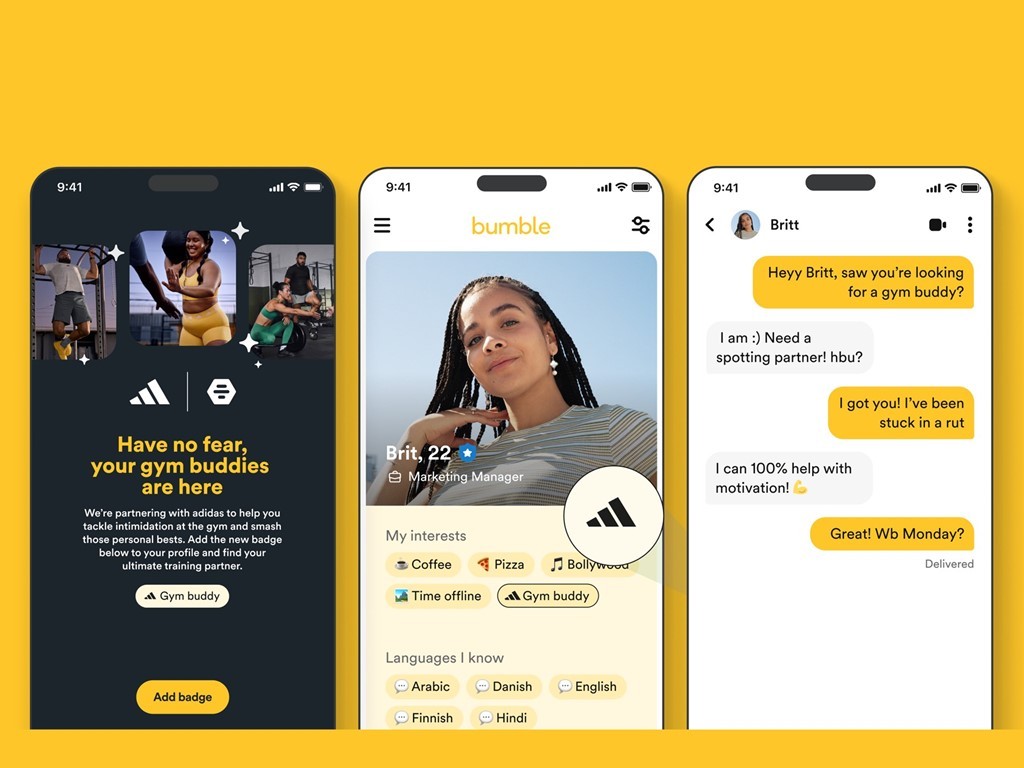
For example, Adidas and Bumble have collaborated to introduce a Gym Buddy Interest Badge on the dating app. This badge simplifies the process of finding potential gym partners who share a passion for staying active. The collaboration is in line with the launch of Adidas’s Spring/Summer 2024 Strength collection, showcasing the boundless potential of brand partnerships.
In another partnership, Tinder and Merci Handy have unveiled a capsule beauty collection named “First Date Heroes“. Inspired by an IFOP study for Tinder, which revealed that 74% of 18-25 year olds in France feel stressed before a date, this kit aims to ease the anxiety of first encounters. Additionally, 10% of proceeds from the collection are donated to Consentis, an association advocating for a culture of consent and combating sexual violence in social settings. This collaboration leverages Valentine’s Day as an opportunity to raise awareness of relevant issues and offer solutions that resonate with contemporary dating culture.
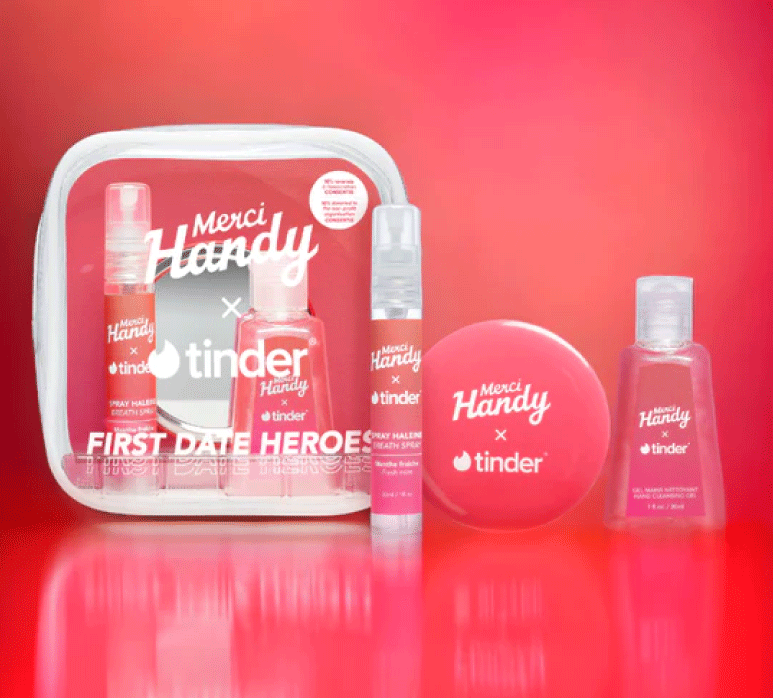
The increasing impact of AI is transforming how brands operate, presenting a new frontier in personalization and connection for both audiences and marketers. In the United States, 81% of consumers are open to AI providing personalized communications, underscoring the validity of its integration into communication and marketing strategies, especially evident during Valentine’s Day campaigns.
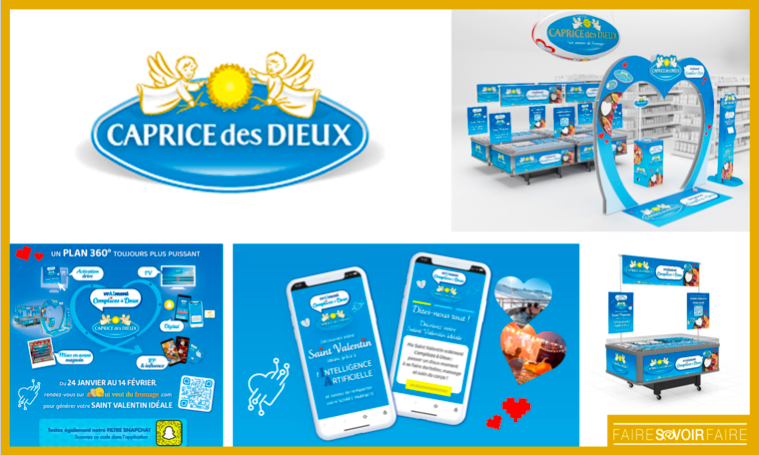
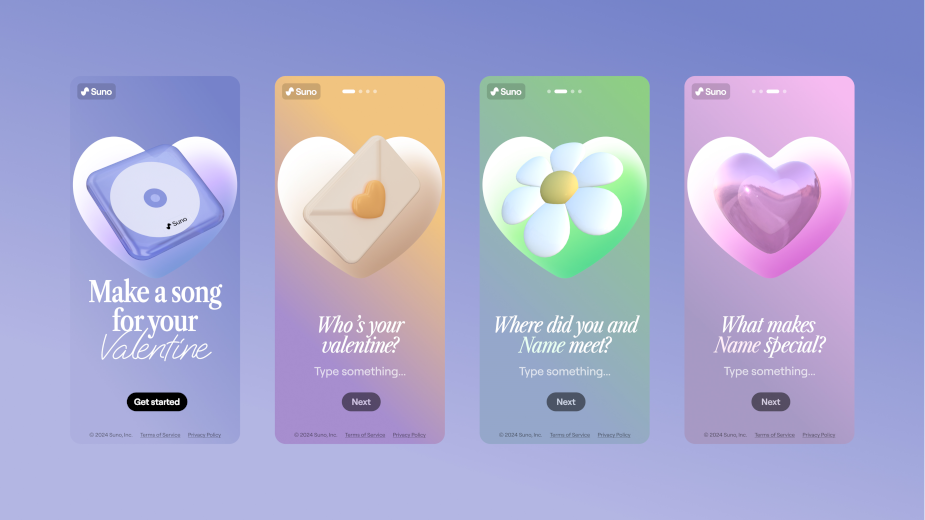
As for holiday season, Valentine’s Day is an opportunity for brands across all sectors to capitalize on the festive spirit by releasing limited edition products and redesigning their packaging. These special releases, ranging from beauty to food items, serve as simple but effective ways to engage consumers and drive sales.
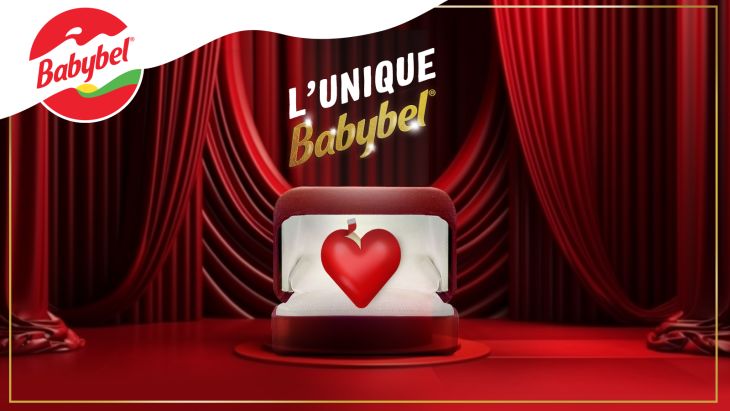
For instance, Babybel celebrates Valentine’s Day with a heart-shaped mini variant of its iconic cheese. However, this special edition isn’t available for purchase in stores; instead, consumers must participate in a sweepstake on Babybel’s Instagram page to win it. This approach not only generates excitement but also amplifies the visibility of the limited edition.
Barilla celebrates Valentine’s Day by introducing heart-shaped pasta, accompanied by special recipes for a romantic evening. Meanwhile, Manly Man Co.‘s Meathearts puts a savory twist on the sweet candy hearts with playful messages like “MEET ME”.
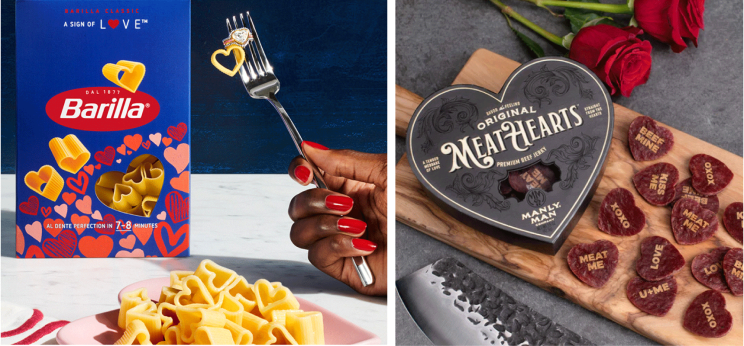
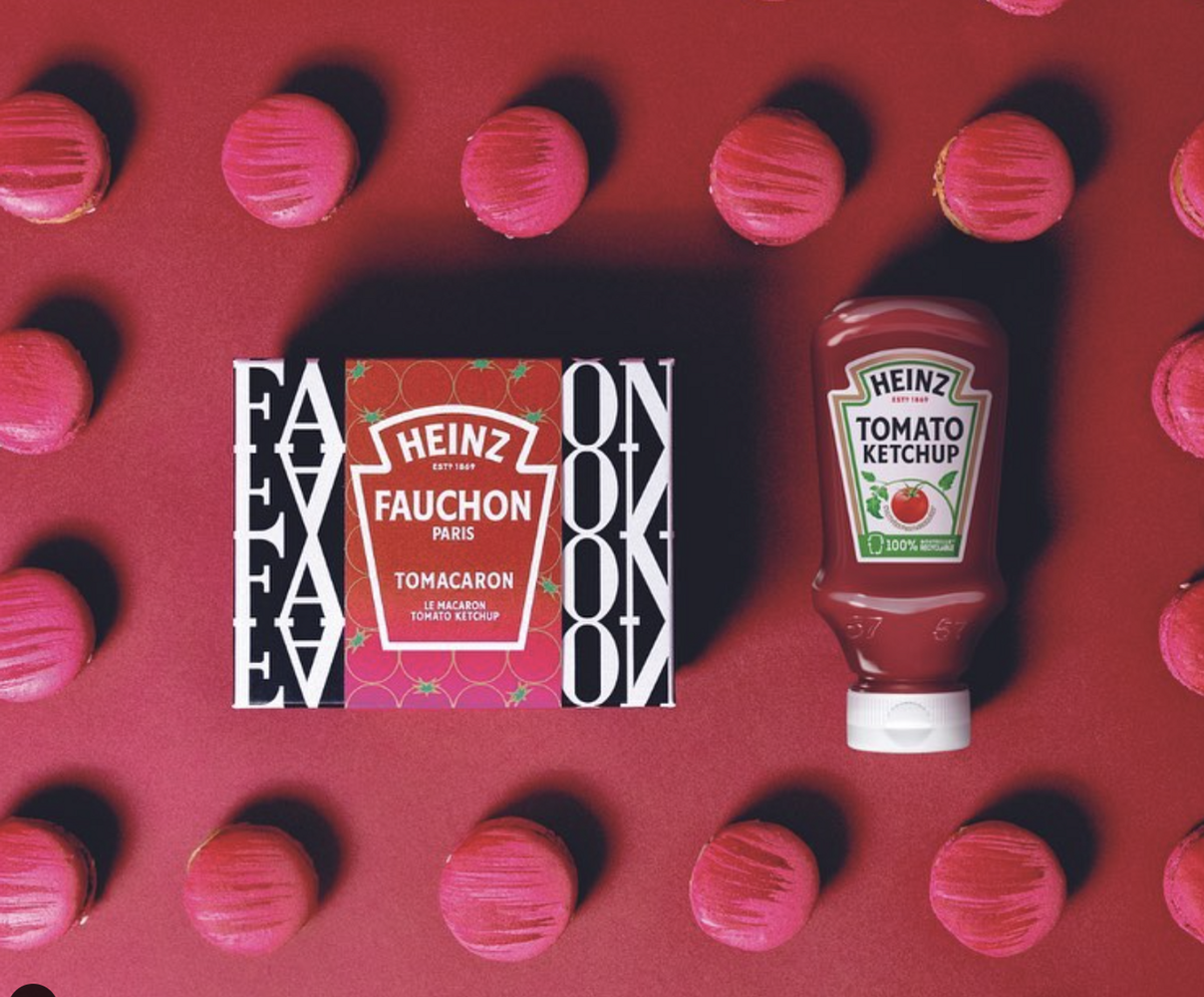
Heinz celebrated the attraction of opposites with Fauchon Paris through the introduction of the Tomacaron: a macaron with ketchup. This limited edition isn’t just a culinary collaboration; it’s a testament to the power of collaboration that unlocked new opportunities to showcase their respective strengths, broaden their audience reach, and unveil a product that captures the imagination of consumers.
Thus, with the constant evolution of trends, technology, and consumer behaviors, brands have a wide range of options to capitalize on Valentine’s Day. They can leverage the latest technological advancements and emerging trends such as “situationships” and artificial intelligence, or opt for more traditional strategies like limited editions. By integrating these approaches in innovative and thoughtful ways, brands can strengthen their position in the market and foster lasting relationships with their audience during Valentine’s Day and beyond.
Holiday seasons like Valentine’s Day stand as pivotal moments for brands to cultivate consumer engagement and drive sales, leveraging the emotional resonance inherent on such occasions. Once a simple celebration of affection, February 14th has evolved into a grand marketing spectacle, wielding immense economic influence across diverse industries.
In fact, in 2024, Valentine’s Day expenditures in the United States are projected to soar to a staggering $26 billion (Statista, 2024). These figures underscore the burgeoning opportunity that this day represents for brands.
Therefore, it is legitimate to ask, how brands can leverage design strategies to maximize consumer engagement and drive sales during Valentine’s Day, as an opportunity to forge deeper connection with their audience.
In today’s dynamic landscape of relationships, the concept of “situationships” has emerged as a prominent phenomenon, especially among younger generations. According to a 2022 survey conducted by YPulse, 20% of Gen Z and 16% of Millennials report they have been in a situationship. And 35% of Gen z say they prefer to have an undefined relationship rather than one with a label, highlighting the evolving nature of modern love dynamics.
The campaign quickly gained traction on social media platforms, garnering over 1.2 million views on TikTok and sparking engagement from users who resonated with how confusing situationships can be. The brand’s website further extends the campaign’s reach with downloadable e-cards bearing phrases like “Do you know how much you mean to me? Because I don’t.” adding a touch of humor and authenticity to their Valentine’s Day strategy. This approach exemplifies how brands can adapt to evolving consumer behaviors and cultural trends, infusing their offerings with relevance and resonance.
Today’s romantic landscape is inseparable from dating apps. With 2.3 million daily unique visitors to these platforms in France in 2023, dating apps have become an essential aspect of modern romance. Consequently, they represent a significant business opportunity for brands aiming to expand their audience reach, enhance visibility, and engage users in meaningful ways by addressing real-life challenges.

For example, Adidas and Bumble have collaborated to introduce a Gym Buddy Interest Badge on the dating app. This badge simplifies the process of finding potential gym partners who share a passion for staying active. The collaboration is in line with the launch of Adidas’s Spring/Summer 2024 Strength collection, showcasing the boundless potential of brand partnerships.
In another partnership, Tinder and Merci Handy have unveiled a capsule beauty collection named “First Date Heroes“. Inspired by an IFOP study for Tinder, which revealed that 74% of 18-25 year olds in France feel stressed before a date, this kit aims to ease the anxiety of first encounters. Additionally, 10% of proceeds from the collection are donated to Consentis, an association advocating for a culture of consent and combating sexual violence in social settings. This collaboration leverages Valentine’s Day as an opportunity to raise awareness of relevant issues and offer solutions that resonate with contemporary dating culture.

The increasing impact of AI is transforming how brands operate, presenting a new frontier in personalization and connection for both audiences and marketers. In the United States, 81% of consumers are open to AI providing personalized communications, underscoring the validity of its integration into communication and marketing strategies, especially evident during Valentine’s Day campaigns.


As for holiday season, Valentine’s Day is an opportunity for brands across all sectors to capitalize on the festive spirit by releasing limited edition products and redesigning their packaging. These special releases, ranging from beauty to food items, serve as simple but effective ways to engage consumers and drive sales.

For instance, Babybel celebrates Valentine’s Day with a heart-shaped mini variant of its iconic cheese. However, this special edition isn’t available for purchase in stores; instead, consumers must participate in a sweepstake on Babybel’s Instagram page to win it. This approach not only generates excitement but also amplifies the visibility of the limited edition.
Barilla celebrates Valentine’s Day by introducing heart-shaped pasta, accompanied by special recipes for a romantic evening. Meanwhile, Manly Man Co.‘s Meathearts puts a savory twist on the sweet candy hearts with playful messages like “MEET ME”.


Heinz celebrated the attraction of opposites with Fauchon Paris through the introduction of the Tomacaron: a macaron with ketchup. This limited edition isn’t just a culinary collaboration; it’s a testament to the power of collaboration that unlocked new opportunities to showcase their respective strengths, broaden their audience reach, and unveil a product that captures the imagination of consumers.
Thus, with the constant evolution of trends, technology, and consumer behaviors, brands have a wide range of options to capitalize on Valentine’s Day. They can leverage the latest technological advancements and emerging trends such as “situationships” and artificial intelligence, or opt for more traditional strategies like limited editions. By integrating these approaches in innovative and thoughtful ways, brands can strengthen their position in the market and foster lasting relationships with their audience during Valentine’s Day and beyond.
Holiday seasons like Valentine’s Day stand as pivotal moments for brands to cultivate consumer engagement and drive sales, leveraging the emotional resonance inherent on such occasions. Once a simple celebration of affection, February 14th has evolved into a grand marketing spectacle, wielding immense economic influence across diverse industries.
In fact, in 2024, Valentine’s Day expenditures in the United States are projected to soar to a staggering $26 billion (Statista, 2024). These figures underscore the burgeoning opportunity that this day represents for brands.
Therefore, it is legitimate to ask, how brands can leverage design strategies to maximize consumer engagement and drive sales during Valentine’s Day, as an opportunity to forge deeper connection with their audience.
In today’s dynamic landscape of relationships, the concept of “situationships” has emerged as a prominent phenomenon, especially among younger generations. According to a 2022 survey conducted by YPulse, 20% of Gen Z and 16% of Millennials report they have been in a situationship. And 35% of Gen z say they prefer to have an undefined relationship rather than one with a label, highlighting the evolving nature of modern love dynamics.
The campaign quickly gained traction on social media platforms, garnering over 1.2 million views on TikTok and sparking engagement from users who resonated with how confusing situationships can be. The brand’s website further extends the campaign’s reach with downloadable e-cards bearing phrases like “Do you know how much you mean to me? Because I don’t.” adding a touch of humor and authenticity to their Valentine’s Day strategy. This approach exemplifies how brands can adapt to evolving consumer behaviors and cultural trends, infusing their offerings with relevance and resonance.
Today’s romantic landscape is inseparable from dating apps. With 2.3 million daily unique visitors to these platforms in France in 2023, dating apps have become an essential aspect of modern romance. Consequently, they represent a significant business opportunity for brands aiming to expand their audience reach, enhance visibility, and engage users in meaningful ways by addressing real-life challenges.
For example, Adidas and Bumble have collaborated to introduce a Gym Buddy Interest Badge on the dating app. This badge simplifies the process of finding potential gym partners who share a passion for staying active. The collaboration is in line with the launch of Adidas’s Spring/Summer 2024 Strength collection, showcasing the boundless potential of brand partnerships.

In another partnership, Tinder and Merci Handy have unveiled a capsule beauty collection named “First Date Heroes“. Inspired by an IFOP study for Tinder, which revealed that 74% of 18-25 year olds in France feel stressed before a date, this kit aims to ease the anxiety of first encounters. Additionally, 10% of proceeds from the collection are donated to Consentis, an association advocating for a culture of consent and combating sexual violence in social settings. This collaboration leverages Valentine’s Day as an opportunity to raise awareness of relevant issues and offer solutions that resonate with contemporary dating culture.

The increasing impact of AI is transforming how brands operate, presenting a new frontier in personalization and connection for both audiences and marketers. In the United States, 81% of consumers are open to AI providing personalized communications, underscoring the validity of its integration into communication and marketing strategies, especially evident during Valentine’s Day campaigns.


As for holiday season, Valentine’s Day is an opportunity for brands across all sectors to capitalize on the festive spirit by releasing limited edition products and redesigning their packaging. These special releases, ranging from beauty to food items, serve as simple but effective ways to engage consumers and drive sales.
For instance, Babybel celebrates Valentine’s Day with a heart-shaped mini variant of its iconic cheese. However, this special edition isn’t available for purchase in stores; instead, consumers must participate in a sweepstake on Babybel’s Instagram page to win it. This approach not only generates excitement but also amplifies the visibility of the limited edition.

Barilla celebrates Valentine’s Day by introducing heart-shaped pasta, accompanied by special recipes for a romantic evening. Meanwhile, Manly Man Co.‘s Meathearts puts a savory twist on the sweet candy hearts with playful messages like “MEET ME”.

Heinz celebrated the attraction of opposites with Fauchon Paris through the introduction of the Tomacaron: a macaron with ketchup. This limited edition isn’t just a culinary collaboration; it’s a testament to the power of collaboration that unlocked new opportunities to showcase their respective strengths, broaden their audience reach, and unveil a product that captures the imagination of consumers.

Thus, with the constant evolution of trends, technology, and consumer behaviors, brands have a wide range of options to capitalize on Valentine’s Day. They can leverage the latest technological advancements and emerging trends such as “situationships” and artificial intelligence, or opt for more traditional strategies like limited editions. By integrating these approaches in innovative and thoughtful ways, brands can strengthen their position in the market and foster lasting relationships with their audience during Valentine’s Day and beyond.
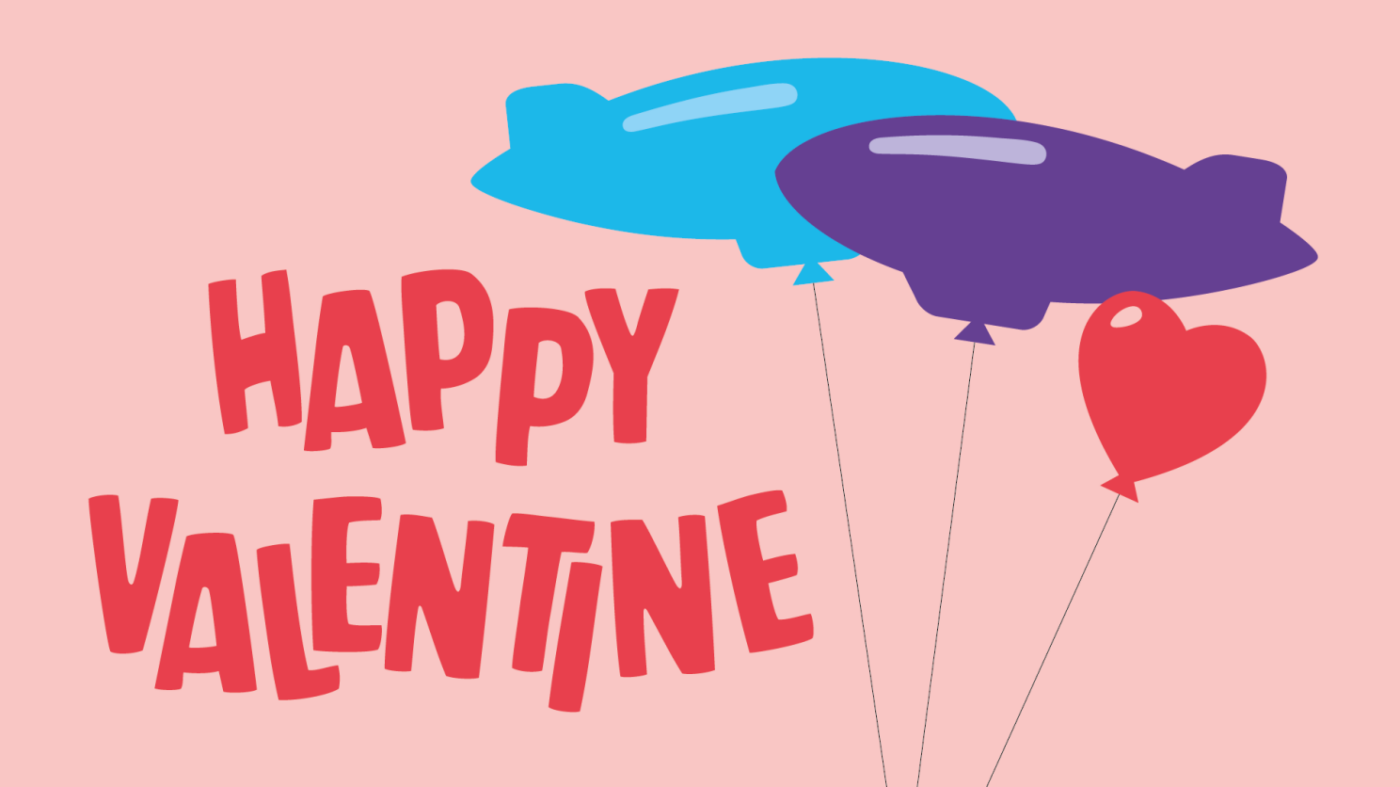
In a world where change is the only constant, the ability to discern fleeting fads from enduring trends is more crucial than ever.
We have highlighted 15 trends that promise longevity and sustainability, transcending the ephemeral nature that characterizes the world of brands, with a focus on positive impact.
Our report, covering over 40 industries and 90 case studies, revolves around 5 pillars derived from our Critical Imprint utility map:

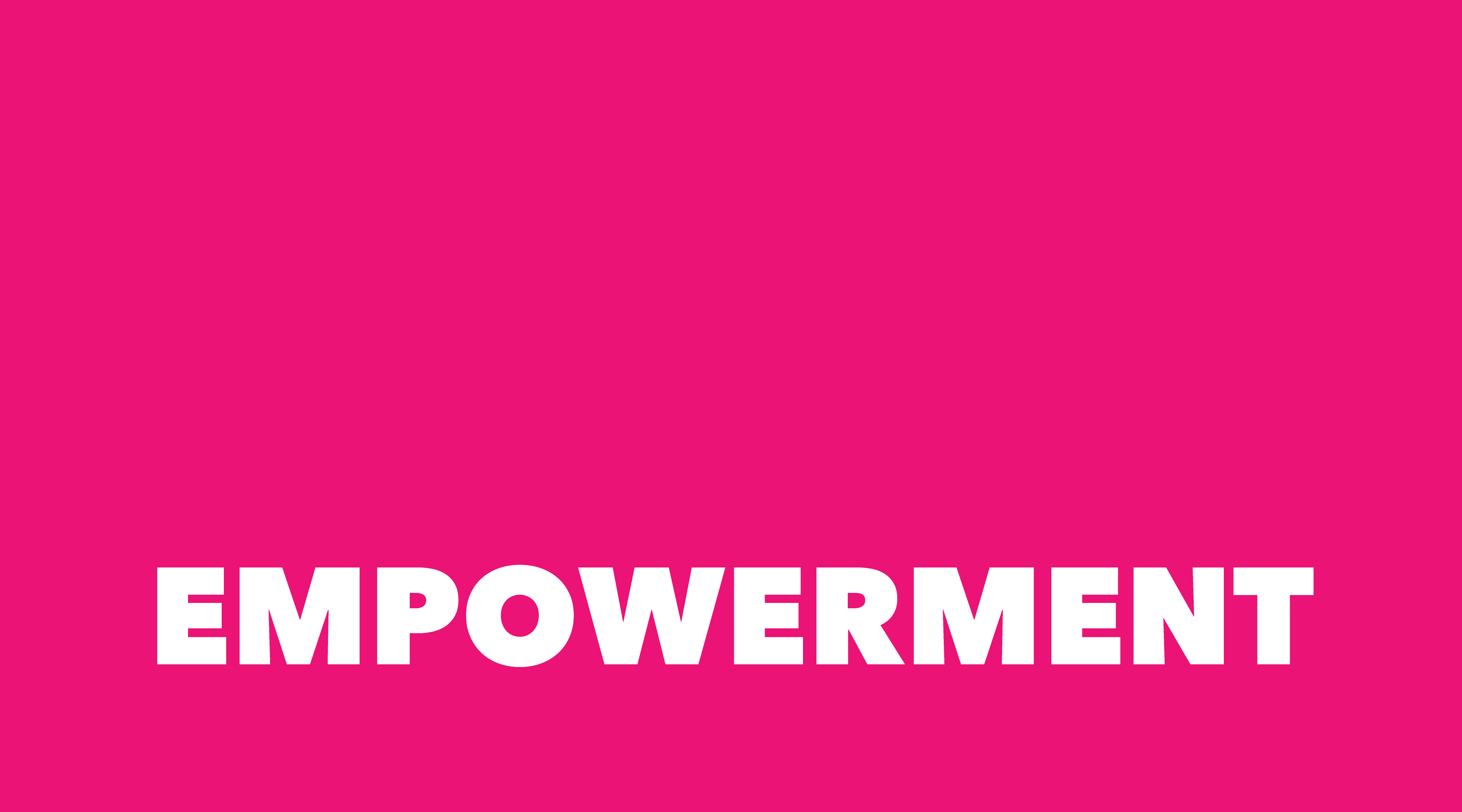


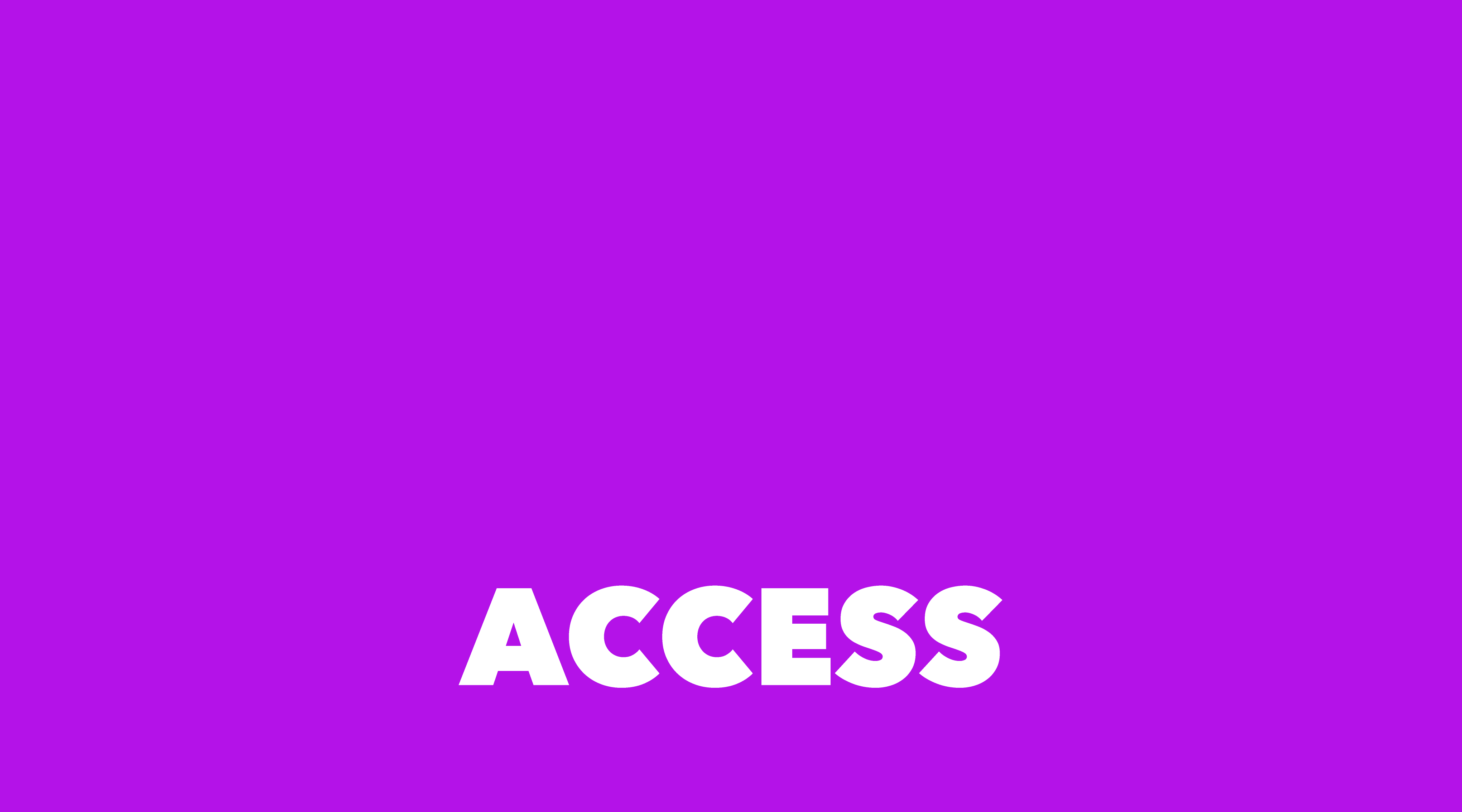
Reinventing raw materials and everyday consumer products is a necessity: we must consider material innovation and reorient product life cycles.
Ancient wisdom is increasingly acknowledged for modern environmental solutions.
continue to gain ground. Brands are increasingly rejecting binary gender norms and traditional aesthetics.
are increasingly adopted by brands for holistic well-being.
… while increasingly, brands integrate behavioral design into their strategies, thus promoting spaces of connection and shared experiences against digital isolation.
Brands are adapting to the rising cost of living by prioritizing cost-effective solutions, while cities worldwide adjust to environmentally friendly micromobility.
As we step into 2024, the question arises: “New year, new trends?” The answer leans towards continuity rather than a complete overhaul. While some fresh trends are set to emerge, the design environment will continue to sustain many of the existing ones.
So, as we step into 2024, what emerging trends will the world give birth to, or which existing trends will it continue to embrace?
As we navigate a rapidly changing world where environmental issues have become more fundamental than ever, sustainability touches every sector, emphasizing its importance in the face of an ever-expanding threat. In the face of this growing threat, design emerges as a key player in the battle against climate change.
Sustainability is no longer just a buzzword; it has become an integral element of both daily consumer life and corporate policies. This serves as the driving force behind the surge of alternative material development, particularly in retail and packaging.
According to Ipsos (2022), almost 60% of the French population intends to ditch excessive packaging in the fight against climate change — a compelling percentage that encourages brands to integrate more eco-design into their production methods. The growing consumer demand for environmentally conscious choices is compelling more and more brands today, and will continue to do so in the future, to commit to responsible packaging design.
Sustainable material choices coupled with responsible manufacturing processes will continue to play a key part in design for 2024.
Chris Wilson, STCKMN
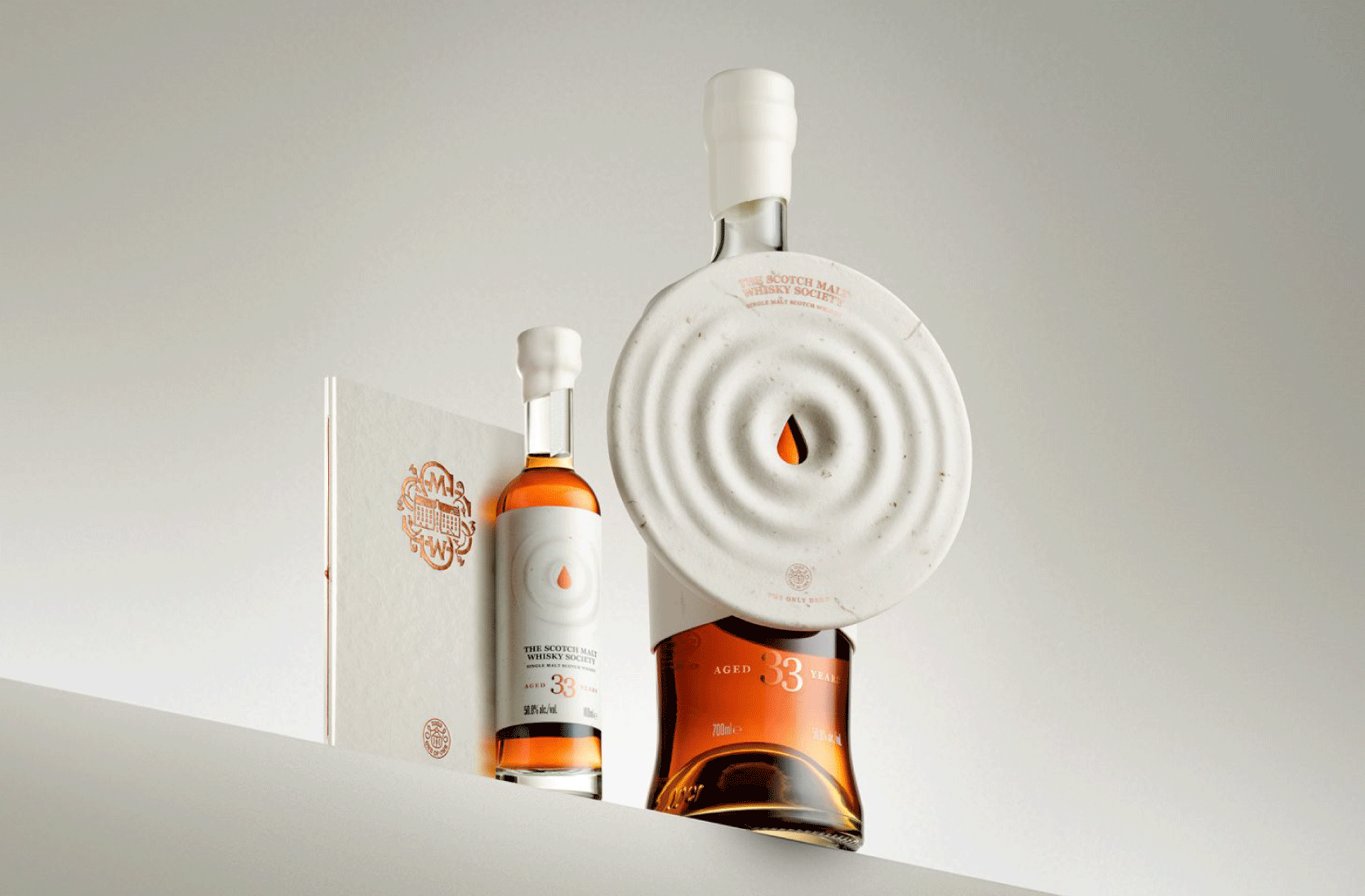
In 2024, biodegradable, compostable, and recyclable packaging, providing alternatives to single-use items, is likely to gain a more prominent role.
The Scotch Malt Whisky Society exemplifies this trend with its handcrafted paper-pulp bottle outer. By making eco-friendly material choices and employing handmade production methods, the bottle not only achieves a luxurious aesthetic but also avoids the greenwashed approach to sustainability.
Design provides a unique opportunity to reconsider our consumption and production patterns. The retail sector is undergoing a significant transformation, adapting to the growing ecological awareness by incorporating environmentally friendly practices into all aspects of the retail process.
Sustainable retail design is now a crucial player in shaping our world’s future. It authentically addresses environmental concerns and aligns with the corporate social responsibility (CSR) initiatives of brands that adopt it.
Examples such as Nescafe’s eco-friendly store in São Paulo, built with biodegradable materials and utilizing algorithmic 3D printing, and VALRHONA’s Parisian store, exclusively crafted with eco-responsible materials, showcase how retail design can innovate spaces while minimizing ecological impact.
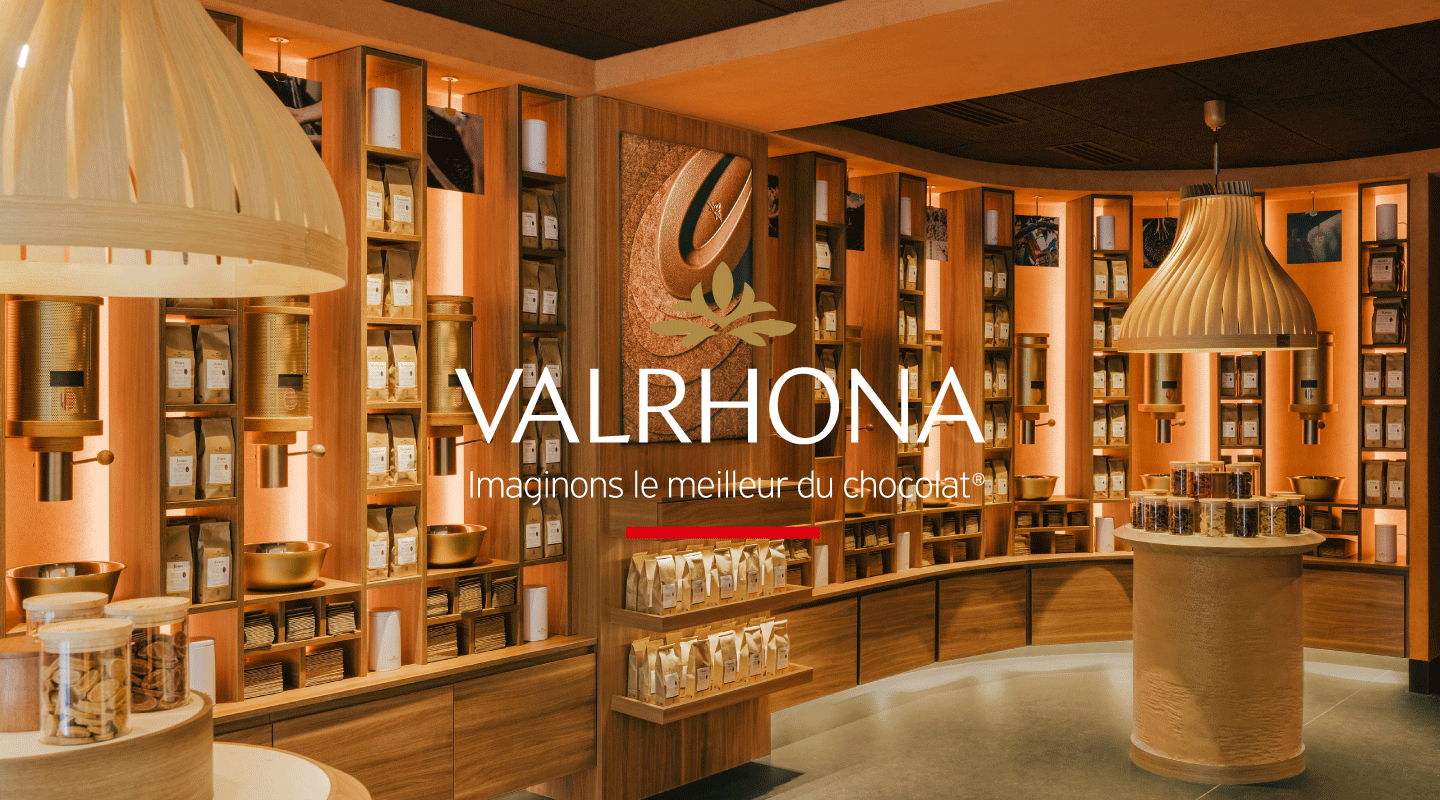
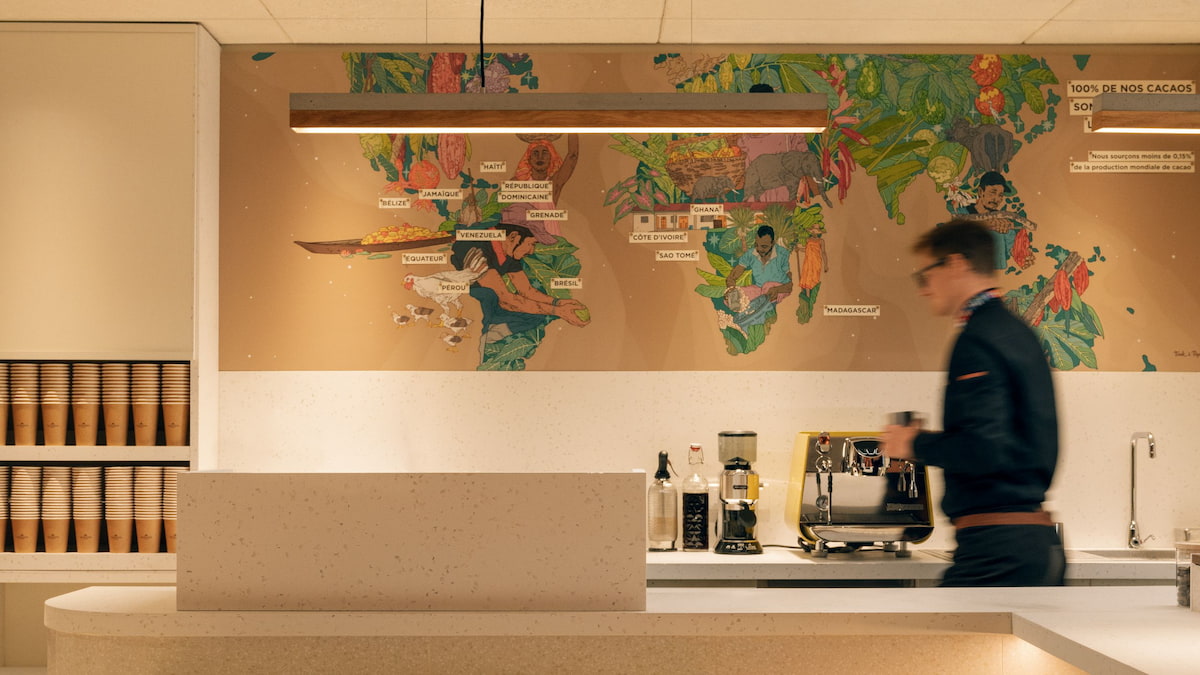
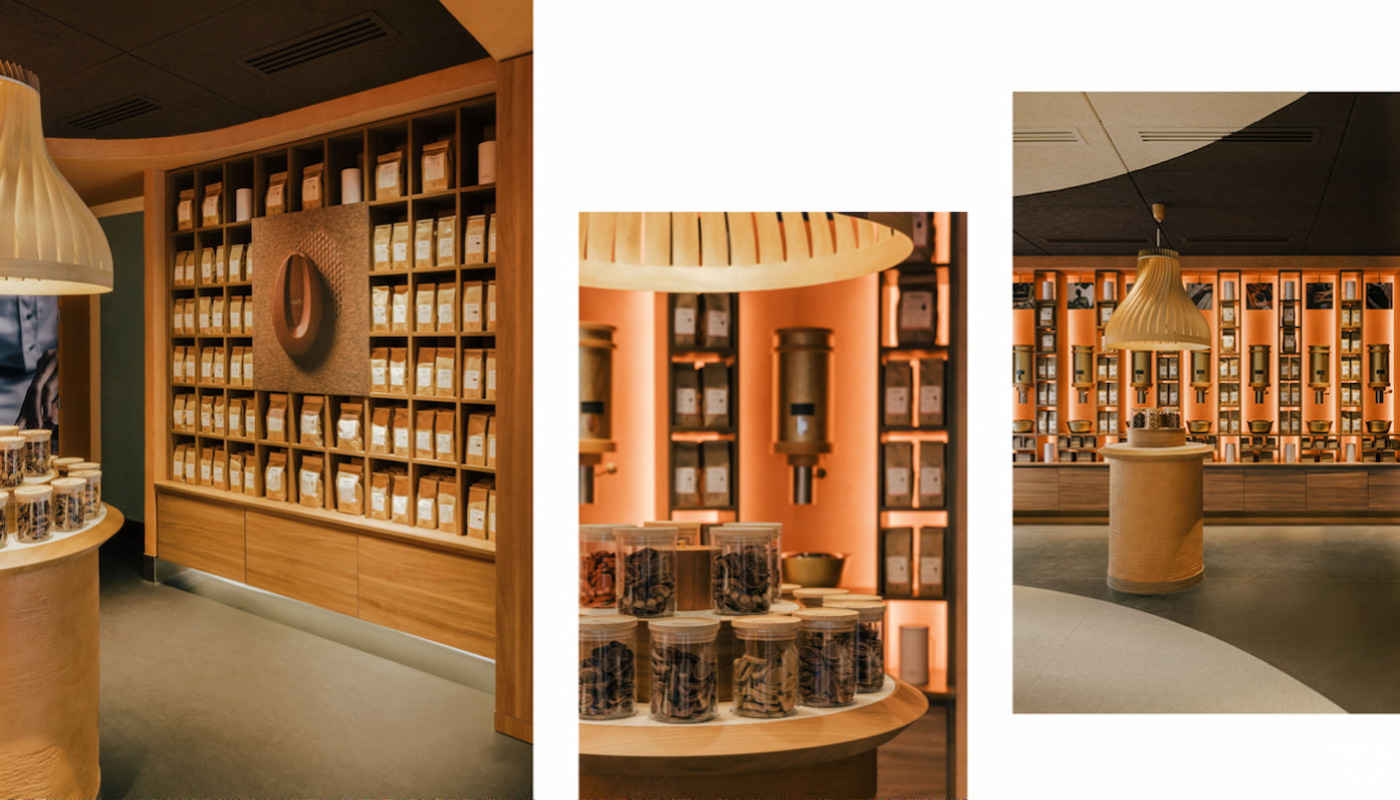
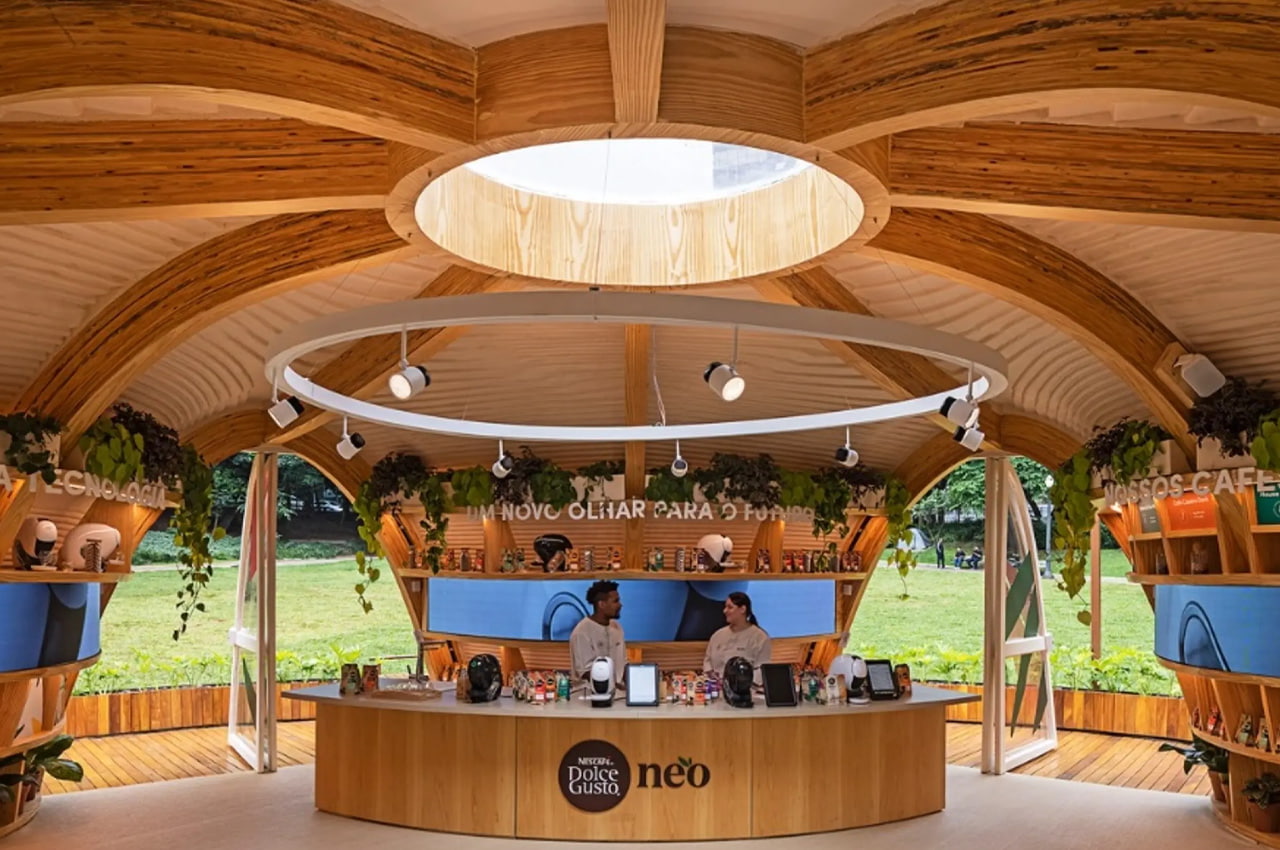
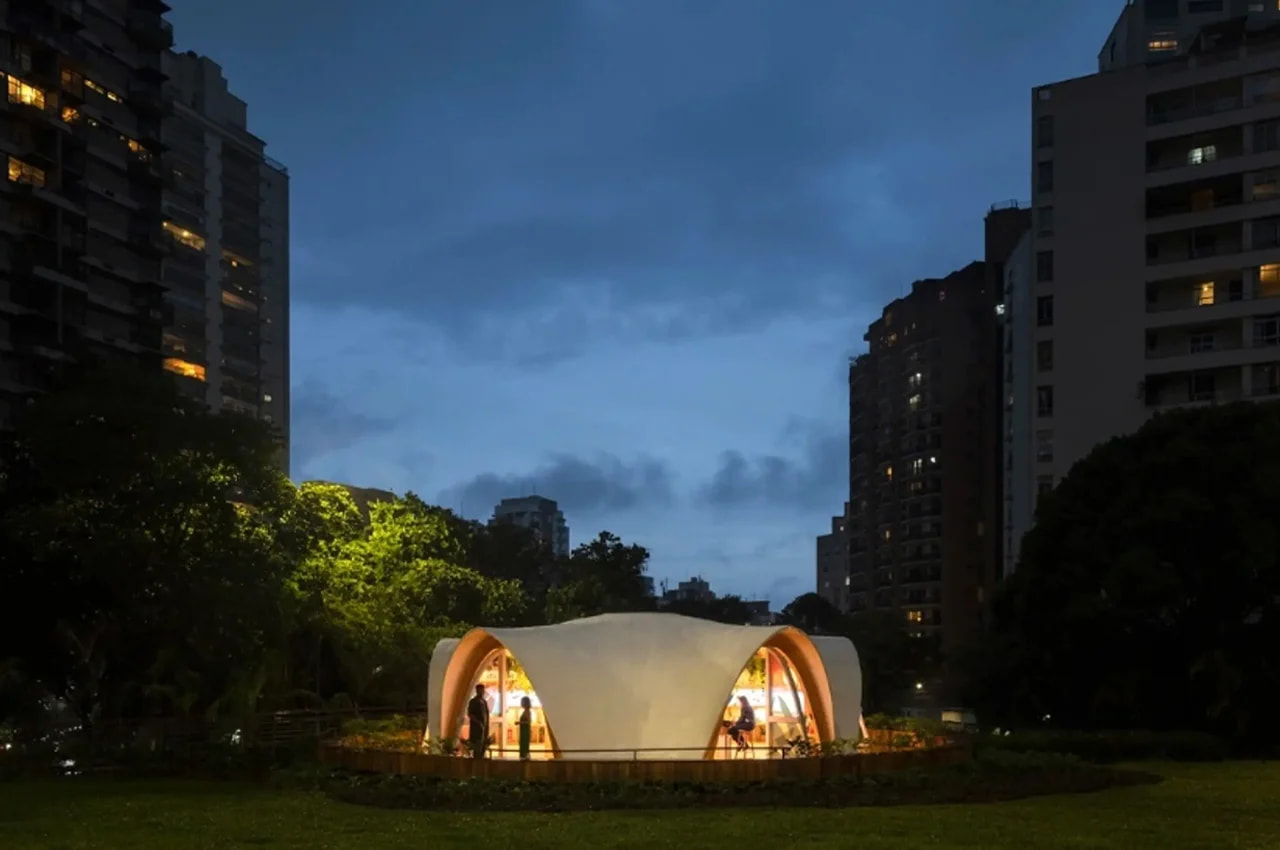
Sustainable retail not only touches brands but also shapes the future dining experience. Practices in the food industry are evolving beyond reducing food waste, with circular design in restaurants representing the next step in eco-friendly dining. Zero Waste Bistro, a pop-up restaurant featured in New York, constructed from recycled food packaging and composting all its leftovers, epitomizes this trend.
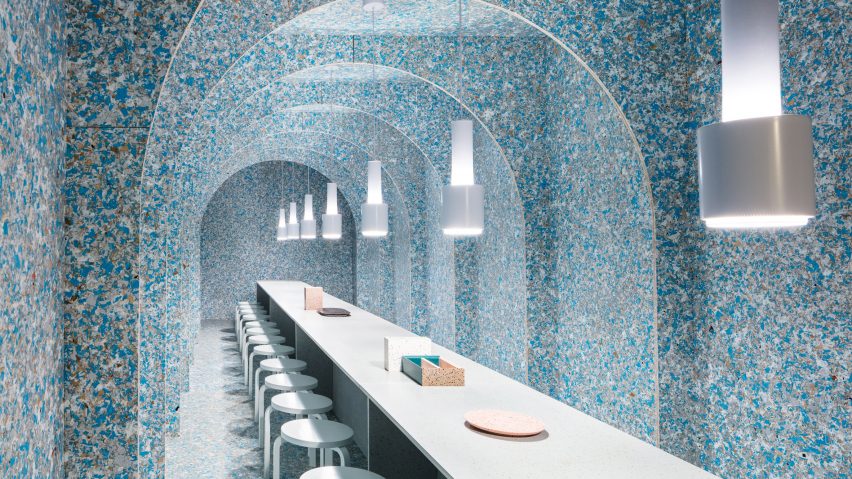
Brands have a powerful role to play, from shaping culture and society to actively creating opportunities for everyone, regardless of age, physical ability, gender, or ethnic origin. Today, designing for accessibility and inclusion transcends ethical considerations; it’s also a lucrative business move, particularly in the technology sector. With more than 1 billion people worldwide estimated to experience disability and over 5 billion internet users, there is a big opportunity for brands to enhance their products and services to be more accessible.
Design is a powerful tool for breaking down barriers, and an increasing number of brands are recognizing its potential. For instance, the MouthPad, developed by Augmental, allows hands-free control of digital devices using the tongue. This inclusive design innovation not only opens new possibilities for people with disabilities to interact with the world but also proves to be useful for enabling high-end multi-tasking for everyone.
Inclusive design is better design, and these technology considerations have the potential to be just as useful to both disabled and non-disabled people.
Josh Loebner, Global Head of Inclusive Design at Wunderman Thompson
Numbers don’t lie: 86% of consumers say a brand’s authenticity impacts their purchasing decision, and a whopping 73% are willing to pay more for products when a company promises transparency. Furthermore, 94% express loyalty to brands that provide transparency.
Today, customers are increasingly drawn to brands that align with their values. Authenticity, as defined by a brand’s openness in showcasing its actions, has become a defining factor. Consequently, transparency is more critical than ever.
Packaging goes beyond mere aesthetic appearance; it’s a powerful tool that communicates a brand’s identity and values. Packaging that includes information about material sustainability, origin transparency, and supply chain traceability enables brands to have transparent communication.
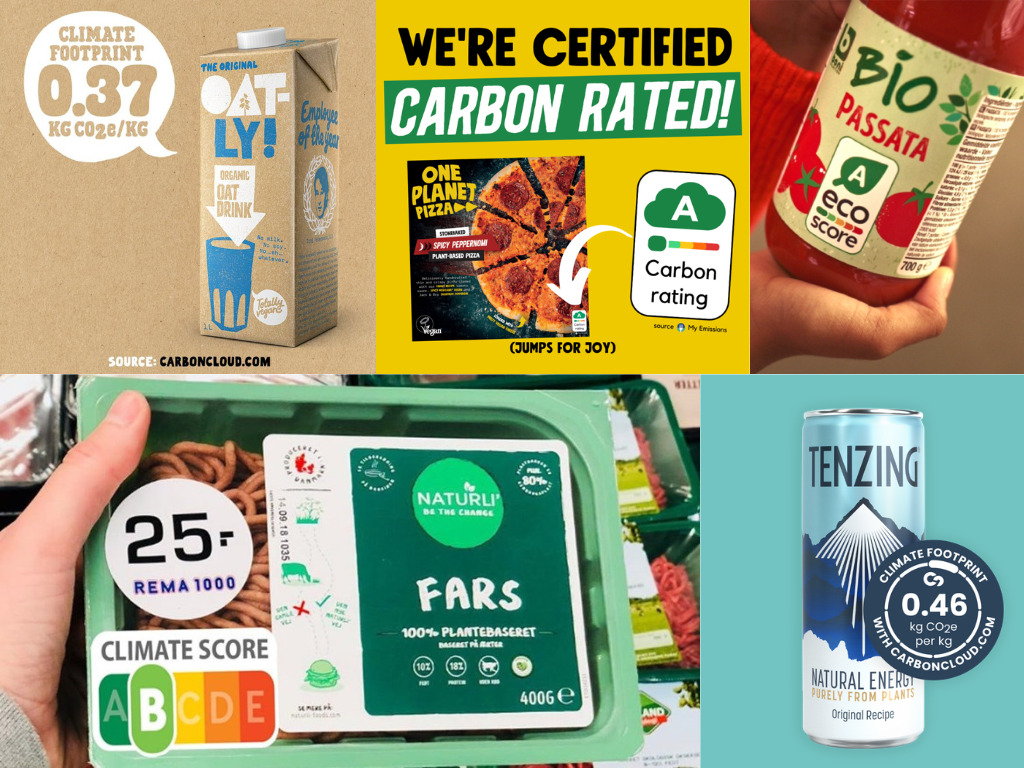
Companies like Oatly, Allbirds, Tenzing, Innocent are actively responding to the demand for transparency by adopting Ecolabels. These actions are becoming the norm, especially among younger consumers. In 2024, we can anticipate seeing even more carbon labeling on shelves as brands continue to prioritize transparency.
Thanks to advanced technology and data analysis techniques like artificial intelligence, brands now access much larger and more detailed customer data. This enables the creation of hyper-personalized consumer experiences, making customers feel valued and understood.
76% of consumers prefer purchasing from brands that personalize user experiences. Brand satisfaction sees a notable 52% increase due to personalization, resulting in an average revenue boost of 10% to 15%. As the numbers clearly indicate, personalization emerges as a highly effective strategy to enhance satisfaction, foster customer loyalty, drive sales growth, gain a competitive advantage, and improve overall brand image.
All the signs point toward a future where hyper-personalization becomes omnipresent. Most of the love brands have already embraced hyper-personalization in their marketing strategies. Therefore, it is crucial for brands to think about how they can outperform competitors and stand out in a competitive market.
Spotify is a perfect example of how a brand can leverage hyper-personalization. Introduced in 2015, “Spotify Wrapped” rapidly evolved into a yearly social media phenomenon. This strategy not only enhances customer loyalty but also significantly boosts brand visibility. The #SpotifyWrapped hashtag has amassed 72.2 billion views on TikTok. Moreover, in the last quarter of 2023, Spotify introduced “Daylist”, an AI-powered playlist that updates multiple times a day to align with the moods and activities of consumers. This continuous evolution highlights Spotify’s unwavering commitment to hyper-personalization, solidifying its position as an industry leader.
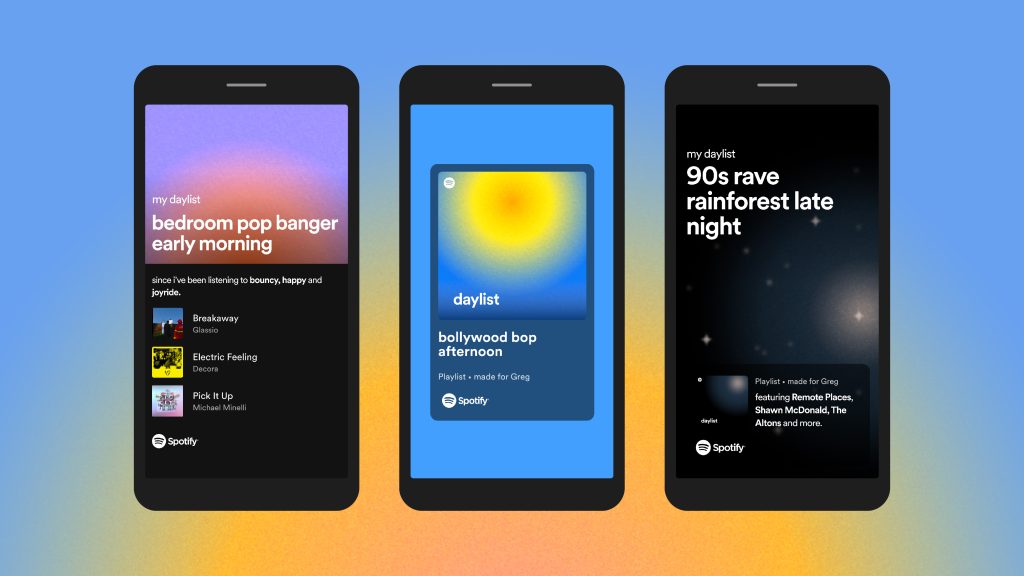
As there is a significant shift towards hyper-personalization, it is essential not to overlook the fact that today, we operate within a privacy-first marketing ecosystem. Zero-party data, referring to information willingly shared by customers with a brand regarding their intentions and preferences, plays a pivotal role in this system. It fosters greater trust with customers, leading to better experiences for them. Therefore, in 2024, with hyper-personalization continuing to surge, zero-party data will be indispensable for any brand’s marketing, personalization, and experience strategy.
Generation Z represents the future of consumers, with an estimated purchasing power of $44 billion. Brands seeking to connect with this generation must understand their tendencies, expectations, and needs.
For Gen Z, gaming isn’t merely entertainment; it’s a way of connecting with friends. Recognizing the potential of video games as a powerful medium to engage with the younger generation, brands are actively leveraging it.
For example, Fortnite stands out as one of the most popular video games among them. In a bid to raise awareness among the younger audience on the International Day of Indigenous Peoples, Fortnite, SOS Amazônia, and the Federation of the Huni Kuĩ People of Acre have partnered to launch “The Originary Map,” which challenges players to protect forests and indigenous peoples.
Throughout this year, a lot of brands, from organizations to luxury houses like Balenciaga, Cartier, and Hermès, have embraced gaming as a strategy to amplify visibility, foster engagement, and establish stronger connections with Generation Z. It is certain that gaming has a significant role to play in 2024.
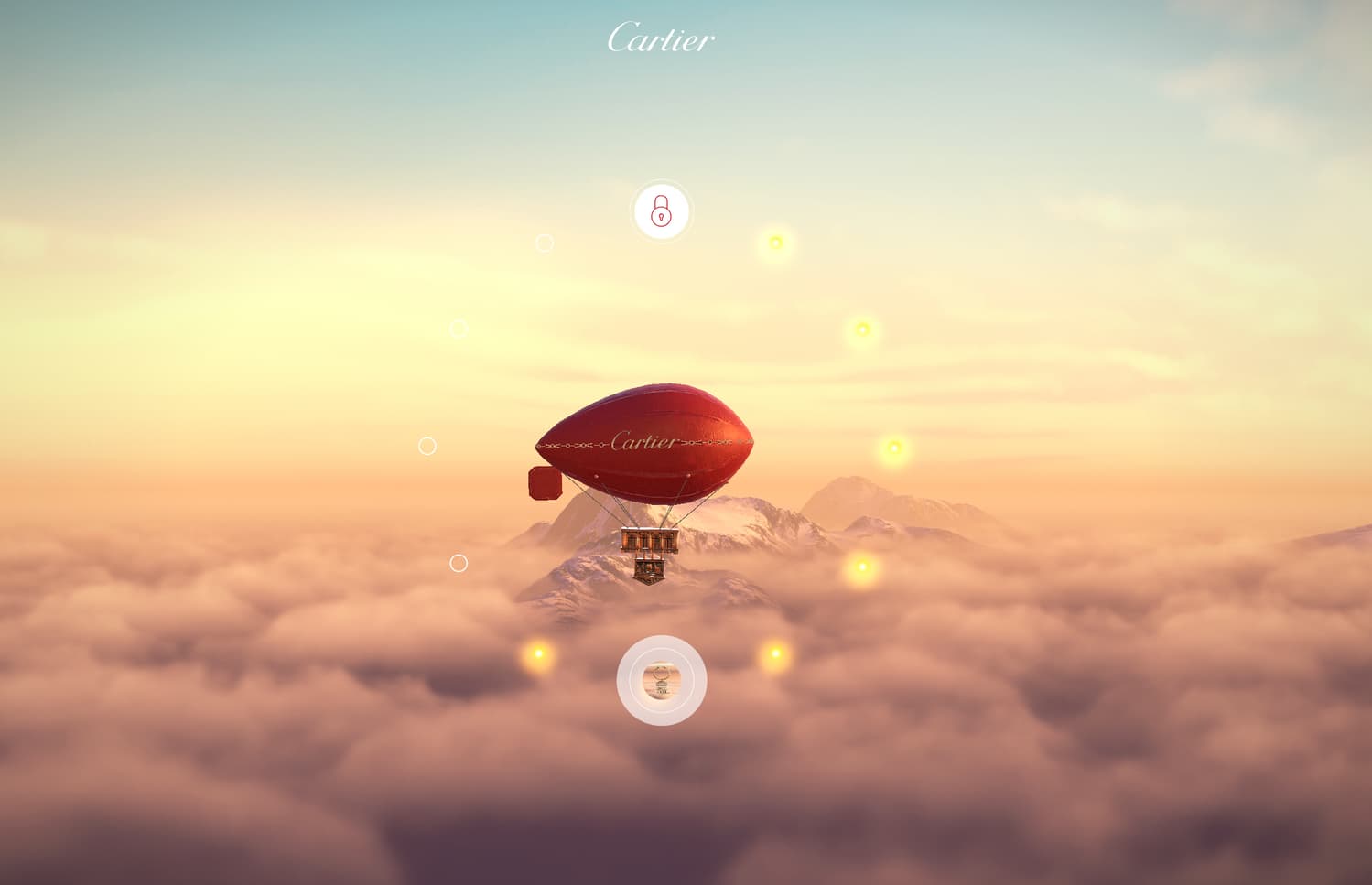
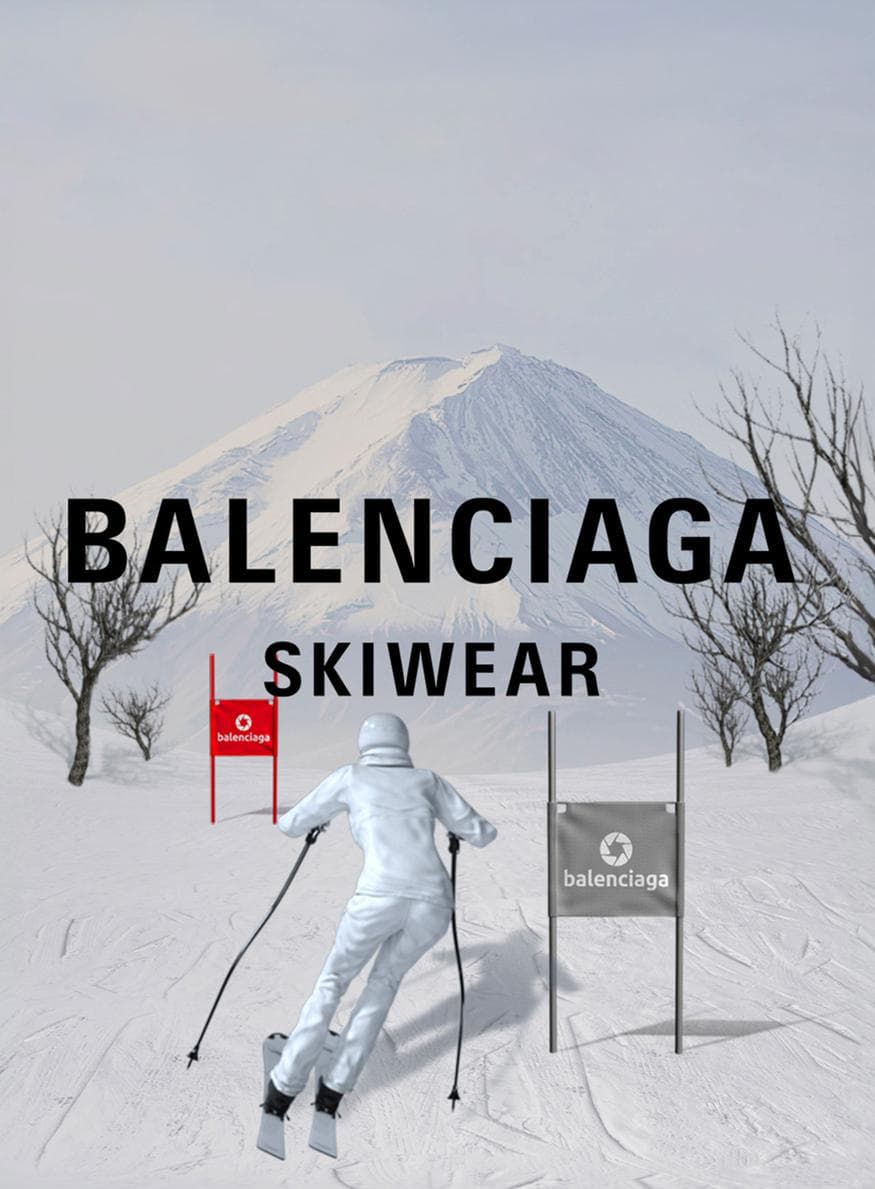
This year has truly been the year of artificial intelligence (AI), emerging as the central force driving innovation across diverse industries. The profound impact of AI on the creative industry cannot be overstated, as it reshapes the strategic thinking of companies and clients in their pursuit of efficiency and better results. While AI opens a new world of possibilities for the creative industry, it also prompts questions about the future landscape. As we look ahead to the trends of 2024, it is clear that the proliferation of generative AI will continue and solidify its position as a transformative force.
In a world characterized by perpetual change, the ability to distinguish fleeting fads from enduring trends is more crucial than ever. For that, we are more than pleased to announce that the third edition of “Useful Design Trends”, our annual exploration of the movements shaping the future of design across a multitude of industries and global markets, will soon be released.
For brands, Christmas transcends the simple calendar. It’s much more than a period of vacations and festive celebrations; it’s a valuable strategic opportunity. This festive period represents a key moment in the year when brands can not only capitalize on the natural increase in spending on gifts and festivities, but also forge lasting emotional connections with their consumers by creating campaigns imbued with tradition, warmth and sharing, representative of their values. Festive spirit advertising and campaigns seek to create memorable, positive brand memories.
But how do brands really integrate Christmas into their strategy? How does the integration of Christmas into brand strategy contribute to strengthening the brand experience with consumers? Is it mainly focused on creating a festive atmosphere, or on encouraging purchase? Let’s explore!
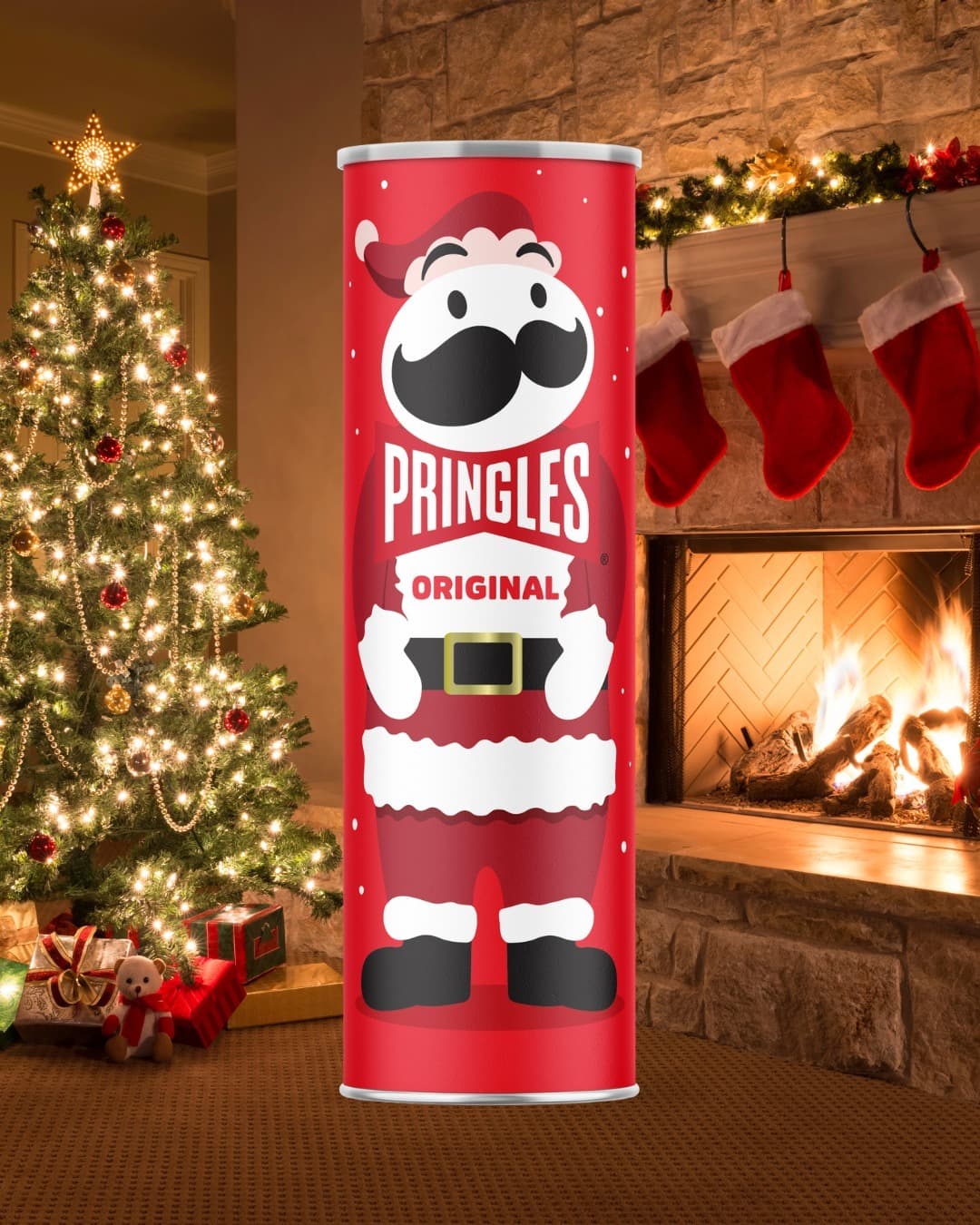

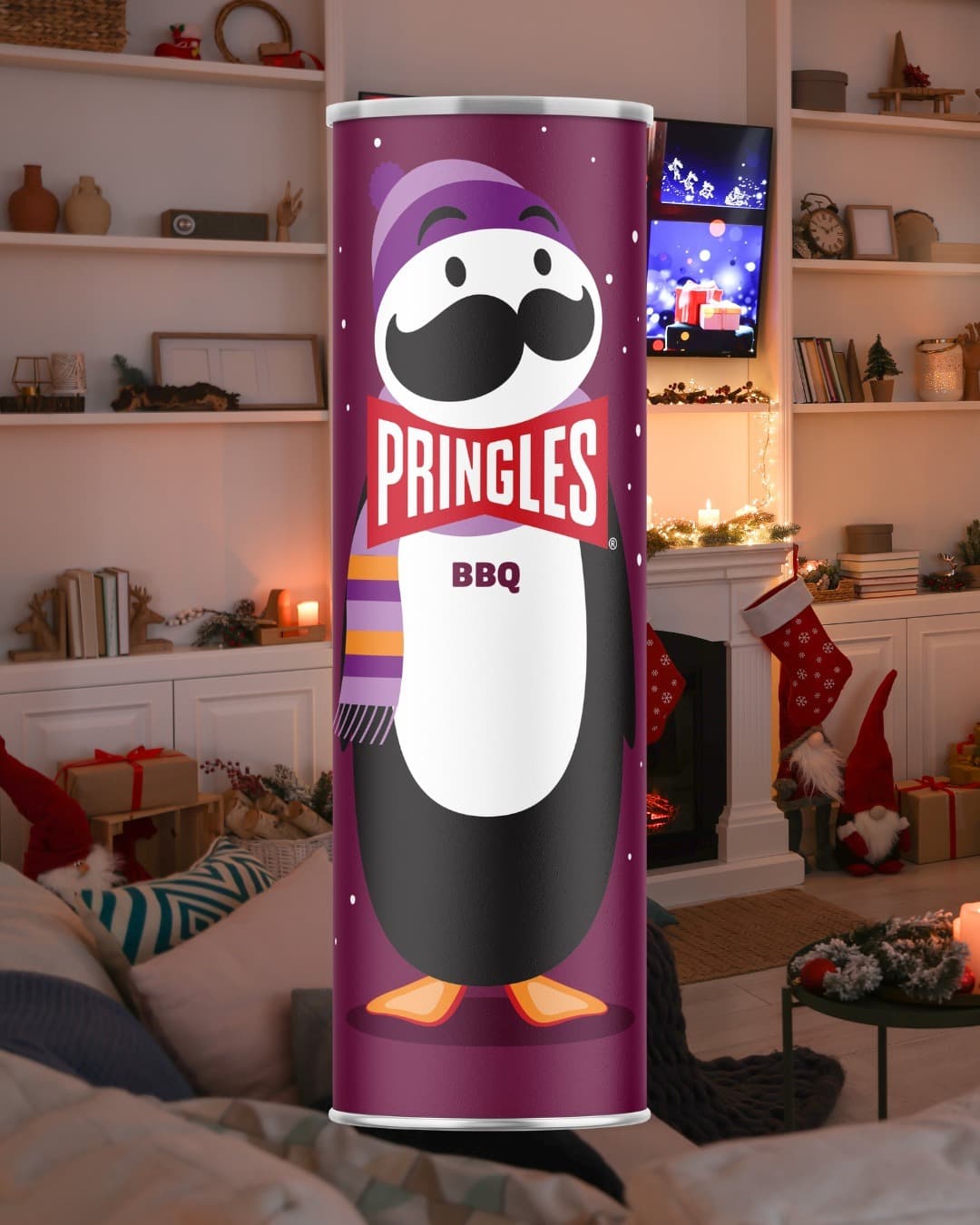
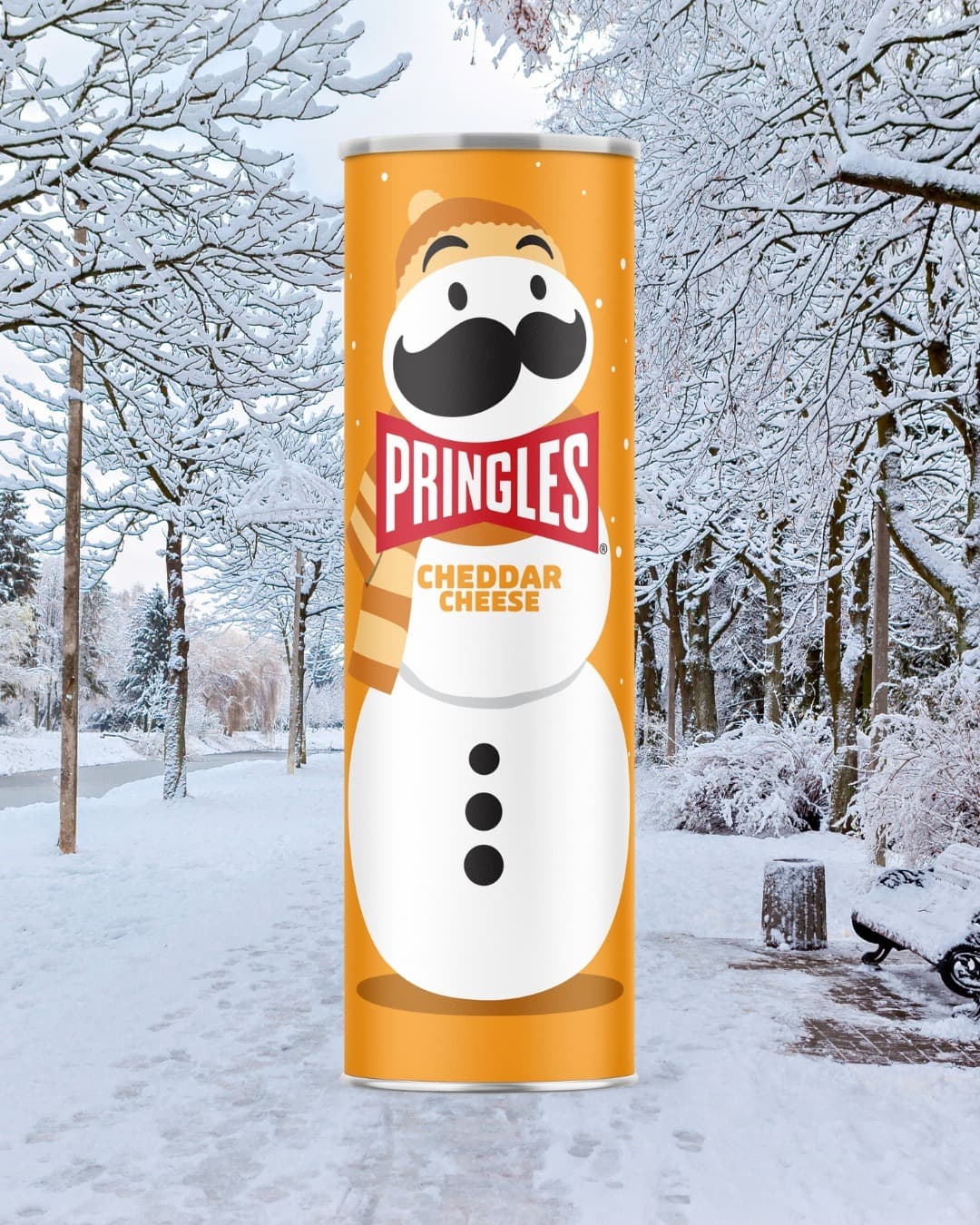
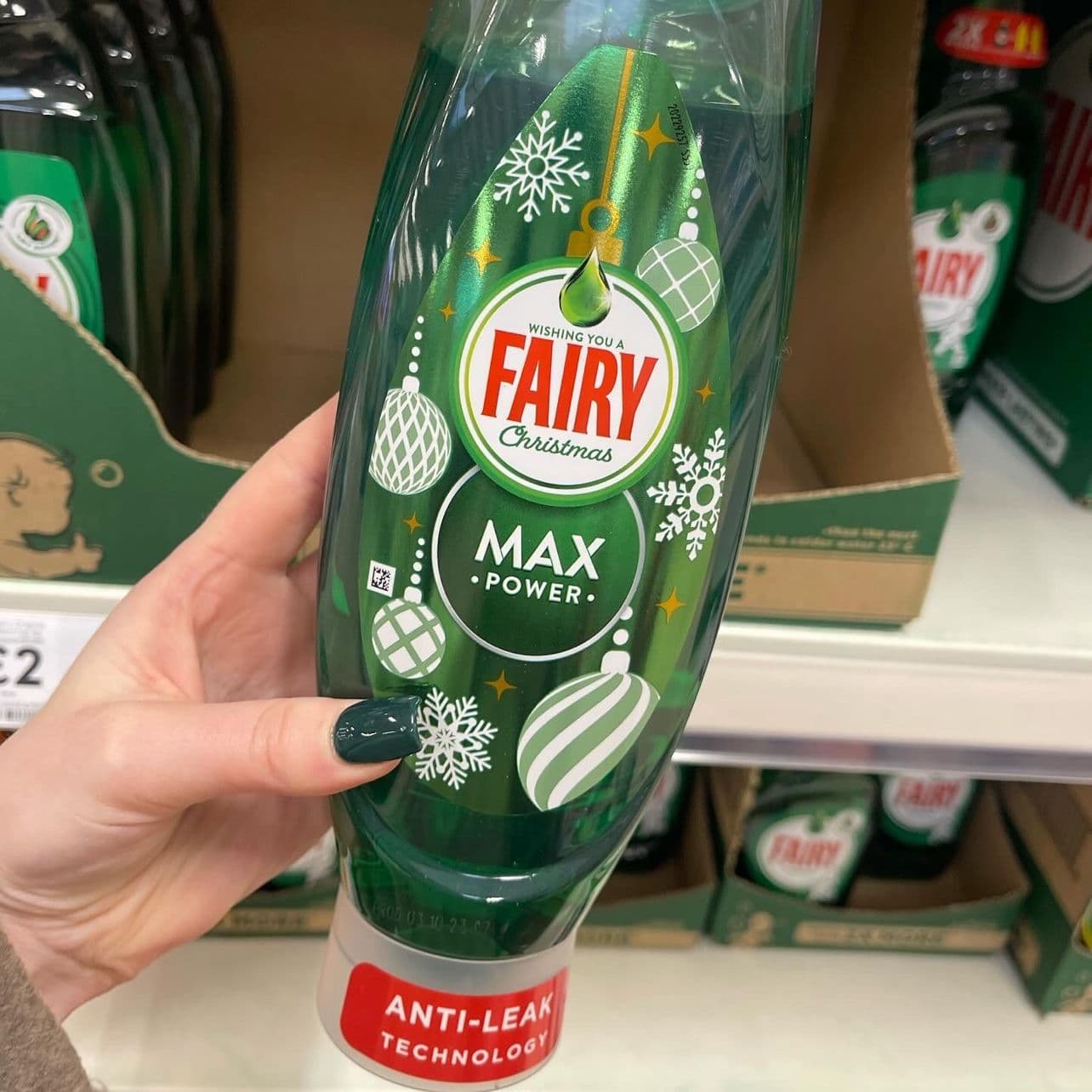
The ode to celebration can also be expressed through a modern, elegant identity. Such is the case with the packaging created in collaboration between Chivas XV Festive Series and CBA Design. It combines phosphorescent rowolis motifs with vibrant colors, symbolizing festive flames. The explosion of colors and flavors marks the excitement of the approaching festive season.
The Christmas experience can also be enjoyed in-store. Many stores decorate their shelves or storefronts for the festive season. And remember how some people love to store at Christmas time for the simple pleasure of listening to Christmas playlists over and over again (yes, Mariah, we love you!). Some retailers even take the experience a step further. Every year at Christmas time, Aldi consumers are reunited with Kevin the Carrot, the store’s emblematic mascot, through brand-new advertising. This year, the brand decided to go all out, dressing up their kiosks with their Christmas mascot. There’s no better way to immerse yourself in the Natale atmosphere as soon as you enter the store. And not just at the entrance! As you move through the aisles, you’ll find Kevin the Carrot plush toys for sale. In this way, Aldi achieves its brand awareness objective by involving the consumer throughout the entire journey, from Christmas advertising to social media engagement to in-store promotions. A successful experience!
Technology is also an asset exploited by some retailers during the Christmas season. This is the case for Orange, which is deploying an augmented reality device in its points of sale. This initiative aims to make the in-store experience lively, connected and social, with the use of a Snapcode to enable customers to discover this unique device. Videos on social networks encourage the public to visit the stores, and sponsored lenses on Snapchat offer an augmented reality experience, integrated into the point-of-sale scenography and customer experience. Orange is adopting this “phygital” concept, combining the digital and the physical, to create memorable in-store events and boost traffic at the point of sale during the Christmas period, with suggested gift ideas and prizes to be won.
This is also the case for the John Lewis department store chain, which every year airs its traditional Christmas advert. This year, the brand featured a carnivorous plant that turned out to be much more touching than you might think, offering tenderly joyful emotions to its consumers.
Numerous other strategies can be implemented for Christmas, such as the launch of special limited-edition products, like new flavors for candle brands, for example, or corporate gifts, special benefits to thank customers for their loyalty, and so on.
It’s a time when they can become an integral part of family traditions, establish strong bonds with customers and build long-term loyalty. It’s a time when brands transform their commercial image into a source of warmth, magic and emotion, making Christmas a crucial season in the marketing landscape. And let’s not forget, a successful marketing strategy is all about creating a human connection by leveraging the brand experience. During the Christmas season, brands don’t just sell a product; they offer a dream, an emotion. By enabling consumers to see, feel and dream, they’re not simply making a transaction; on the contrary, they’re establishing a lasting, meaningful relationship with them.
Subscribe and receive CBA’s latest news directly in your inbox!
Privacy Overview
| Cookie | Duration | Description |
|---|---|---|
| cookielawinfo-checbox-analytics | 11 months | This cookie is set by GDPR Cookie Consent plugin. The cookie is used to store the user consent for the cookies in the category "Analytics". |
| cookielawinfo-checbox-functional | 11 months | The cookie is set by GDPR cookie consent to record the user consent for the cookies in the category "Functional". |
| cookielawinfo-checbox-others | 11 months | This cookie is set by GDPR Cookie Consent plugin. The cookie is used to store the user consent for the cookies in the category "Other. |
| cookielawinfo-checkbox-advertisement | 1 year | The cookie is set by GDPR cookie consent to record the user consent for the cookies in the category "Advertisement". |
| cookielawinfo-checkbox-necessary | 11 months | This cookie is set by GDPR Cookie Consent plugin. The cookies is used to store the user consent for the cookies in the category "Necessary". |
| cookielawinfo-checkbox-performance | 11 months | This cookie is set by GDPR Cookie Consent plugin. The cookie is used to store the user consent for the cookies in the category "Performance". |
| viewed_cookie_policy | 11 months | The cookie is set by the GDPR Cookie Consent plugin and is used to store whether or not user has consented to the use of cookies. It does not store any personal data. |
| Cookie | Duration | Description |
|---|---|---|
| aka_debug | This cookie is set by the provider Vimeo.This cookie is essential for the website to play video functionality. The cookie collects statistical information like how many times the video is displayed and what settings are used for playback. | |
| player | 1 year | This cookie is used by Vimeo. This cookie is used to save the user's preferences when playing embedded videos from Vimeo. |
| pll_language | 1 year | This cookie is set by Polylang plugin for WordPress powered websites. The cookie stores the language code of the last browsed page. |
| Cookie | Duration | Description |
|---|---|---|
| _gat | 1 minute | This cookies is installed by Google Universal Analytics to throttle the request rate to limit the colllection of data on high traffic sites. |
| YSC | session | This cookies is set by Youtube and is used to track the views of embedded videos. |
| Cookie | Duration | Description |
|---|---|---|
| _ga | 2 years | This cookie is installed by Google Analytics. The cookie is used to calculate visitor, session, campaign data and keep track of site usage for the site's analytics report. The cookies store information anonymously and assign a randomly generated number to identify unique visitors. |
| _gid | 1 day | This cookie is installed by Google Analytics. The cookie is used to store information of how visitors use a website and helps in creating an analytics report of how the website is doing. The data collected including the number visitors, the source where they have come from, and the pages visted in an anonymous form. |
| vuid | 1 years | This domain of this cookie is owned by Vimeo. This cookie is used by vimeo to collect tracking information. It sets a unique ID to embed videos to the website. |
| Cookie | Duration | Description |
|---|---|---|
| IDE | 1 year 24 days | Used by Google DoubleClick and stores information about how the user uses the website and any other advertisement before visiting the website. This is used to present users with ads that are relevant to them according to the user profile. |
| test_cookie | 15 minutes | This cookie is set by doubleclick.net. The purpose of the cookie is to determine if the user's browser supports cookies. |
| VISITOR_INFO1_LIVE | 5 months 27 days | This cookie is set by Youtube. Used to track the information of the embedded YouTube videos on a website. |
| Cookie | Duration | Description |
|---|---|---|
| CONSENT | 3 years | No description |